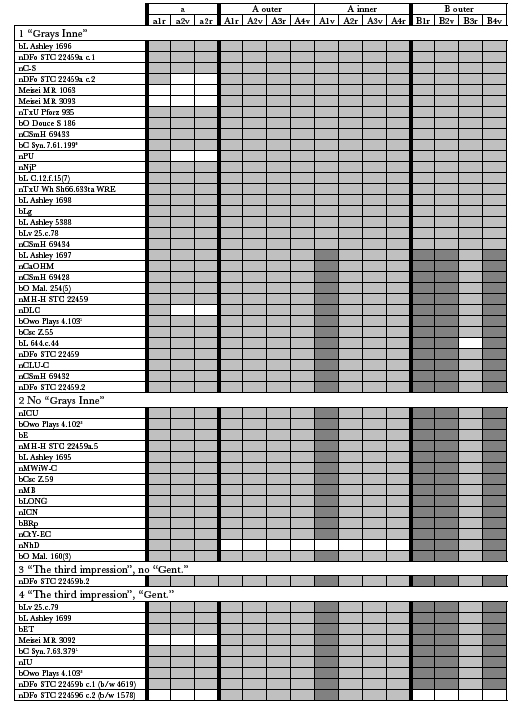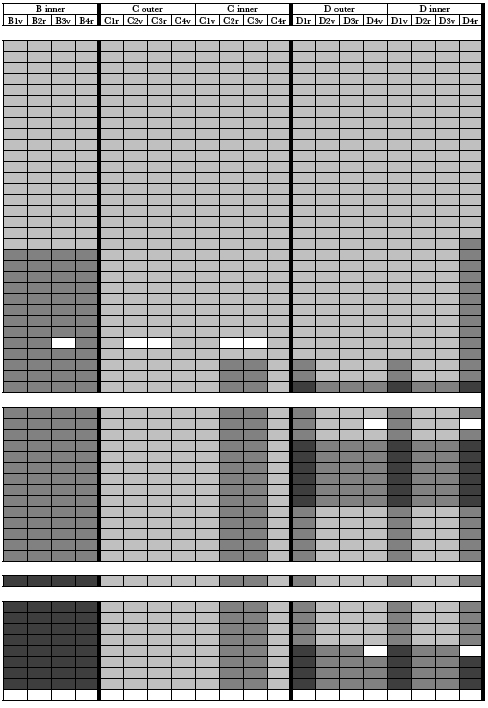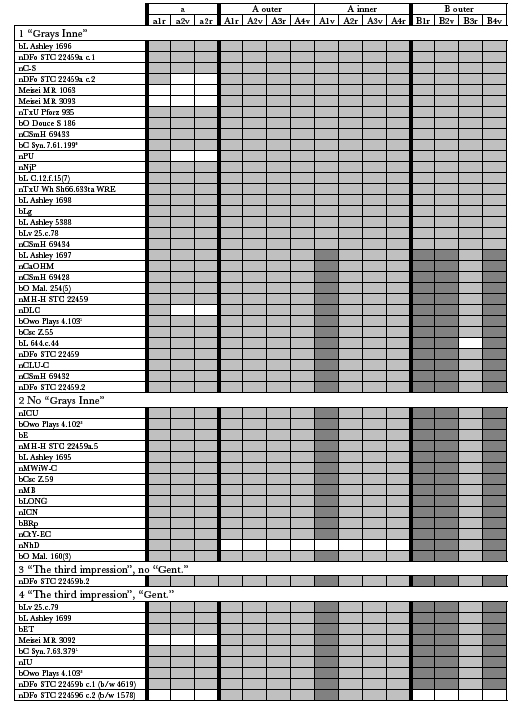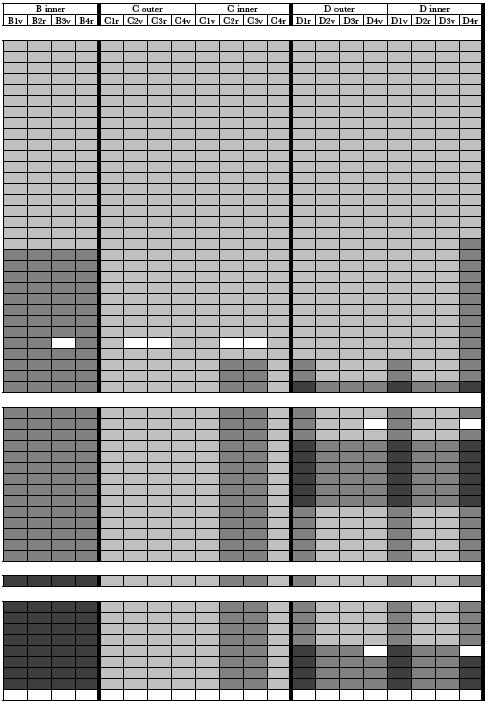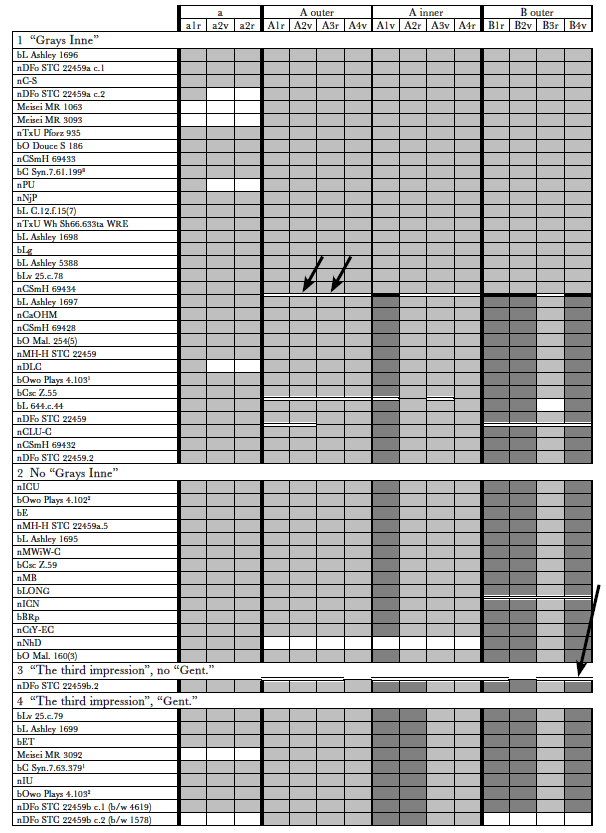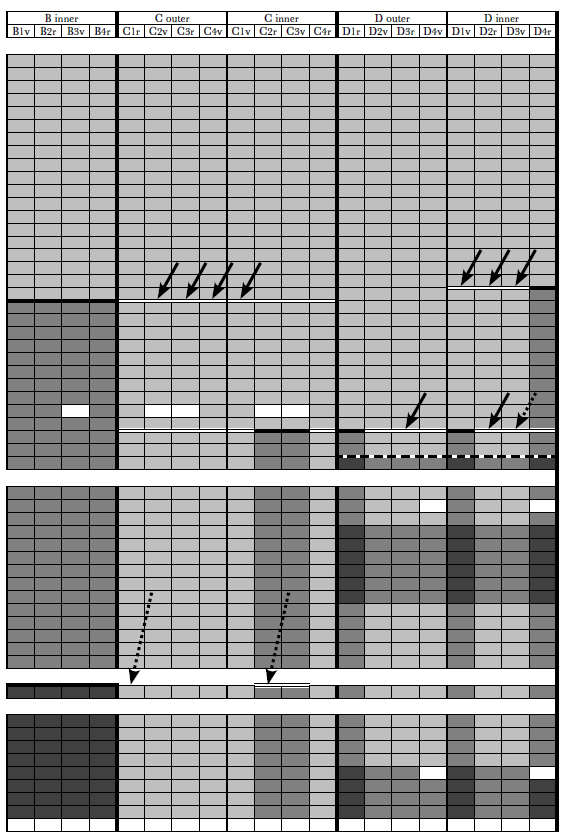| JAMES SHIRLEY'S TRIUMPH OF PEACE:
ANALYZING GREG'S NIGHTMARE
by
STEPHEN TABOR
| ||

JAMES SHIRLEY'S TRIUMPH OF PEACE:
ANALYZING GREG'S NIGHTMARE
by
STEPHEN TABOR
THE surviving exemplars of James
Shirley's
Triumph of Peace (London,
1633/4)
have defeated the attempts of generations of bibliographers to
classify
them. Any two copies are likely to show some pages with identical
typesettings,
some with partly different settings, and some entirely different. The
title page
comes in four variants of authorship and edition statements (fig. 1):
- By James Shirley, of Grayes Inne, Gent.
- By James Shirley, Gent.
- By James Shirley, of Grayes-Inne, The third Impression.
- By James Shirley, of Grayes-Inne, Gent. The third Impression.
These states have an obscure connection with the text pages that follow, whose
dozens
of permutations require one to specify the state of each page in or-
der to fully
characterize a copy. The normal hand-press taxonomy of edition,
impression, issue, and
state is inadequate to sort the copies into well-behaved
families.
As convoluted as The Triumph of Peace (henceforth "ToP") may be, part of the
reason for bibliographers' difficulty
in coming to grips with it was the unavail-
ability, until the 1960s, of
a technology that could supply quick and cheap repro-
ductions of complete copies for
thorough comparison. W. W. Greg, who came
closer than anyone to understanding the
book, died in 1959, the year the Xerox
machine was introduced. (He would
have had to wait another half-century for
the silent invasion of library reading rooms
by digital cameras and smartphones.)
In 1946, he published a paper
entitled "The Triumph of Peace: A
Bibliographer's
Nightmare".
1
His
chief purpose there was to point out inconsistencies in the
account of the work by
William Jackson and Emma Unger in the Pforzheimer
catalogue published several years
earlier.
2
However, he concluded that "a
final
solution will have to wait till a bibliographer equipped with the necessary
skill
and patience finds the leisure and the opportunity to make a thorough scrutiny
of
all available copies."
3
The
descriptions of ToP that Greg published five years later
in his
Bibliography of the English Printed Drama to the Restoration
showed no further

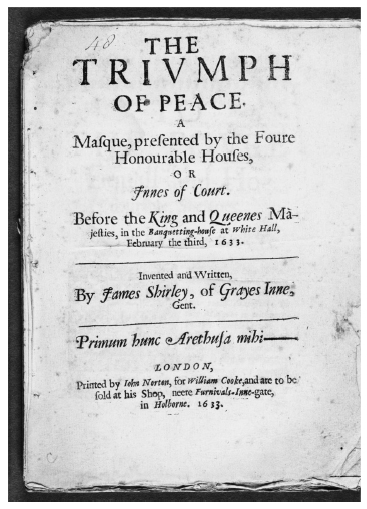
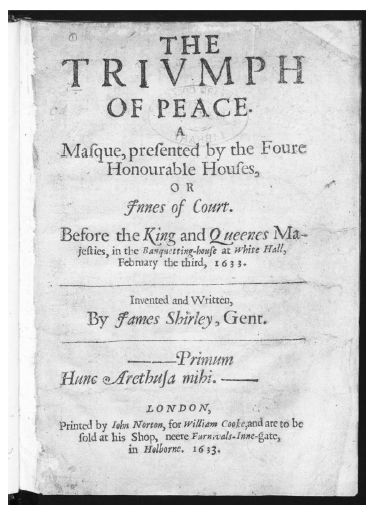

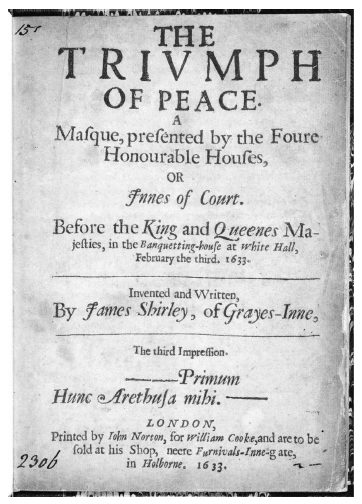
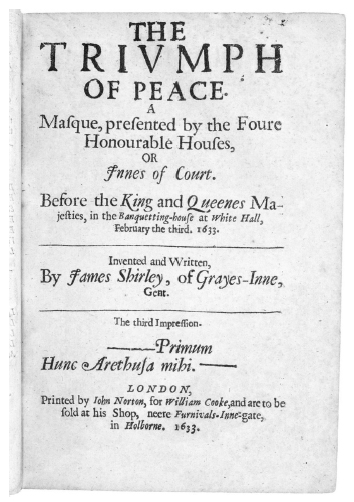

text settings were printed more or less simultaneously in expectation of heavy
demand, and that the resulting quires were indiscriminately combined in copies
with title pages 1 and 2. 5 We shall see that both of these conclusions were wrong,
but my purpose here is not to analyze the achievements and errors of previous
investigators. 6 To get efficiently at the many problems that ToP poses, we need
to start with a clean slate.
The Triumph of Peace was a masque produced by the Inns of Court
for the
court of Charles I. It was conceived, fittingly, as
a peace offering. In 1633, William
Prynne, a
member of Lincoln's Inn, had published Histrio-mastix, a
puritanical
indictment of the theatre that, among a multitude of objections,
criticized women
for appearing on stage. Archbishop William Laud, looking for an
excuse to si-
lence Prynne, contrived to frame this as a personal attack on the Queen
Consort Henrietta Maria, who was known occasionally to breach
this barrier in private
performances. Prynne was famously hauled into Star Chamber for
sedition and
sentenced to have his ears cropped, among other penalties. But he had
dedicated his book to the Inns of Court, thus implicating his own professional
organization
in an act of lése majesté that, as both sides
realized, called for a display of contrition.
The barristers loosened their
purse-strings, and the masque they offered is chiefly
famous today—its bibliographical
complexities apart—for being the most lavish
production staged in England at least
until the Restoration. Performed on 3 Fe-
bruary 1634,
7
it commenced with a very public torchlight
procession from the Inns
of Court down Chancery Lane and the Strand to Whitehall. The
Venetian ambas-
sador reported home, "Their display at the palace with a numerous,
stately and

exciting the curiosity and applause of all the people ...". 8 The whole spectacle was
funneled into the Banqueting House for the private performance featuring sets by
Inigo Jones and music by William Lawes and Simon Ives. The result so pleased
the Queen that Charles requested a second performance, at further expense to the lawyers (or perhaps this was his real motive), ten days later at Merchant Taylors'
Hall. 9 This shift of venue entailed some hasty demolition and construction to clear
an approach for the royal couple, and residents along the parade route were re-
quired to mount torches on the front of their houses and provide security for the
whole night. The combined cost of the two performances came to very roughly
£20,000–at least $4 million today, by a conservative estimate. 10 Whatever the
literary merits of Shirley's text, the extravagance and unusually public aspect of
the productions created a heavy demand for the printed record, both within and
without the court. 11 The book of the masque bears witness to this demand;
the bibliographical evidence I present here will reveal a printing house running at full
tilt, distracted by other jobs and grasping for short-cuts.
The surviving financial accounts for the production of the masque record
payments to
a "Mr. Wakelye" (variously spelled), whom they call "the printer".
12
This was the publisher Thomas Walkley, who until at
least 1632 had a shop in
Britain's Burse, quite
close to the Inns of Court. By early 1634 he had moved
nearer to
Whitehall, but he seems to have retained his connections to the legal
community.
Walkley sub-contracted the actual printing of ToP to John Norton,
who had printed works by Jonson and Massinger for Walkley in the previous few
years. And he entrusted
the distribution of copies to William Cooke, who pub-
lished all six of James Shirley's plays issued in 1632–35 and many more
besides.
13
Cooke's shop at
Furnival's Inn Gate was a nexus of literary activity associated
with the Inns. Shirley himself lived near Gray's Inn, and on 17 January
1634–no
doubt as part of his compensation for writing The Triumph of Peace—he was ad-
mitted to honorary membership in the Inn as
"one of the valets of the chamber
of Queen Henrietta Maria,
'absque fine'".
14
Three of the four title-page states of

was very much an inside job, carried out by men with close ties to the Inns of
Court and their associated literary coteries.
The book that Norton produced is a quarto that collates a2 A-D4, with pagi-
nation [i-iv], 1–8, 21–24. The
first half-sheet bears the title (verso blank) and a
leaf of dedication by Shirley. Quire A describes the procession before the
per-
formance, and the decoration of the Banqueting Hall; quires B-D, with
their
own pagination sequence, contain the text of the masque. Four surviving
cop-
ies contain an additional singleton leaf of verse headed "A speech to the
King
and Queenes Maiesties, when they were pleased to honour the City with
their
presence, and gave a gracious command, the former tryumph should
attend
them." Its eighteen lines, delivered by a character called "Gen[ius].", allude
to
the masque's second performance on 13 February.
THREE PUZZLES
§1. Main Settings
Table 1 shows, in shades of gray, the distribution in surviving copies of
the
completely different settings of each page. The rows of the table correspond
to
the copies or reproductions I have examined, grouped by the four title-page
vari-
ants which are separated by the horizontal white bands. The columns
represent
the pages of each copy grouped by quire and forme. One can immediately
see
what perplexed the earlier bibliographers. Some settings persist throughout
the
print history: the outer formes of quires A and C, for instance, and even
the
title page (a1r), remain substantially the same with relatively minor
variants.
Other pages go through as many as three settings. Most of the new
settings do
not line up with changes on the title page. The concept of "edition"
as applied
to the whole book, and the normal role of the title page as the primary
taxo-
nomic organizer, go out the window here. So does any hope of dealing with
the
book quirewise, or even formewise. Only a page-by-page analysis will
allow
us to specify the relationships among copies.
As it happens, this patchwork of settings (taken in conjunction with the
vari-
ants they contain) works in our favor when we set out to put all the states,
from
major to minor, into chronological order. Let us take the example of quire
A
inner forme, where page A2r goes through two partial resettings, A1v gets
one
complete resetting, and the other two pages exhibit only stop-press
corrections.
In table 2, the heavy horizontal line separates the completely
different settings
of A1v, while the lighter lines separate partial resettings or
more minor altera-
tions. The relative positions of the lines between columns show
the points of
introduction of new states, either simultaneously with changes on
other pages or
independently from them. We have no immediate basis for deciding
the order
in which some of these occurred. However, since the forme is the basic
unit of
printing, these four pages must all live their lives in the same
direction: a prov-
able sequence of variants on one page imposes an obligation on
the sequences
of the others.

A4r, in its single setting, shows progressive improvement in spelling
and
punctuation. In the first wave of correction, "sharpe sited" becomes
"sharpe
sighted" and "Caduseus" becomes "Caduceus". In the next wave, the addition
of
commas to a listing of architectural features helps to improve the sense. On
A3v,
the correction of "Arber-worke" to "Arbor-worke", occurring part-way
through
the second state of A4r, follows the same order. If we accept this
sequence of
states for these two pages, the other two (A1v and A2r) must follow
suit. There-
fore, setting 1 of both A1v and 2r does indeed come first, a fact
that we would
otherwise have difficulty proving. Setting 2 of A1v then goes
through two waves
of correction that lock partial resettings 2 and 3 of A2r into
order. When, some
twenty-five years ago, I began to sort through all of the states
of ToP, I was pleas-
antly surprised to find most of them
clicking into place pretty readily in this same
way. I have recorded the
rationales for the order of states in appendix 1, though
I would not encourage the
reader to venture into that thicket quite yet.
The important thing to note in table 1 (the table of editions of the whole
book)
is that there appears to be an orderly progression of settings of the
constitu-
ent sheets. The various settings of one quire do not mix randomly with
settings
of other quires. As the quire-breaks always fall at the same points in
the text in
all the states, copies could in theory have been assembled from sheets
of what-
ever combinations of settings were available at the gathering stage. The
lack of
random mixing implies discrete stages of production and collation, and
provides
one argument against the theory of simultaneous setting that has
prevailed until
now. Only the late states of quire D show a more promiscuous
behavior; I
will explain this in §8B.
The title-page variants, though seeming to dance to their own drummer, at
least
dance in the same direction as the variants in quires A-D. In the earliest
copies
of the title (fig. 1[A]), the "O" in "OF" in line 3 is sound. A small
accident
soon dents the top of the O, and this damaged type persists through all
of the
subsequent states. Reassuringly, the "third impression" title pages are
found only
in copies having the latest states of the text, and we can see that the
unique copy
of title 3, with its dangling comma after "Grayes-Inne", is just an
uncorrected
version of title 4. Quire "a", therefore, shows a rational order of
variants that also
tracks the evolution of the other quires, even if the
title-page changes are out of
phase with those of the text pages.
Although, after we become familiar with table 1, we discern some
comforting
regularities, we are left with the question of why some pages were
reset and others
were not. The mystery deepens when we look more closely at the
pages which
retain at least 50% of their original settings. TOP shows the normal pattern of
stop-press corrections found in most books
of the hand-press period. But we also
encounter two phenomena which are unusual:
(1) pages on which only the page
number is reset, where no correction was
required, and (2) pages on which blocks
of text in a particular type style
(usually italic) are reset—again with no substan-
tive changes to the
reading—while the other portions remain untouched.
The seemingly capricious page-number resettings turn out to be a powerful
tool
for reconstructing the sequence of events in John Norton's shop during
the
printing of ToP. Once we understand what motivated
them, we will be in a better



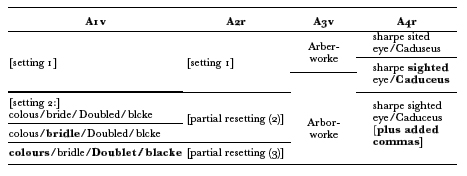 |
position to interpret the equally puzzling replacement of blocks of text on
some
pages.
§2. Headlines
ToP contains no running titles. Except for the words "The
Epistle" on a2v,
the headlines consist of simple page numbers within
parentheses—three or four
types plus spacers. Figure 2 shows two states of a page
(C1r) in which the headline
has been reset. This is not just a spacing shift—all
three printing characters are
different types. But the setting below is unchanged,
and even the direction lines
are unaltered (both contain the catchword "An_" with a dropped hyphen). On
some other pages, both the
numbers and the direction lines show resetting—
for example B3r in Houghton STC
22459 as compared with the same page in
Houghton STC 22459a.5. Still others have
page-number resettings in conjunc-
tion with stop-press corrections. On A1v,
Bodleian Mal. 160(3) has three errors
that are corrected in National Art Library
25.c.79.
15
The priority seems
clear.
However, along with the corrections comes a reset page number: originally
well
printed, the "2" in the apparently later state is badly damaged and the left
pa-
renthesis prints much thinner than the right. The nature of the damage to
the
numeral makes it unlikely that we are looking at the same unhappy type,
and
the parentheses are also clear substitutions. In the act of improving the
text, the
printer seems for no discernible reason to have swapped out a good page
number and substituted a bad one.
Finally, a new headline always appears in those cases (mentioned in the
pre-
vious section and discussed more fully in the next) where selected blocks of
text
are reset seemingly without need. Headlines are reset even when they are
not
adjacent to the reset text. Huntington copies 69434 and 69428, for
instance,
show this phenomenon on C2v.
Most of these headline replacements also entail a reset direction line,
though
the latter can be difficult to detect. Of the two features, I have found
the page
numbers to be a clearer first indicator that something unusual is going
on, for

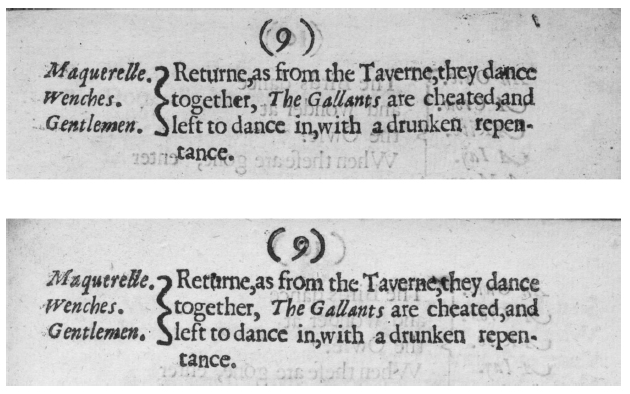
way twice; their horizontal alignment with the first line of text is variable; and
the numbers and parentheses in Norton's type-cases contain a variety of forms
and damaged sorts that make substitution easy to detect.
The page-number changes in ToP are so clearly without purpose
that they
must have been unintended consequences of other operations. We can
explore
their patterns by modifying table 1 to show where the substitutions occur.
In table
3, the double horizontal lines indicate page-number changes.
16
These obviously
occur also at the
points where whole pages are reset (still shown by changing
shades of gray), but
others divide the main settings into smaller groups. A reset
number on one page
usually accompanies a similar operation on its forme-mates,
and the table shows
corresponding fault-lines that often break out of individual
formes into whole
quires and even to the other sheets. The initial impression of
chaos in table 1
begins to yield to a pattern that is more complex, but also more orderly.
The page numbers in ToP belong to an element common to most
books
of the hand-press period called the skeleton forme. This consisted of
non-printing
material such as the furniture that held the pages in a set layout on
the press
bed, but it also included the headlines and direction lines. The latter
contained



So, the skeletons tended to get re-used, with changes to the visible type as needed,
in successive formes as an edition went through the press. When a forme was
finished printing, the units of the skeleton were normally separated from the type-
pages and used in another forme, while the stripped pages went back to the type
cases for distribution. 17 After the edition was finished, the type of the skeletons
would go down the same path.
It was entirely possible to do multiple printings of a short book using the
same
setting of type. In such a scenario, the type-pages, after their first
printing, would
be tied up with string, with or without their skeletons, for an
arbitrary period,
then reimposed and reprinted. This cycle could repeat itself as
many times as
needed. Printers commonly stripped the headlines and direction lines
when pages
were finished printing, but if the skeletons happened to remain with
their pages, a
reprint could easily escape detection even by a modern
bibliographer. Numerous
examples of reprinting from standing type, at least for
stretches of a few pages,
are documented from the early seventeenth century and
before,
18
and the prac-
tice
became rather common by the late eighteenth century. The reasons it was
not more
widespread in the 1630s were both practical and regulatory.
Between
1587 and 1637, an order of the Stationers'
Company set a limit of 1500 copies
on print runs from a single
setting.
19
If more copies were
wanted, a scrupulous
printer would have distributed the type and reset a new
edition from scratch.
This rule was intended to provide sufficient work for
journeyman compositors,
but it also made economic sense. Because hand-cast type
was expensive, a printer
would keep only limited amounts and would not want large
chunks of it tied up
and unusable for other jobs. Nevertheless, printers
interpreted the regulation
flexibly, and when faced with a sudden high demand for
a particular title they
were understandably tempted to exceed the limit.
20
If we encounter a book whose copies show only minor changes to the text
but two
entirely different settings of the running titles, we have a strong case
that the
edition went through two impressions. In the interval between them,
the skeletons
got distributed and had to be reset for the second run. This is
what I believe
happened repeatedly with The Triumph of Peace. I would contend

an interruption of work during which the whole forme was removed from the
press. The type-pages were set aside for a time and then received at least reset
page numbers, and usually new direction lines as well, in preparation for re-
impression. Some pages underwent a complete resetting during the interval, of
course including the skeleton. This is the explanation of the horizontal fractures
in table 3. It is even possible that some pages were stored with their skeletons
intact and went undetectably into later impressions. This could have occurred
with formes D(o) and A(i) at certain points in the printing history; it is tempting
to posit "silent" reimpositions that would bridge the discontinuous fault-lines in
table 3. We will explore this possibility when we go into the life-histories of the
individual quires.
I have ignored some anomalies in forme B(i) that will be
discussed in §6C. In late copies
of quire D, two settings occur
interchangeably; therefore it is not possible to diagram a clear
transition
from one to the other.
Curiously, Joseph Moxon does not
discuss this practice (Mechanick Exercises on the Whole
Art
of Printing, ed. Herbert Davis and Harry Carter. 2nd ed. London:
Oxford University Press,
1962); but the books themselves give
frequent evidence of it.
A search in ESTC for note-word "reimposed" will turn up some of
these (e.g., S92876
(1583) and S125309 (1572?). See
also Greg, English Printed Drama, entries 28(b)
(1559), 75(b)
(l578), 202(b) (l604), 203(b)
(1604), 204(b,c) (1604–05), 217(b) (l605), 230(b)
(l606), 295(b)
(1611), 296(d) (1635), 412(b)
(1625), and L18(AII) (1641?). Another probable example
is Greg
466, explored by J. Caitlin Finlayson> in
"Thomas Heywood's
Londini Artium & Scientiarum Sca-
turigo
(1632): The Huntington and Worcester Copies—Two Issues or Variant
States?" (Papers
of the Bibliographical Society of America
, 108.3 [Sept. 2014], 325–341).
A Transcript of the Registers of the Company
of Stationers of London; 1554–1640
(ed. Ed-
ward Arber). London: Privately printed, 1875–94, 2: 43. The article
limiting edition sizes was
approved on 4 December 1587 (W. W.
Greg, A Companion to Arber. Oxford: Clarendon
Press,
1967, p. 43).
§3. Italic Raids
Figure 3 shows a sort of mutation frequently found in ToP: the
entire song
(composed in italic type) has been reset, but not the passages in
roman above.
Note that short stretches of italic embedded in roman text remain
unchanged.
Eleven pages in ToP show this localized
resetting of italic at some point in the
printing history, and one of them (D2r)
has part of the italic reset yet again. Two
pages (including one that previously
had the italic changed) also show an arbi-
trary change-out of some of the roman type.
Table 4 shows where these resettings occur. (Solid arrows indicate replace-
ment
of italic type, dashed arrows the replacement of roman.) All of them, except
for
the roman replacement on C1r, occur at points in the production cycle where
the
numbers in the headlines were also reset—in other words, during the pauses
between
impressions that we have already identified. Table 5 presents the history
in
another way. (It contains codes for production phases and variant states which
I
will discuss later.) This table shows all the pages of ToP that
contain concentra-
tions of italic. A great deal of that type is used for the
songs that cluster toward
the end of the masque.
The local resettings do not always draw on the same font. In the earliest
states
of ToP, all the text—both roman and italic—is set in
"english" size (20 lines =
96 mm). In the first wave of changes, the italic Song 5
on C4V reappears in pica
size (82 mm). During the same transition, four lines of
italic stage direction on
A2v-3r switch to a 120 mm great primer. Pages C3v and
D3r are a more subtle
case: the reset songs are still in 96 mm italic, but the
font is of a different design,
which I will call i-2 as opposed to the more
prevalent i-1. The differences are
hard to describe, but we can compare the two in
figure 3. The page on the left
features Norton's regular english italic i-1, while
that on the right shows the song
reset in i-2—a less attractive face, smaller on
the body and also (in its ToP out-
ing) badly worn. The
most diagnostic feature of i-2 is the h, whose legs
nearly
close at the bottom, so that the letter resembles a b. In its i-1 cutting, the right
leg only begins to close.
None of these partial resettings result in substantive textual changes. Like
the
page-number resettings, they bear the marks not of perfectionism but rather of

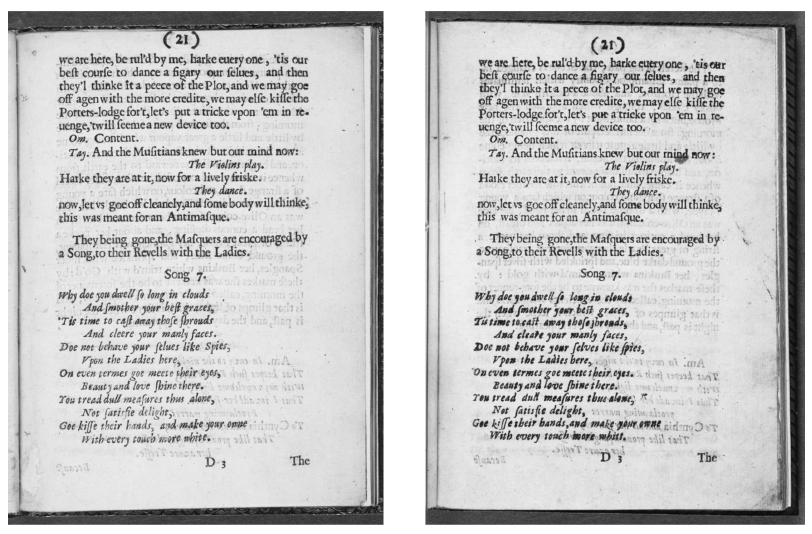

and recourse to alternative, wrongly-sized, and sometimes inferior fonts strongly
suggest that they were a response to a shortage of type, that Norton was juggling
other jobs, and that ToP had to stand aside—even sacrifice some of its stand-
ing type—to let those jobs "play through". I therefore refer to these incidents
of localized distribution as "raids", which created holes in the composition that
Norton refilled once the more pressing need was past.
In §9, I will show that some of the italic distributed in the first raid ended
up
in ToP itself, in the two pages of dedication (leaf a2).
As part of the preliminaries,
these pages would have been printed after the main
text if Norton was following
the usual practice. Once the dedication was set, on
the other hand, it remained
substantially unchanged through the remainder of ToP s printing history. Norton
was able to muster enough
italic to restore the raided pages, though he some-
times patched the holes with a
mis-matched font. The first wave of raids liberated
about 2130 ens of italic, but
the preliminary quire of ToP contains only 42% of
that,
about 900 ens. Distributing more than twice the amount of needed type
might have
been a prudent action to ensure an adequate supply of all the sorts.
If there was
another job or jobs that prompted the italic raids, I have not been
able to
identify them. The candidates would obviously contain large amounts of
Norton's
english italic (96 mm). This was a slightly unusual size for standard text;
the
smaller pica served as the workhorse. In his books dated 1633–34,
Norton
used english-sized italic mostly for matter subsidiary to the main
texts—prelim-
inaries and indexes. The most extended stretch of it comes in the
twelve-page
index of Richard Verstegan's
Restitution of Decayed Intelligence (STC 21363),
dated
1634. It contains double columns of short lines of italic
with a heavy admixture of
roman. Its requirements hardly seem enough to stretch
the resources of a print-
ing house responsible for nearly thirty known jobs, or
parts thereof, during the
two-year span with ToP at its
center. It may be safest to hypothesize that Norton
was doing some job work now
vanished, maybe longer than a single sheet, greedy
for a larger size of italic
than usual, and urgent. The fact that the raids took place
at more than one point
in the ToP production suggests either several
ephemeral
jobs, or one larger project which for some reason has not survived.
In this section I have focused on localized resettings of italic passages in
re-
sponse to a need for type, but we need to bear in mind that any distribution of
type served to make it available for other jobs. We
will see instances throughout
the printing history of ToP
in which entire pages or formes were reset, with no
discernible pattern in which
pages were chosen. At the end of each printing
phase, Norton had three choices of
what to do with each type-page: (a) distribute
it, (b) keep the text standing and
strip the skeleton, or (c) keep the text stand-
ing with the skeleton intact. It
is quite possible that many of the resettings were
motivated by a need for more
roman type, and that the selection of pages was
driven by which type-pages were
accessible when the need arose.
It is now time to look at the variants in The Triumph of Peace
in detail. The
following sections, §4–8, are the densest
portion of this article and some readers
may find in them too much of a good
thing. Once we have dealt with the book
at the level of quire, forme, and
individual page, we will pull back to see how all



| Phase | A outer | B outer | C outer | C inner | D outer | D inner | ||||||||||||||||||
| A1r | A2v | A3r | A4v | B1r | B2v | B3r | B4v | C1r | C2v | C3r | C4v | C1v | C2r | C3v | C4r | D1r | D2v | D3r | D4v | D1v | D2r | D3v | D4r | |
| I | 1 | (1) | (1) | 1 | 1 | 1 | 1 | (1) | 1a | (1) | (1) | (1) | (1) | 1a | (1a) | (1a) | 1 | 1 | (1) | 1a2 | (1) | (1) | (1) | (1) |
| II | 2a | [2a] | [2a] | 2a | 2a | 2a | 2a | (2a) | 1b | [2a] | [2a] | [2a] | 2 | 1b | (1b) | (1b) | 1 | 1 | (1) | 1a2 | [2] | [2] | [2] | {2} |
| III | 2b | 2b | 2b | 2b | 2b | 2b | 2b | (2b,c) | 1c | 2b | 2b | 2b | 3 | 2 | {2} | 1c | 2 | 2 | [2] | 1b | 3 | [3] | 3 | 3 |
| IV | [3] | |||||||||||||||||||||||
[] = only italic reset
{} = entirely reset
of the changes fit into the production sequence of multiple printings. In §9–10,
I will demonstrate how recurring types give evidence of the order of printing
the formes; in §11–14, I will show how copies were assembled from the stock
of printed sheets on hand. Section 15 presents the entire workflow as a series
of specific actions, and §16 addresses basic issues like edition size and the time
required to print all the copies. The metamorphosis of the printed pages entails
a textual evolution in which deliberate revisions (mostly to the stage directions)
appear amid a chatter of accidentals generated by the resettings. I have reserved
a detailed account of these for the textual introduction to ToP in the upcoming
Oxford University Press edition of Shirley's works.
My method of organizing the variants is, I hope, as simple as the situa-
tion
allows, but it still needs a bit of explanation. The comprehensive catalogue
of
manifestations of all the pages, from complete resettings down to stop-
press
variants and even the occasional random shift, will be found as appendix 1. It
is
modeled on a biologist's taxonomic key, and as with all such keys the
identi-
fication marks are the minimum required to distinguish the states; seldom
are
all the variants on a page mentioned. During the first stages of organizing
this
list, I saw the need for some kind of shorthand to refer to each state of a
page.
Ideally the structure of this shorthand should express the hierarchical
relation-
ships of the states of each page, with the main settings at the top
level followed
by impositions at the next and stop-press variants at the bottom.
However, as
the families of variants continued to ramify—sometimes manifesting
states that
would not fit neatly into any hierarchy—practice sometimes overruled
theory,
and the codes ceased to reflect any rigid correspondence with production
phases
or the relative importance of the changes they denote. Attempting at this
point
to revise the codes to make them more consistent—to the extent that that
would
even be possible—would render precarious their connection with notes
taken
over two decades, which embody the current system in a well-documented
pro-
cess of evolution. For specification of the exact relationships between the
states,
the reader should refer to appendix 1.

DEVELOPMENT BY QUIRES
§4. Quire "a"
A. a1R (TITLE PAGE)
The four main states of the title page are shown in figure 1. A quick compari-
son
reveals that these states are largely in the same setting. Note, for instance,
the
damaged "M" in "Majesties", line 9, and the wrong-font final "3" in the
imprint
date, which is common to all states. It is relatively easy to demonstrate,
with a
purely typographic proof, that the order of states shown in figure 1 is also
the
order of printing. As mentioned in §1, the "O" in line 3 is sound (as
illustrated)
in some copies of state 1, but shows damage in others. Therefore, state
1 must
be the earliest. State 3 (a unique survival at the Folger), with its dangling
comma
after "Grayes-Inne", must precede state 4. One would assume that the
"third
impression" copies came last, and this is borne out by the association of
this state
with later states of quires A-D, as we shall see. If we play devil's
advocate and
posit an order of 1,3,4,2—moving the "third impression" forwards—we
would
not be able to explain why line 11 of the title ("February the third,
1633.") starts
in one setting in state 1, changes to another for
states 3 and 4, then reverts to the
original one in state 2. (The presence of a
comma or a period after "third" is the most obvious marker.) So, we can safely accept
the order as illustrated.
State 1 is further complicated by a deliberate realignment (state 1a2,
not
illustrated). Figure 1(A) shows the first word of the title sitting too far left
with
respect to the following line. During the printing of state 1, but after the
damage
to the "O" in line 3, the alignment was altered by shifting "THE" rightwards
so
that the "T" lay closer to the "V" below than to the "I". As a result, the
word
came to sit too far right on the page considered as a whole, but with respect
to
the following line, it is an improvement. No version of the title ever gets
each
line quite centered.

Table 6 shows the hierarchy of changes that we have just worked out. The
numbering
of the states refers to appendix 1. For the title, I have called the four
states 1a
(with three sub-variants), 1b, 1c1, and 1c2. The notation "1" recognizes
that all
are in the same basic setting and that the fourth is a stop-press variant
of the
third. The taxonomic key ignores other adjustments, even the resetting
of line 11,
that accompany the revisions signaled by the chosen markers. (A full
account of the
evolution of the ToP title page would provide enough material
for
a separate article.)
 |
The reason for the deletion of "of Grayes Inne" in state 1b, and its restoration
in
1c, is unclear. Shirley was admitted to honorary
membership in the Inn on 17Janu-
ary 1634. This was a common enough
practice for individuals who had rendered a
significant service, and it should not
have been controversial. Quite probably, Shirley
was led
to expect it as part of his compensation for writing the masque. He may have
allowed
the words to creep into the printer's copy in advance of the actual bestowal.
When
someone called attention to the error, the words were deleted, only to be re-
stored
(in a new setting, of course) in state 1c, which was evidently printed after
the
honor was official. Since there is no evidence that anyone tried to suppress
them in
earlier copies, the deletion could represent a minor adjustment for a minor
embar-
rassment. It could even have happened as a stop-press correction. This theory
would
have a corollary that the printing of at least state 1a was well underway or
completed
by the middle of January, and this would support Greg's assumption that
the pub-
lisher aimed to have copies ready for sale by the first performance of the
masque
on 3 February.
21
However,
the archival evidence and other facts I will adduce in
§16 argue against the book's
having been on sale that early. The disappearance and
reappearance of "of Grayes
Inne" is the first of many mysteries surrounding ToP that
I
will have to leave without a complete solution.
B. a2R
As with a1r, there was only one setting of this page. The following table shows
its
states along with those of the title page.

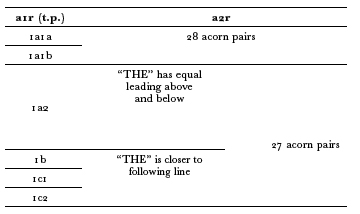 |
At the head of a2r is a decorative band composed of pairs of acorn orna-
ments. The
early state has 28 pairs of acorns, the later two have 27. It is nearly
impossible
to find individuality in acorn ornaments, but tiny differences show
that the change
results from resetting, not a loss of one pair on the end. The
reduction happens
simultaneously with a clear resetting of the direction line—
signature mark "a2" and the catchword—without a change of reading. There
being
no reason to reset the acorns and direction line in mid-run, it appears that
the
printing of a2r underwent a pause at this point during which the skeleton
(including
the acorns in this case) was replaced. Another arbitrary change oc-
curred later,
when the equal leading above and below line 5 of the heading (the
single word "THE")
was disturbed and that line drew closer to the one below.
The same operation
apparently dislodged a space two lines above, following the
words "Equall and", so
that copies printed thereafter show a gradual rightward
drift of those two
words.
C.a2v
Like the others in quire "a", this page has only one major setting (see table 8).
The first change to a2v is the stop-press correction of "ond" to "and". (The
error
was a simple one for either the typesetter or the previous distributor to
make—the
"o" box in the typecase lay just above the "a".) All copies of the un-
corrected
state also have the undamaged "O" on the title page (a1r:1a1a). After
the correction
to "and", further copies were printed before the "O" on the title
became damaged
(initiating state a1r:1a1b). The addition of the comma after
"Honourers" on a2v
occurs at the same point as the re-alignment of the first line
of the title page
(producing a1r:1a2). The copies with the "Third impression"
title page (starting at
a1r:1c) also show a resetting of the closing two lines of the
dedication on a2v,
with no difference in reading. This sort of arbitrary change
should remind us of the
headline resettings that, as I have argued, signal pauses

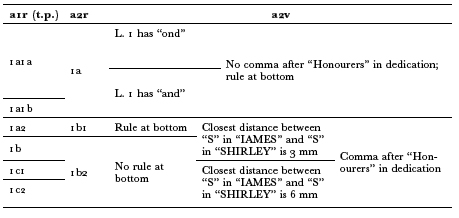 |
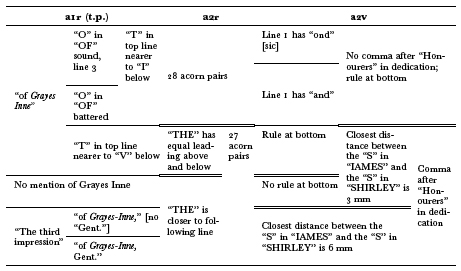 |
such indicator; it coincides with the disappearance of "of Grayes Inne" on the
title (a1r:1b). Shirley's signature to the dedication and the rule below it seem to
operate as part of a quasi-skeleton that is less stable than the text on which it borders.

D. QUIRE "a" ENCOMPASSED
Let us now combine in one sweep of the eye the states of the three
type-pages
comprising quire "a". Table 9 is a "plain English" version; table 10
shows the
variants using the shorthand keyed to appendix 1. In both tables I have
provi-
sionally placed double lines at the points of possible reimposition that I
have
discussed above, which seem to indicate breaks in the printing.
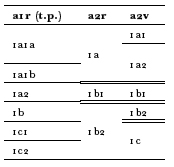 |
Note that the changes on all three pages tend to occur in lockstep. Quire
"a" is a
half-sheet, which would most economically be produced by half-sheet
imposition run
off by work-and-turn.
22
In this method,
all the pages of the quire
are printed at once, and the sheets are flipped
end-to-end and perfected with the
same pages on the back. When cut in half, each
sheet yields two copies of the
quire. If this were the case with ToP, and if one examined the type impression
in many copies, about half will
show that a2 recto was printed before the verso,
while the other half will show the
opposite sequence. I have attempted this exami-
nation on 23 copies of ToP—a difficult process because the outer leaves normally
show
most of the soiling and were usually washed and pressed at some point.
Only leaf a2
can be analyzed in this way because the title leaf verso is blank.
But the test did
show a mixture of sequences of printing, so we can be confident that
quire "a" was
printed by work-and-turn.
Because Norton used half-sheet imposition, all three type-pages of quire "a"
were
accessible to alteration at the same time. So, it is not remarkable to see
changes
taking place across all three pages simultaneously. The thing to note
at these
transitional points is the mixture of arbitrary revisions with apparently
rational
ones. When the number of acorn pairs drops from 28 to 27, the title
page gets a
small realignment and the comma is added on a2v. Later, when "of
Grayes-Inne" is
removed from the title (state a1r:1b), the rule disappears from
under the dedication
on a2v and the line spacing changes on a2r; the latter is
an apparently random
disturbance that entails the accidental loosening of a line.
The addition of "The
third impression" to the title (state 1c) brings with it some

lier suspicion that the printing of the preliminaries proceeded in several discrete
spurts of work, of which the double-rule boundaries I drew in the tables above
mark only the most obvious transitions. I believe we have good evidence of four
printings, and that the double-rule segments in tables 9–10, indicating pauses in
the work, should run straight across both formes. I will refer to these printings,
or discrete periods of work on the formes, as "phases", and table 11 incorporates
them into a comprehensive scheme for quire "a":
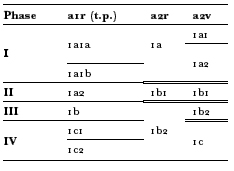 |
My accounts of quires A-D will be less detailed than the foregoing and will
ask the
reader to refer to the taxonomic key of appendix 1.
§5. Quire A
Table 12 results from mentally removing quire A from every copy of ToP
and arranging its pages in order from early to late states. Heavy
horizontal cell
borders indicate complete resettings; double-rule borders show
reset headlines
indicating reimpositions of standing type. Again the printing
seems to divide into
several phases. The table shows that the formes evolve in the
same direction,
which indicates that the printer was executing an orderly flip of
the stack after
printing the first forme: the first-printed sheets of one forme
became the first-
printed of the other. This pattern generally holds throughout
ToP, though we will
find some aberrations in the other
quires.
The table reveals that, as with the preliminary quire, Norton turned out sheet
A
in several discrete phases of work. The most common marker of a shift to a
new
phase is the resetting of the skeleton, or extensive text, of multiple pages
at
the same points in the production history, though quire A does not show
this
consistently. As mentioned in the previous section, it is often impossible to
say
what motivated Norton to distribute some pages and not others. In the case
of
quire A, all but one of the pages (A1v) retain at least half of their original
settings
throughout the printing history. A1v was reset after Phase I, and the
bottom half
of A2r was reset twice. Work on Phase II of quire A—the most clear-cut
transi-
tion point in the quire's evolution—began by reimposing all of the
outer-forme
type-pages set for the first phase. (Analysis of the type bite shows
that quires A–D

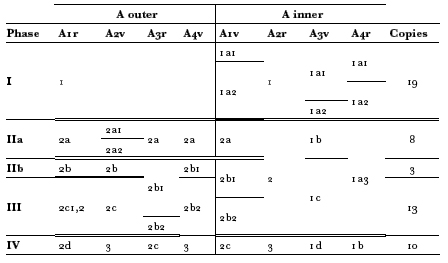 |
Norton reimposed the inner forme using two pages with minor changes from
Phase I (A3v and A4r, which lay head-to-head), but the other two pages of the
forme were either completely or partly reset (A1v and A2r respectively).
Other phase shifts were more subtle, and the transition from IIb to III
was
barely a whisper: only two pages got stripped and a couple of raised quads
were
pushed down on a third. The backing forme shows no sign of a
corresponding
interruption. This lack of correlation requires some fancy
explaining. My feeling
is that the reimpositions on A1r and 2v, though they affect
only two pages out of
eight in the quire, were still associated with a work
stoppage. The lowering of the
quads on A4v, which happens at the same time, was
probably an unintentional
result of removing the type-page at the end of Phase IIb
and replacing it for
Phase III. Furthermore, on the evidence of the surviving
copies of ToP, the number
of quire-A sheets in Phases IIa
and IIb combined (11) is approximately equal to the number of sheets of the other text
quires in their own undivided Phase II
(quire B, 10; C, 10; D, 11). Copies of the
book that contain Phase III
of sheets B-D also contain Phase III of sheet A. (One
exceptional copy from Phase III (Folger STC 22459.2) has an A-sheet from IIb, which
indicates a possible slight
overrun of the A sheets that found their way into the
following phase. I discuss
the overrun in more detail in §13.) These are the
reasons I have designated the
two sub-phases within the second impression of quire
A.
It is likely that Norton's original intent was to print Phase II as a
continuous
job, but that something interrupted the machining of the outer forme
and the
type was removed from the press. This marked the end of Phase IIa. When
he
was able to resume work, he had two options. The simpler was to put the outer

perfect the sheets from Phases IIa-b of the outer forme together. However, a
skeleton resetting on A1v and a page-number shift on A3v in the inner forme
suggests that the perfecting of IIa-b also proceeded in two phases of work. Norton
perfected all the IIa sheets before doing another printing of both formes to
complete Phase II. Although it required more shifting of formes, this tactic would
prioritize the completion of some number of finished A-sheets. This would allow
a more speedy assembly of at least some copies of the whole book.
The inner forme of Phase IIb is indistinguishable from that of Phase III
except
for a stop-press correction which appears part-way through the latter
phase
(A1v:2b2). On the evidence of table 12, Norton could even have printed the
inner
forme of Phase IIb and continued straight on to print the inner forme of
Phase
III in the same run, perfecting the sheets of the latter phase with the
outer forme.
But the type-impressions show that Norton always printed his outer
formes first. So, we have to conclude that Norton began Phase III of quire A with only
minor
changes to the outer forme (new skeletons for A1r and A2v) and none at
all
to the inner. The boundary line between Phases IIb and III continues
invisibly
right across the inner forme. We will later see similar arbitrary
patterns in the
production of the other sheets.
A few other observations on quire A are worth making:
- In the outer forme, the four pairs of variants A1r:2c1–2,
A2v:2a1–2, A3r:2b1–2, and A4v:2b1–2 all involve printing accidents. The last two pairs
result from specific, one-time events. On A3r, the "3" in the signature mark
drops out in the second state. (This may have occurred during the act of repairing
some type damage and mis-alignment at the upper left, shown uniquely in copy
bL 644.0.44. 23 ) A4v:2b1 has the quads printing between the two paragraphs, as
mentioned above; these rose during the reimposition preceding Phase IIb and
disappeared again at the inception of Phase III. (The rule below the text shows
various bends during these changes.) In contrast, the "variant" on A2v involves
a progressive downward creep of the last letter of the catchword, so these are not
two distinct states. Similarly, the A1r variants involve a page number that prints
more or less faintly—evidently a function of variable depths of impression—and there is no clear progression one way or the other over the course of printing. All
these changes present a random picture in appendix 2, but if one plucks out only
Phases II and III of quire A and puts the rows in order by state, the progression
becomes clear. - In A1v:2b1, the jockey in the torchlight parade holds a "bride" in
his
hand; state 2b2 corrects this to "bridle". Previous attempts at ordering ToP (most
recently in the STC) have tried to use this difference to characterize major groupings
of whole copies, but we see here that it is simply a stop-press variant within
Phase III. - Copies of the book with sheets from Phase IV of quire A come only with
a
"third impression" title page, and vice versa. In this final phase, a paragraph of description
added to A2r affects the page breaks for the rest of the quire. Sometimes135the transferred text was moved in type, sometimes it was reset. The method used
depended largely on whether the lines travelled to a facing page (i.e. in the same
forme) or to the verso (printed in the next forme, in which case the transferred
text was usually reset). Section 15A gives the specifics of this process. - Between Phases I and IIa, the four lines of italic split between A2v-3r
were
raided and reset in great primer size (120 mm). - In Phase IIb, the catchword on A2v, which heretofore correctly
read
"The", changes incorrectly to "All". This marries with the first word in roman
type on the next page, but ignores the two lines of italic that precede it. We would
expect this sort of error to arise during the italic raid after Phase I, but that had
already occurred. Instead, it appears that the workman doing the reimposition
for Phase IIb did not notice the italic lines and took his cue from the first paragraph
in roman. The error persists through Phase III.
To complicate the situation
further, that leaf was removed from the British Library
copy by Thomas Wise
and used to make up the Wrenn copy, now at the University of Texas.
§6. Quire B
A. PHASE I
The early phase of quire B presents one significant difficulty:
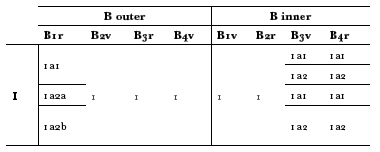 |
Only three pages show variant states in this phase. Those on B1r are:
1a1 heading wholly in italic
1a2 heading reset with characters' names in roman
- type relatively undamaged
- first letters of ll. 7 up and 9 up are damaged
We can be reasonably certain that this is the correct order because the
type
damage does not occur during state 1a1, and the reset heading follows the
normal
convention by giving proper names in a contrasting type style.
The variants in B3v-4r, in the backing forme, involve commas.
24
Neither
state is obviously the earlier, but the
direction of the change is less interesting at
this point than its confused
relationship with the outer forme: the early and late

distribution of surviving copies is as shown below:
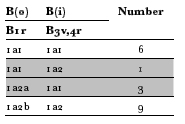 |
If, after printing the outer forme, the printer followed a normal turn of
the
heap of sheets that contained B1r, we would expect the changes on B3v-4r, in
the
backing forme, also to follow an orderly progression from early to late. We
saw
this pattern in quire A. In contrast, the distribution of states in Phase I of
quire
B shows a sort of "countercurrent eddy", indicated by the shaded cells
above.
It appears that a disorderly stack-turn took place. To understand this
concept,
first recall that a normal print run of a forme might produce several
hundred
sheets, yielding a thick pile of damp paper with the last-printed sheets
on top.
To preserve the same order and orientation of sheets going through the
press
on the perfecting run, the pile had to be inverted end-to-end. Since the
pile was
too bulky to turn as a unit, the workman had to transfer it in several
handfuls,
inverting each one onto the new stack.
Suppose instead that the workman carelessly transferred one handful of
sheets
straight across without turning it. This would produce a stratum of sheets
with
the printing facing the wrong way. We would expect the pressman, when
working
down the pile and finding this mistake, to utter a curse, turn the
affected sheets
to align with the others, and go on working. But he might also
utter a curse and
start picking up the sheets from the opposite end, using a
slightly different motion
to place them on the tympan. The pinholes—normally
positioned slightly
asymmetrically—would help prevent mishaps in perfecting, and
the pressman
might enjoy the little bit of variety until reaching the underlying
layer of correctly
oriented sheets. This seems to be what happened in Phase I of
quire B. Let us
use our sample of the nineteen copies of that phase to stand for
the entire first
printing of this gathering. The machining of the outer forme
(containing B1r)
produced a heap like the one on the left below, with the later
states on top.
If we now back up these partially garbled sheets with the inner forme
containing
B3v-4r, which begins with state 1a1 and switches to state 1a2 about
half-way
through, we get the observed distribution of variants (table 15).

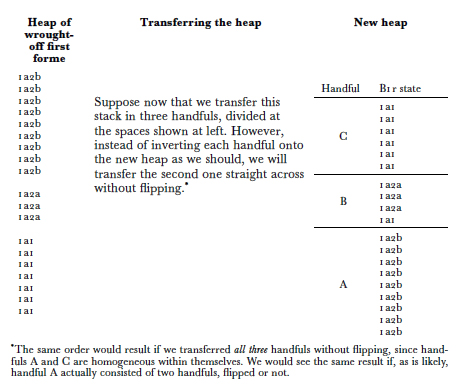 |
A stack turn with handful B transferred without flipping is the only
scenario
that yields the observed results if we assume the printer started the
perfecting
run at the top of the stack and worked his way straight through. Our
thought
experiment also shows that state iai of B3v-4r most likely came first. If
state 1a2
had been earlier, we would have to hypothesize a second turning of the
garbled
stack—this time correctly done—yielding the inverse of the first column
above.
The reader may verify that this does not yield the observed distribution of
states.
We cannot change the boundaries of group B without creating a conflict
with the
observed combinations, so that cohort must represent the survivors of a
manageable
number of sheets that the worker was comfortable picking up with
two
hands. It is tempting to extrapolate from our nineteen-copy sample to
estimate
the total number that were printed in Phase I. If group B represents one
"grab",
the total first printing of the quire might have contained four roughly
equal
handfuls of damp sheets, each of which in ToP
measured about 41 by 31 cm.
25
A
practical trial might provide an estimation of the edition size. However, it
proves
difficult to locate a source of poor-quality, lightweight, handmade paper
with

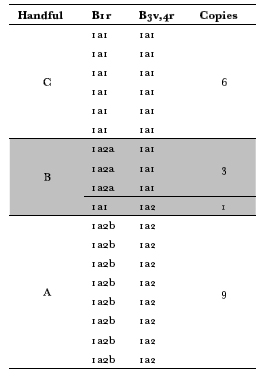 |
getting usable data from present-day fine printers regarding their paper-turning
habits. It turns out that there are a host of variables that make it impossible even
to approximate an upper limit on the edition size by this means.
It should make us slightly uncomfortable that B1r state 1a2b is
absolutely
coextensive with group A. The last handful (or more likely two) appears
to have
contained only that state, which occurs nowhere else; and state 1a2a is
found
only in handful B. If my analysis above is correct, and if further copies of
ToP
were to come to light, one of them might contain
B1r:1a2a combined with a
later state of B3v-4r.
B. QUIRE B, PHASES II-IV, OUTER FORME
The next phases of quire B are so complex that it is necessary to analyze the
two
formes separately.
After Phase I, three of the pages of B(o) were reset and one (B3r) was
reprinted
with a new skeleton. Phase II's only variants occur on B4v (in states
2a1 –3) in the
passage "ayre, ... with an artificiall bellowes coold". The last
word also appears

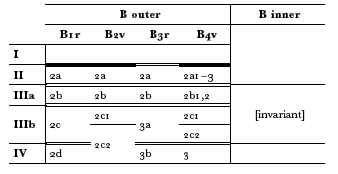 |
the variants probably result from a two-stage accidental loss of letters from the
end of the line. Frisket slip is not a suspect here because there are no intermediate
states—the letters are either completely present or completely lacking.
For Phase IIIa, all of the pages have new skeletons. Page B4v state 2b2,
found
uniquely in a copy at St. Catharine's College, Cambridge
(Z.59), presents
a problem because the page number has shifted horizontally.
However, the type
appears to be the same and the page is unchanged in other
respects, so reimposition
is not likely to be the cause. If looseness in the line
caused the shift, we
would also expect slightly different spacing among the three
characters of the
page number, but we do not see this either. It remains an
unexplained problem,
but a minor one.
In the discussion of quire A, I identified a point within Phase I at which
press-
work was interrupted, but the other formes of the book from that phase did
not
show a similar hiatus. Sub-Phases IIa and IIb were in effect separate
printings of
quire A, with both formes showing changes. Quire B is a slightly
different case.
Again, it appears that a more urgent job interrupted the printing,
this time during
Phase III of the outer forme. The delay was long enough that the
type-pages
were stripped and probably tied up. After the other job played through,
printing
of B(o) resumed with a new skeleton, including a new arrangement of
acorns on
B1r. (I have not been able to determine whether the direction lines were
reset as
well—they are closely similar.) These re-imposed copies constitute Phase
IIIb.
However, both of these impositions of the outer forme occur with identical
states
of the inner forme. The two sub-phases of the outer forme seem to have
gone
through a single perfecting run.
26
Apart from this one forme—and a couple of
other small variants
which I will discuss in §11–14—these five copies resemble
the twelve others from
Phase III.

The following corrections demonstrate that Phase IIIb indeed followed
Phase
IIIa:
 |
In Phase IV of this forme, a few things are of interest:
- On B1r, the page number wanders a bit horizontally over the 15th
pair
of acorns. - Likewise, on B2v, the stem of page number "4" can point to the first
letter
of "the" below, to the "o" in the preceding word, or anywhere in-between. - In this phase, B3r picks up the first three lines of text (in a new
setting)
from the following page, relieving some crowding on the latter. - On B4V, the four flush-right italic lines have been raided and are
reset in
smaller (pica) size. The two centered italic lines on the same page are unaffected,
perhaps because it was not worth the trouble to get at them. On this page also
the page number is horizontally unstable. This example of wandering, along with
items 1 and 2 above, are among many in ToP that demonstrate that lockups on
the press bed must have been much less rigid than Joseph Moxon's descriptions
would lead us to expect.
C. QUIRE B, PHASES II-III, INNER FORME
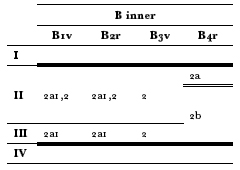 |
The inner forme of quire B is even more perplexing than the outer one.
Phase II
begins with a complete resetting of all four pages. Shortly afterward,

direction of the change from 2a to 2b is confirmed by a textual correction and
progressive damage to line 7 during state 2b. For only one page of a forme to
change its skeleton is puzzling enough. But it also occurs against a background
of changes to its forme-mates B1v-2r which do not develop in consistent directions.
These variants are:
B1v: The "V" beginning line 10 is more or less displaced downward, or is
entirely
absent. Where it is absent, the "D" from two lines down drifts up into
the vacant
space.
- B2r: 1. St. Catharine's College (Cambridge)
Z.55 shows a unique setting of
the page number. The number "3" comes from a different font than that found
elsewhere in the book, being rounded and with the upper loop noticeably smaller
than the lower. It is evenly spaced between undamaged parentheses. All the other
copies have the usual narrow "3" with loops about the same size, and one or
both of the page-number parentheses are either damaged or fouled with ink. This
number was apparently not locked up tight, and it can fall anywhere from close
to the left parenthesis to centered between the two. The direction line appears
to contain the same type as does the St. Catharine's copy. - In some exemplars, the right ends of lines 1 and/or 4 creep upwards
by
varying degrees. - The comma ending line 6 prints either normally or as a blob.
- A stray bit of metal resembling a hyphen may show in the empty
space
between lines 6 and 7 and below the "na" of "nature" in line 4.
A tabulation of these features shows some correlation among certain
manifestations
of variant 1 above (a bit of dirt on the right parenthesis at about
2 o'clock),
variant 2 (both lines displaced), and the blobby comma in variant 3.
But other
characteristics do not line up, either with each other or with the
amount of type
damage on B4r. Most of the features are of a transient nature and
could be
reversible: for instance, the wayward "V" on B1v could drift, fall out,
and be
replaced, so late copies might look like early ones. The loose page number
with
its parentheses could have fallen apart near the end of the run, and all
three types
could have been reset to produce the unique manifestation in the St. Catharine's
copy. The stray metal in variant 5 could have
been slightly raised in the forme
throughout this phase, but would print only when
sufficient pressure
Excessive attention to these details might not be either productive or
healthy,
but it is not so easy to dismiss the skeleton change on B4r early in
Phase II (the
transition from state 2a to 2b), mentioned above. Because there is
no evidence
of changes on the other three pages of the forme at that point, it
presents a challenge
to my theory that arbitrary page-number changes are signs of
work stop-
pages. It is another occurrence I will have to leave unexplained.
D. QUIRE B, PHASE IV, INNER FORME; QUIRE B RECAPITULATION
The final phase (IV) of forme B(i) shows a resetting of all the pages. For
no
obvious reason, the four-line roman-face stage direction on B3v beginning
"The
Gentleman ..." is now set in pica, one step smaller than the surrounding
text.

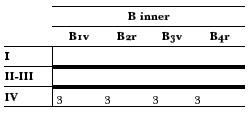 |
Combining all that we have discussed about both formes of quire B generates
table
20, which is puzzling in its fragmentation and necessarily evasive
about
correlations among certain states below a certain level of detail.
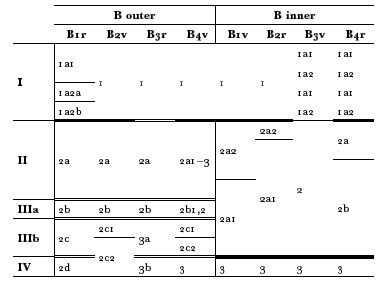 |
Nevertheless, it is possible to discern two events, initiating Phases II and
IV,
that clearly interrupted work on the entire quire. These resulted in the
resetting
or reimposition of almost all the pages. The outer forme underwent two
more
skeleton changes on its own, introducing Phases IIIa and IIIb.
What I have
called state 1a1 of B3v has "off throw" in l. 10; B4r ll. 16–17 read
"This
[man] with a face Philosophicall and beard / Hath with the study of
twenty yeares found out / A lampe ...". State 1a2 of both pages respectively have
"off, throw" and "This with a face Philosophicall
and beard, / Hath with the
study of twenty yeares, found out / A lampe ..."
The five witnesses to quire B's Phase IIIb are at the Newberry, Bristol Central
Library,
the Elizabeth Club (Yale), the Bodleian (Mal. 160(3)), and Dartmouth
College.
§7. Quire C
Table 21 shows four relatively clear-cut phases of production for all of quire
C.
Phases II and III are signalled by reimpositions or resettings that run
straight
across both formes. Phase IV is more subtle, having only two pages
reimposed.
But the remaining pages (except for C3r, which comes over completely
unchanged
from Phase III) all show revisions, some of them major, at the inception

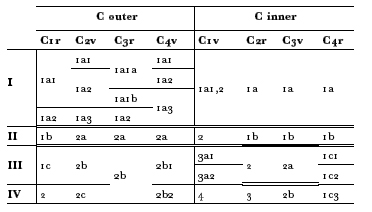 |
we have already shown initiating the final printing phase of the preceding quires.
(Appendix 3 shows this correlation most clearly.) Phase IV of this quire is found
only with the "third impression" title pages and vice versa. So, despite the lack of
extensive resetting at this point, we can still assert
the likelihood that the alterations to both formes preceding this final phase took place during a significant
pause in the press run.
On C2v, the action of the masque enters its final phase, which features
numerous
songs set in italic. These provide the main source for the italic
raids
discussed in §3.
The production of the quire went as follows:
A. PHASE I
C outer forme shows a normal pattern of variants whose sequence is all
but
certain. The inner forme, however, presents an insoluble problem in the
sorting
of the two variants of C1v, which at line 23 has either (1a1) "We
change
the Seene" or (1a2) "We change the Scene". These are found in the
combinations
shown in table 22. (The remaining three pages of C(i) are invariant,
so
are not shown.) About half the sheets (the eight copies shown in the last row
of
the table) have the latest states of both the outer and inner formes, as we
would
expect, but the other ten sort illogically. Unlike the retrograde pattern of
quire
B Phase I (§6A), the existence of all these permutations cannot be
explained
by any plausible irregularity in turning the stack. Only dropping some
portion
of the sheets on the floor and picking them up more or less at random
would
cause the first state of the inner forme to be printed on the back of three
of the
four variants of the outer forme. "Accidents at the press" is the last
resort of the
baffled bibliographer, and I will not waste space here in trying to
develop such an
explanation.

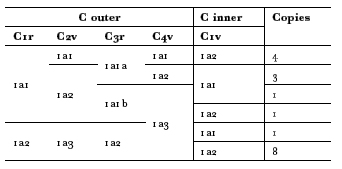 |
On C4V the bottom lines of text are bent upwards at the right. The
greatest
amount of deflection is a bit more than 2 mm—so, rather less than half
the
height of one line—but bad register with the text on the back of the leaf
makes
it quite noticeable. This much distortion would be impossible if the
non-printing
space on the page were packed solid; there must have been a gap in
the lockup,
and I would guess that one of the lines of Song 5 somehow got into the
forme
without being justified. Such an oversight would also explain the slight
misalignment
in lines 7–9 on the same page. This precarious situation might have
made
it impossible for a workman to pick up and transport the locked-up forme
in
the manner described by Moxon,
27
but the interaction of pressures along both
dimensions of the
page was apparently sufficient to keep types from being pulled
during presswork.
This is the most graphic demonstration in ToP that
printing
could proceed with adequate stability even if regions of the forme lacked
support
on all four sides. We have already seen instances in §6B of wandering
alignment
between adjacent lines that probably arose from similar causes.
27a
B. PHASE II
Phase II shows raiding of italic on pages C2v, C3r, and C4v. These pages
contained
all of the main caches of italic in the outer forme. C4v was
particularly
heavy-hit, being totally reset except for the roman lines 7–9 and the
last line. After
the raid, the italic Song 5 and its roman title on that page
reappeared in pica size.
The inner forme of quire C offered an even richer source of italic than
the
outer, but it was never raided at this point, or ever during the history of
ToP.
The reason is probably that C(i) was on the press
and inaccessible while C(o) was
being raided. C1v does show resetting of the
italic in lines 8–10 and 25–27, but
this page was not a plentiful source for the
font, and the resettings could have
arisen from some other cause. (For instance,
the earlier state showed a comma

repositioning it.)
C1r in this phase shows some horizontal instability in the
page-number
position.
C. PHASE III
In this phase, pp. C2r and C3v—which lie side by side in the forme—undergo
the
only complete resettings in the history of quire C. Head to head with
these, but
later in the phase, C1v and C4r both show page-number shifts. These
are probably
simultaneous but random drifts, as the types in the page numbers
appear to be the
same before and after. However, the five copies which show this
deviation happen
to be the same ones which contain quire B from Phase IIIb. I
will discuss this
uncomfortable coincidence in §13.
Also in this phase, the text of C1v shows further instability around the
same
points which changed in Phase II: the italic in lines 1 –10 and the last four
lines
is reset, the fourth line up ("A Landschape the
Scene.") going missing in the first of
two steps to a smooth transition
between antimasques. When lines 8–10 were
changed in the previous phase, the
period after "carryed off" in line 9 ended up
below the line (which shows another
unstable lockup). In Phase III, it is properly
aligned, and the resetting of the
nearby italic may have had some connection
with that repair-work.
D. PHASE IV
Phase IV, as mentioned above, is found only in "third impression" copies of
ToP, and, like the final phase of quire A, it introduces
important textual revisions
that alter the page breaks within the quire. Edits on
C1v and 2r shorten the word
count significantly, causing two-line chunks of the
text to move backwards until
the original breaks resume at the end of C2v.
This phase gives us further examples of text that is reset either larger
or
smaller than the prevailing 96 mm "english" size:
C1r: At the top of the page, a brace separates the list of three characters
from
their stage directions on the right. In the original setting, the directions
crowd
right up to the brace. In Phase IV, the direction is reset in 82 mm pica;
the line
breaks are the same, but the page gains some needed white space.
C2r: The antimasque of the "phantastique Adventurer" has the same layout
as the
previous example, with a brace separating the names of the characters
from their
stage directions. In this last phase, the directions are rewritten and
lengthened,
so the compositor reset them in pica type apparently to maintain
visual
balance.
Peter Blayney's recent work on
quotation quadrats ("Quadrat Demonstrandum,"
PBSA,
111.1 (March 2017, pp. 61–101) gives a probable mechanism for some of
these
displacements.
§8. Quire D and "A Speech"
Readers who have followed me to this point will, I trust, agree that the
thirty-six
pages of The Triumph of Peace comprise a Wunderkammer of bibliographical
problems, any one of which
could support a separate study. The last quire will
not disappoint.

A. QUIRE D PHASES I-II
Quire D begins life with an outer forme showing an orderly progression
of
variants:
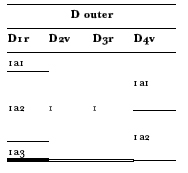 |
The second state of D1r supplies a missing word; at the same time the first
three
lines lose their horizontal alignment. This state gives way to a third one
in
which the same three lines of type are damaged. D4v shows a more subtle
change, in
which the right parenthesis of the page number suffers damage near
the bottom;
this occurs while D1r is in its second state.
The inner forme on this set of sheets also shows a regular progression, but
with
a clear work stoppage indicating two phases:
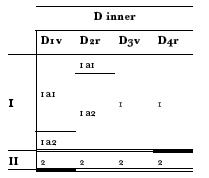 |
The variants are
D1v: State 1a1 has a comma that has slipped into the line below, and a
damaged
parentheses to the right of the page number. In state 1a2, the comma
is
correctly positioned and the parenthesis is sound. This sequence, which
could
have gone in the opposite direction, is confirmed by

D2r: The second state (1a2) corrects a typo, improves sense by adding a
comma,
and pushes down one of two quads that were printing inappropriately
in the first
state.
The conspicuously damaged parenthesis in D1v:1a1 is the same one found on
C2v,
also in Phase I, in the same position to the right of the page number and in
the
same quarter of the forme. This recurrence gives us a clue about the order
of
printing these quires in Phase I. There are two possibilities:
- Quire D came first. The damaged parenthesis was removed
part-way
through Phase I as one of five stop-press improvements to the inner forme, but
instead of being discarded it was put back in the type-case and later set—coincidentally
in the same position—in the headline of C2v. - Quire C came first. After Phase I of that quire the damaged
parenthesis
either persisted on D(i) as part of the skeleton, or returned to
the type-case to be set—coincidentally in the same position—on D1v. In either case, part way
through Phase I of quire D, its damaged state caught the eye of the corrector
and it was discarded.
The second possibility—that the parenthesis remained as part of the skeleton
and
was later replaced by a sound type—is much more likely; and indeed this
damaged
parenthesis never reappears in later states of ToP.
The independent typographic evidence that Phase II of the inner forme
followed
Phase I is rather slight: the correction of one error in line 8 of D3v,
which
kept the same setting of the first twenty-one lines from Phase I. However,
as most
copies of ToP containing Phase II also contain
later states of quires A-C, we can
be confident of this direction of change.
When we put together Phases I and II of the two formes of D, their
relationship
becomes complicated:
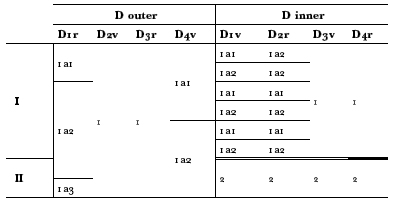 |
This table shows two oddities beyond the fault-lines indicating the pauses
in
production, which by now we have become accustomed to:
- There were two production phases of the inner forme, marked by
skeleton
changes on three pages (D1v, D2r, and D3v) and a complete resetting of D4r.148However, the outer forme of the same sheets appears to be the product of one
continuous printing, with states 1a2 and 1a3 each appearing within Phases I or II,
not during a pause between them. - Phase I of this quire shows an illogical mixing of states between the
two
formes. If we consider only the states in this phase and ignore the invariant pages,
the scheme looks like this:
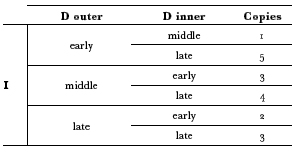 |
This is very nearly a random shuffling; like the permutations of quire C in
Phase
I, it cannot be attributed to any plausible method of flipping a single stack.
The
three combinations that do not occur are early/early,
middle/middle, and
late/middle; but there is no guarantee that these would not
emerge if new copies
of the book were to come to light. As with quire C, I am
unable to explain the
distribution of variants here.
Point 1 above—the fact that the inner forme goes through two production
phases
while the outer forme appears to have only one—is easier to explain if
we suppose
that the outer forme went through two printings with no alteration
during the
pause between them. Phase II of D(i) associates mostly with the third
state of the
outer forme (D1r:1a3), in which the first three lines of type on D1r
show damage.
The accident that caused this may in fact have come in the transition
to Phase II.
The distribution of surviving copies is as follows:
 |
Only two copies (McMaster University, and British Library Ashley
1697,
shaded above) show sheet D with its inner forme from Phase II
but the outer
forme in the undamaged state typical of Phase I.
28
If we take the hypothesis that

the inner forme, there are at least two possible explanations for the observed
distribution:
- The damage occurred early in the second printing of D(o), or
- McMaster and Ashley 1697 represents a small residue of
sheets which for
some reason were not perfected during Phase I. The damage occurred during
the replacement of the outer forme in preparation for Phase II. The Phase II
sheets with the damaged type were combined with the Phase I leftovers and
perfected with Phase II of the inner forme.
It is more likely for damage to occur at points of transition than during
periods
of repetitive work, so I lean toward the second explanation. Either one
requires
some special pleading to fit the hybrid copies into a plausible narrative.
There
is no doubt, though, that they are closely associated with the skeleton
change in
D(i), which marks the end of Phase I of that forme, and the same phase
also
produced about equal numbers of quires A-C.
Before Phase II came the pause during which italic was raided in quires A
and C.
Norton raided quire D as well, but only the inner forme. Three of its
constituent
pages show the italic in a new setting in Phase II, while the
fourth
page—consisting almost entirely of italic—was entirely reset. D3r, in the
outer
forme, could have supplied a good amount of the font but was not
touched.
For Phase II of quire D, Norton printed the outer forme, as I have
argued,
unchanged from its Phase I state except for the damage to D1r (which could
also
have happened early in Phase II). Following Phase II, another small italic
raid
occurred on both formes, carrying off the songs on D2r and D3r. The former
leaf
had already been raided, even more extensively, following Phase I. The
second
raid shows a continuing need for the font beyond its earlier use to set the
dedication
for ToP; some other job was interrupting at this
point. Concurrently with
these replacements, and quite bafflingly, the roman
portion of D3v—about two
thirds of the page—was reset. I cannot begin to suggest a
reason for this.
B.QUIRE D PHASES III-IV
Uniquely for ToP, Phases III and IV of quire D contain two
different settings
that mix randomly in copies containing Phases III and IV of the
other quires. I
will call these settings A and B:
 |

Setting A, in six out of the eight pages of the quire, is simply a reimposition
of
the standing type from Phase II; the first two pages are reset. Setting B
contains
typographic features not found elsewhere in ToP,
nor in any of Norton's printing
from the years 1633–34 that I have
seen. The characteristics are:
| Quire D, setting B | Rest of ToP (Norton) | ||
| k | The diagonal arms are stunted, the upper-right serif failing to reach the x-height and sometimes tilted upward. | k | The upper diagonal arm consistently reaches the x-height. |
| w | In some examples, the left V meets the right one a bit downward from the middle serif; the bottom of the left V falls below the baseline of the right one, so that the letter usually appears to tilt to the left. | W | The left and right V's meet the middle serif at the same height, and the letter does not tilt. |
| h | The curvature of the legs is midway between that of Norton's i-1 and i-2; the right leg ends pointing left. | h | In i-1 the legs curve slightly toward each other but do not approach closure; the right leg ends pointing 45 degrees below horizontal. In i-2, they close almost completely; the right leg ends pointing straight left. |
| 3 | Full-bodied. | 3 | Abnormally narrow. |
| o | Ranges with the other lowercase letters. | o | Usually too large. |


These are strong tendencies, not invariable markers, but the differences
are
pronounced enough to indicate that a second printer's type was used in
setting
B. The immediate suspicion falls on Nicholas Okes, with whom Norton at
this
time had an informal and increasingly fractious partnership.
29
Okes had already

his 1609 stock as catalogued by Peter Blayney 30 —Norton is known to have filched
other woodcut material during their association. To confirm my hunch about
Okes, I surveyed English books printed in 1633–34, searching for the odd "k"
and "W" in particular. Unsurprisingly, this did not yield an unequivocal answer.
Early-modern printers' typographic stocks were not proprietary, homogeneous,
or static, and there are no woodcut elements in quire D to help finger the collaborator.
I found versions of the stunted "k" in the repertoire of numerous
printers, including at the university towns, and "W" showed great variability in
most samples. Many texts I looked at did not even contain english-size type—
the smaller pica is much more common—and a good proportion were Latin, in
which letters "W" and "k" are rare. My search for definite fingerprints became
an exercise in probabilities, trying to estimate frequencies of the characteristic
sorts in scattered pools of the target font. In the end, though, my survey supported
Nicholas Okes as the most likely owner of the type used in quire D setting
B. 31 A hardier investigator than I might be able to clinch the identity with
a survey of broken types in Okes' other productions, but for narrative simplicity
in this account I will treat it as a certainty.
Though Okes' type may appear in setting B, we cannot assume that he had
personal
responsibility for the printing. A series of undated petitions beginning in
late
1635 shows a deteriorating relationship with his partner. Okes' most
interesting
complaint is that Norton, "wanting Capacitie himself for the
Government
of a presse hath enterteined ayded & assisted a Company of
disorderlie & factious
persons for the erecting of an unlawfull presse in a
secrett place, and hath
without [my] knowledge & Consent ... secretly conveyed
out of [my] house [my]
formes and lettres which afterwardes were discovered and
seized by the master
& wardens of the Company of Stacioners & at their
hall melted and defaced to
[my] great disgrace and losse."
32
The chronology of these events is vague,
but
another document, dated January 1635, reinforces the impression
that both men
were accustomed to playing fast and loose in their business. This
list, endorsed
by Sir John Lambe of the High Commission,
claims that the two printers jointly
employed, in addition to five authorized
apprentices, six individuals "brought
upp to Printing against order".
33
The latter group, which included a
butcher,
a gingerbread maker, and a garbler, may have constituted the "disorderly
and
factious" team that Norton recruited to run his clandestine press. There is
no
evidence that the "Okes" ToP quire D was printed
off-site, or even that Norton

operated in the shadows, and we cannot take for granted the ostensible paternity
of any of their productions.
Okes' setting of quire D occurs in seven of the seventeen surviving copies
of
Phase III and in four of the nine copies of Phase IV Possibly Norton and
Okes
each printed about equal numbers of sheets to supply the last two phases, or
Okes
printed rather fewer. I have not found any variants in Okes' sheets. Although
the
typesetting is not error-free, one gets the impression of a more assured
compositorial
hand than Norton's crew could muster. It is not clear why Norton
brought in
a second printer at this late stage to run off a "duplicate" setting of
the quire. In
§16, I will show that the time gained by running the same eight
pages of text on
two presses was nearly offset by the time taken in setting them
anew. The complications
of using a clandestine off-site press would further reduce
or even negate
the advantage. This consideration, along with the greater
professionalism of
Okes' quire D setting, argues against Norton's direct agency in
its production.
We know that Phases III and IV of sheets A-C contain multiple impressions,
so we
would expect sheet D to show evidence of this as well during Okes'
involvement.
However, as mentioned, Okes' sheets contain no variants that I
have
identified. Norton's sheets for Phases III-IV are also virtually identical,
but D1r
shows some interesting small changes:
2a1: l. 10 has "Masqncrs"; signature mark under the "hi" of "white,"
2a2: l. 10 has "Masquers"; signature mark under the comma of "white,"
2a3: l. 10 has "Masquers"; signature mark under the "w" of "white,"
From the spelling correction it appears that states 2a2 and 2a3 follow 2a1.
The
shifts in the direction line raise the spectre of reimposition. However, the
signature
mark—anomalously, an italic "D"—appears to be the same type in all three
states.
(Transient bits of foreign matter appear either as specks within the
letter [mostly
in 2a2] or falling across one or the other serif.) The page number
also appears
invariant in composition and position. It would be tempting to
attribute the states
of the direction line to random shifts due to loose lockup,
except that there are n
ointermediate states, and the variants tend to sort in a
complex but fairly orderly
fashion with sheets of the other quires. Norton's
states of sheet D show the following
distribution:
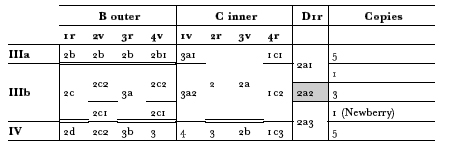 |

The table shows that state D1r:2a1 is found only with Phase-III copies of
the
other quires, while 2a3 associates (with a single exception) with Phase-IV
copies.
State 2a2 (shaded) is transitional between 2a1 and 2a3, and it occurs in
copies
having B(o) from Phase IIIb. Those same copies have unique states of pages
in
the inner forme of sheet C. In §11–14, I will return to these links among
the
three quires. For now, it appears that the D sheets containing Norton's
D1r:2a3
could represent a discrete Phase IV, his final one for that quire. The
"leakage" of
2a3 into Phase III, represented by the Newberry copy, could have
resulted from
Norton's having printed sheet D a bit short in phase III. Thus, a
small group of
Phase-III copies of the book may have been made up with Phase-IV
sheets of
quire D. Those hybrids probably went to the warehouse along with the
purebred
Phase-IV copies.
If we accept that Norton printed Phases III and IV of quire D as
distinct
impressions, what about Okes? Might he have printed all his sheets for
both
phases in one go? If we allow this possibility, we have to explain the fact
that, in
the surviving copies, Okes' contribution makes up about an equal
proportion in
each phase: respectively 41 and 44%. When, after Phase III, a
workman began
collating complete copies, he would probably start picking D-sheets
from a homogeneous
batch of one or the other man's production, whichever came to
hand
first. This process would almost certainly produce different Norton/Okes
ratios
in Phases III and IV So, either the D sheets after Phase III already
contained
about 40% of Okes' work, or Norton deliberately manipulated the ratio to
equal
that in the upcoming Phase IV. Such an intervention supposes obscure
motives
and more fastidiousness than I can credit Norton with. The same objection
applies
to a hypothesis that both men printed their sheets for Phases III and
IV
in a continuous run. The more plausible explanation is that Norton brought
in
Okes to print a half-share of Phase III sheets, but asked him to keep the
eight
pages in type, skeletons intact, against a probable fourth printing. When
that
need came about, Okes was able quickly to reimpose the pages without
alteration
for the new run. This scenario asks a high degree of precision from
Okes, and
requires that he tie up eight pages of type without knowing for certain
whether
they would be needed—otherwise, why not go ahead and print Phases III
and
IV together? I cannot give a detailed and definitive account of Okes' work
cycle.
It is intertwined with the mystery of why he got involved at all; if we
knew the
answer to one, the other would probably follow. However, I favor the
theory
that Norton's and Okes' teams worked in tandem on Phase III of quire D,
and
that—on the slim evidence of surviving copies—each produced an
approximately
equal number of sheets, of which Norton's contained states D1r:2a1
and
the much less common 2a2. Once they reached the end of Phase III, the
pages
of type from both printers' pairs of formes were tied up and there was a
pause,
during which completed copies from Phase III were assembled and
dispatched.
After an indeterminate time came Phase IV, for which both printers
again machined
approximately equal runs of their respective settings of quire D.
Norton's
sheets of these final copies differ from those of Phase III only in the
position of
the signature mark on D1r, which moved about three millimeters,
probably during
the reimposition process, producing state 2a3 of that page.


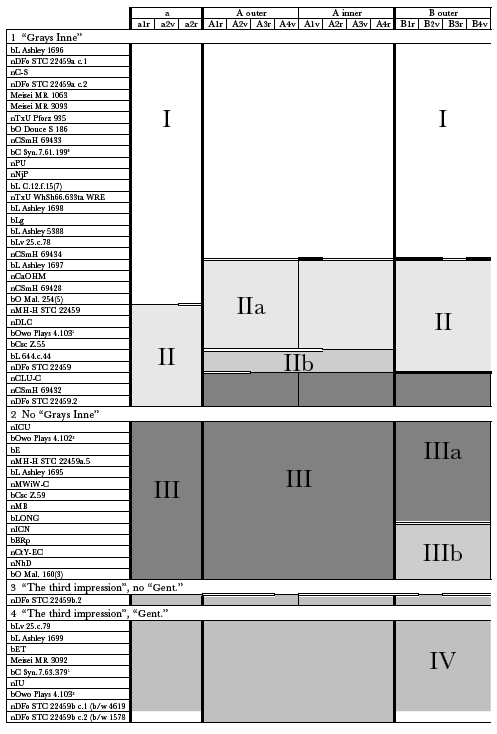 |
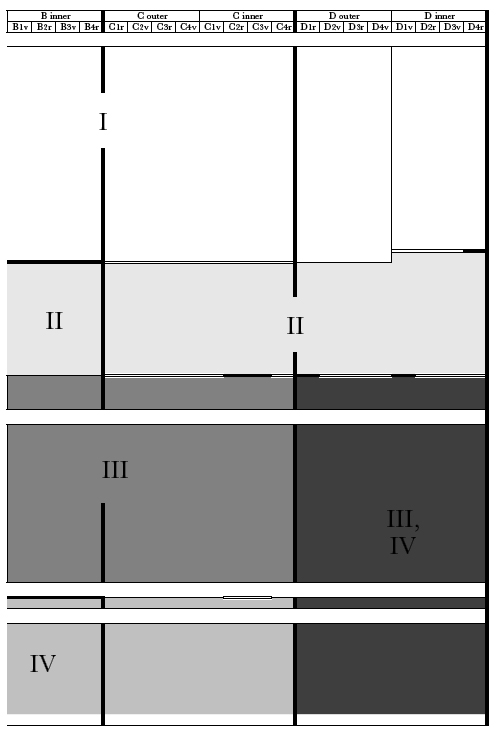 |

Norton and Okes seemed to feel that a further impression would be called
for
after Phase III, but something prevented them from going on to print a
double
run of quire D. The publisher Cooke may have been uncertain about
demand.
But Phase IV also ushers in the bulk of the substantive textual variants
in ToP
These occur in the description of the procession on
A2r and A3r, in the tavern
direction on B3r, and in antimasques on C1v and C2r.
None of the variants are
stylistic; they seem rather to document actual changes in
the performance. By the
end of Phase III, Norton and Okes may have known that
revisions were coming.
Although, in the event, none of these fell in quire D, the
printers may not have
known this, and therefore put the type-pages for the last
quire aside until the
matter was settled.
The singleton epilogue leaf "A speech to the King and Queenes Maiesties",
found
in only four copies (and Greg's own copy, now untraced),
34
exists in a single
state, printed by Norton using
mostly his workhorse italic i-1. The page is headed
by the now-familiar motif of a
double row of acorns (28 pairs in this case). I will
consider the history and
status of this addendum in succeeding sections.
Alan B. Farmer, "John Norton and the Politics of Shakespeare's
History Plays in
Caroline England", in Shakespeare's Stationers (ed. Marta
Straznicky, Philadelphia: University of
Pennsylvania Press, 2013),
pp. 147–176; Peter Blayney, The Texts
of King Lear and their Origins
(Cambridge: Cambridge University Press,
1982), pp. 304–313; C. William Miller, "A
London
Ornament Stock: 1598–1683
(Studies in Bibliography, 7 [1955], 125–151
[131–136].
Blayney, op. cit., p. 445, factotum 1 (rotated
180°). An apparently early casting of Okes'
type appears on p. 46, fig.
4.
The next most likely were Thomas Cotes
(introduction to STC 25957), William
Jones
(dedication to STC 20464), John Legat
(dedications to STC 4223), and Richard Badger
(introductions
to STC 23490).
Undated petition to the Court of High Commission. Blayney, Lear, p. 311,
quoting
from National Archives, State Papers, Domestic Series, Charles I, 16/376/21.
§9. Order of Printing the Quires
In the preceding sections, we have been exploring ToP
"vertically", as it were
—working out the histories of individual pages, studying
their chemistry as they
combine into formes and quires, and watching each quire
evolve in isolation
from the others. It is now time for a "horizontal" approach as
we begin to reconstruct
the progress of printing the whole text, phase by phase.
Table 30, a
modified version of appendix 3, shows how these phases align across
the quires
of the surviving copies. It shows a fairly orderly stratification: for
a given copy
of the book, the phase of any one of quires A-C serves as a good
predictor of
the phases of the others. The few exceptions to this among the
survivors result,
I believe, from the occasional necessity of making up copies
with sheets from
neighboring phases. (I will discuss this further in §11–14.) But
the phases do not
leapfrog one another: II and IV never mix in a copy, nor III and
I or IV and I.
If sheets from more than one phase were available simultaneously
for gathering
complete copies, there was nothing to stop Norton from mixing them
indiscriminately,
because the text-breaks across quires never change. Except for
the "third
impression" copies he would have no motivation for keeping the products
of
one phase segregated from another. Therefore, I think we can safely hold to
the
theory of four discrete printings of the book as a whole.
The recurrence of types can give us clues about the order of printing the
quires.
(Lacking evidence to the contrary, I will assume for the ensuing discussion
that
the order of printing in ToP is the same as the order of
composition.) We would
expect Norton to work through quires A-D in sequence. But
here, as so often, ToP
hands us a surprise. The recurring
types in the first phase of printing that I could
confidently identify are
distributed as follows:

A. PHASE I
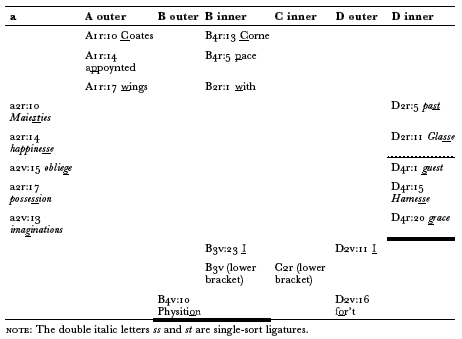 |
On first glance, the table appears to show nothing out the ordinary. Quire
B
inner forme could have been set with type distributed from the outer forme of
A;
Norton could even have begun at the title page and proceeded straight
through
the book. But we need to take into account what happened to the
individual
pages at the end of Phase I. In fact, the outer forme of quire A
remained in substantially
the same setting through the printing history of ToP, whereas quire B
was distributed after Phase I. So, types
from A(o) were not available to set B(i)—
rather the opposite. Therefore, A(o) was
set after B(i) went through the press and
got broken down. Similarly, quire "a"
continued to hang onto most of its type
(predominantly 96 mm italic) while D2r was
raided for its italic after Phase I. (I
have indicated the point of the raid with
a wavy border in table 31, distinguishing
the fate of that page from that of D4r,
which was entirely distributed.) The
preliminaries could not have been set until
printing was finished on quire D inner
forme. Furthermore, two letters on D2v show
that that page could not have
been set until after the distribution of at least
part of each forme of quire B; and
a distinctive bracket on C2r shows that C(i)
cannot have been set before B(i)
was off the press. So, quires C and D both
followed B. In §8A, I showed, on the
evidence of one broken parenthesis in the
headline, that quire D was probably
printed after quire C. No other types from C
show up elsewhere; it was probably
set while quire B was still being worked off,
after which it held onto most of its

have supplied some other printing job than ToP. If, then, we may consider entire
quires as production units, it appears that the printing of Phase I followed the
sequence B-C-D-A-a. Nothing in the data shows that the preliminary quire "a"
had to come last, as long as it followed D from which it drew some of its type. But
preliminaries were normally printed at the end of the job, and if "a" followed D
directly, there would have had to be a pause for D(i) to be at least partly distributed.
(Remember that in ToP the inner formes were printed after the outer ones,
and it is only D(i) that provided types for quire "a".)
Something caused Norton to place quire A late in the schedule. A probable
reason
emerges when we recall that quires B-D contain the text of the masque,
while quire
A sets the stage, as it were, with a description of the costumes, scenery,
and the
public procession that opened the performance. Most of this is written
in the past
tense, as if reporting the finished event, while the stage directions
for the
masque itself are mostly (though not exclusively) in the conventional
present
tense. This division between reportage and direction again raises the
question of
whether copies of the book were in fact available on the day of the
first
performance—a matter which I will explore further in §16. The important
point here
is that the details of the procession were more likely to be in flux until
the
last minute, whereas a relatively stable text of the masque would have been
needed
earlier so the performers could learn their parts. Though both sections
show light
revision through the printing history, it would have made sense to
start work on
the part least likely to change. Quite possibly, Norton began typesetting
the main
text before Shirley had even finished writing the
description of
the procession.
If typesetting and printing began with quire B, as the evidence above
indicates,
this may explain why this quire alone was mostly distributed after
Phase I—
seven of its eight pages broken up, as opposed to only one page each in
quires A
and D, and none in C. I have already mentioned the often arbitrary
pattern of
which pages got distributed and which survived into later impressions.
However,
this first quire printed could represent an initial intent to play by the
rules and
distribute type after running an impression—a routine that Norton could
discard
if he learned that he would have to achieve faster production than
planned.
Two other observations are worth mentioning here:
- Quires A, C, and D have a type-page width of 89–91 mm, but quires "a"
and
B measure 97 mm—three ens of english type wider. 35 These different widths
imply at least two differently adjusted composing sticks, suggesting more than
one compositor. - 2.The last page of quire B has some overly generous leading, indicating
some
distress in copy-fitting. This could reflect a compensation for the unexpected
use of the wider measure just mentioned.

B. PHASE II
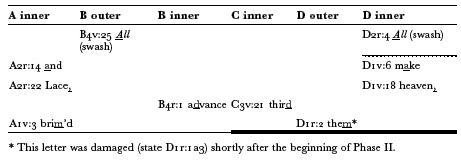 |
After Phase II, only four pages were distributed, plus italic portions of D2r
and
D3r; recurring types therefore provide less evidence for the order of printing
in
this phase than for Phase I. (The wavy border below D2r in this table shows
that
only the italic portion was reset; one of its types turns up on B4v.) Here
again,
it appears that quire A was printed after quire D: D1v was distributed at
the end
of this phase and two of its types show up on A2r. On the other hand,
quire A held
onto most of its type from this phase onward and could not have
supplied it to D
or any other quire. It also looks (on the evidence of only two
types, but both are
quite distinctive) as if quires D and C were finished print-
ing before quire B
could be set—again, because quire B carries its types largely
unaltered into the
next phase, while the donor pages in quires C and D give up
type after Phase II.
These observations show that quires C and D were printed
before quires A and B.
The fact that Phase II of quire A actually consisted of two
separate printings
complicates the picture. In §5, I suggested that, after an inter-
ruption in the
Phase-II printing of A(o), Norton chose to perfect the sheets he
had already
printed rather than resuming the planned run of the outer forme and
then
perfecting both sub-impressions in a single operation. The motive would be
to
prioritize the completion of at least part of the planned impression of sheet A
in
order to get some complete sets of sheets to the publisher for sale. This
strat-
egy would make more sense if quire A came later, even last, in the sequence
of
quires as printed. However, if quire A came last and if therefore B followed
D
directly, the composition of B's outer forme (the first one printed in B) would
have
had to wait for the italic from D2r (in the second forme printed in D) to
become
available. This would leave the press idle, at least for purposes of
machining ToP.
If, instead, A followed D directly, its
outer forme would still be standing from
Phase I and printing could have proceeded
on that while D was broken down
and the types incorporated into A(i). So, the
slightly more likely sequence for this
second phase of printing was C-D-A(Phase
IIa)-B. Probably Phase IIb of quire A
came last, but it cannot have been delayed
long because two of the three surviv-
ing books that contain it also have Phase II
of sheets B-D.
The textual changes in quire A are minor for Phase II and would have had
no
bearing on a decision to leave the production of that quire for later. Possibly it

B, on the other hand, came into this phase with only one type-page intact; all the
others had to be reset. So, it would have made sense to commence printing with
quires C, D, and A, leaving time for the resetting of B.
I have left quire "a" out of the discussion for this phase because it holds
onto
most of its original types throughout the production. We would normally
expect
it to come late in the series, probably after quires B and/or A(Phase
IIa).
C. PHASE III
 |
This phase began with the resetting of four pages, italic raids on two
others,
and some localized resettings. Only the inner forme of quire B was
distributed
before the next phase. Its donation of a distinctive bracket to C1v
shows that C(i)
was composed after B(i) had finished printing. This is the only
evidence for work
sequence that recurring type-matter affords in Phase III. (Of
course Norton's and
Okes' typesettings of quire D did not share any material.)
Italic raids before this phase point to a continuing need for english italic
for
another job; the distributed material does not reappear in reset portions of
ToP.
D. PHASE IV
 |
Both Norton's and Okes' quires D continue intact from the preceding phase,
and
most of sheets A-C also enter Phase IV unchanged except for localized reset-
tings
to accommodate revisions and resulting page-break changes. The exception
is quire
B inner forme, which was entirely reset. As usual, there is no obvious
reason why
Norton reset this forme and not others. But table 34 shows that some
of the types
from the first page of text (A1r) turn up again in the two last pages—
B3V and
4r—of the newly set B(i). So, A(o) was already printed and being dis-
tributed
before B(i) was ready for the press. A single letter "a" shows
that Norton
printed sheet D and distributed some of its type before resetting
three lines on
B3r. Therefore—if we again take sheets to be the units of
production—both A
and D preceded B through the press. Quire C contains no
distinctive types that

insufficient to establish links with any other. The sequence, then, was A-D-B,
with the positions of C and "a" unknown, though as usual we would expect the
preliminaries to come last.
Though the evidence of recurring types is very incomplete, it shows that Nor-
ton
distributed at least portions of quires A and D while other quires remained to
be
composed. It looks as if Norton knew that he had reached the end of the pro-
gram
and there was no point in leaving type standing against further reprints.
Some type-matter distributed from Phase III found its way into reset passages
in
Phase IV:
 |
It appears that the types freed up by the distribution of B(i) after Phase III
still
lay near the top of their boxes, available for picking up for Phase IV
alterations
in quire A. This implies a rather short delay, or none at all, between
Phases III
and IV.
A different case is the singleton leaf bearing "A speech to the King and
Queenes
Maiesties", surviving in four copies of the final phase. It is set mostly
in
Norton's italic i-1. I could identify none of its types with those used in the
rest
of the book in any phase. This lack of recurrence is not too surprising,
given the
small sample size, but it would also be consistent with a significant
passage of
time between the distribution of ToP's main text
and the setting of "A Speech".
During this period, the ToP
types might get deployed on other jobs or covered in
the boxes by other types more
recently distributed, making them less likely to be
picked for setting the new
epilogue.
From CSmH 69422, I measured the line lengths in quires A and C as 90 or 91
mm,
and in quire D as 89–90; but the difference is probably not significant.
§10. Skeleton Formes
The patterns of transfer of the visible parts of the skeleton can sometimes
yield
information about the progress of formes through the press. In ToP, the only
identifiable recurring components of the headlines are the
page numbers and
their surrounding parentheses. The pagination of the book is
[i-iv], 1–8, 2i -24;
as quires A and B have duplicate
pagination, whole headlines could potentially
have been transferred between them
without change. The digits themselves provide
scanty evidence for the re-use of
skeletons: though the workman imposing
the forme might have recycled digits from
previous pages,
the types would have
tended to shuffle positions randomly, and
it is often difficult to tell whether one
of them is damaged or is just another
design variation in Norton's heterogeneous
stock. Pairs of parentheses, on the
other hand, occur on every page and could

number more or less centered. Being long, thin lines, parentheses are prone to
damage, and particularly in the case of a battered stock like Norton's, they ac-
quire an individuality that bibliographers can take advantage of. In my catalogu-
ing of those in ToP, I relied on visibly injured individuals, but made no attempt to
classify the infinite variations among the sound examples that could result from
different cuttings, variations in inking and impression, or even inversions.
A. PHASE I
In §9A, I showed that the sheets in Phase I were probably printed in the
order
B-C-D-A-a. The preliminaries do not participate in the sharing of visible
skeleton
formes, and in the following table I have arranged the other formes in
my proposed
order of printing. In this and the subsequent tables, the codes fol-
lowing the
page references stand for pieces of type. The abbreviations L, R, and
# indicate
left and right parentheses and the digit(s) they enclose. A code "L#R"
signifies
that the headline was transferred unaltered from a page earlier in the
printing.
An "x" indicates an individual type that is undoubtedly different from
the one in
the previous appearance of the headline; a question mark means that
the type is
not distinctive enough to tell whether it is the same or different.
For example,
in the table below, the left parenthesis from B1v recurs on C1v; the
page number
changes from 2 to 10, so neither of the two digits can be the same
types; and the
right parenthesis might be the same one from B1v, but I could
not verify this. The
same left parenthesis then migrates to D2v, where again the
the following digit of
the page number changes from 1 to 2 (hence "x"), and the
next zero and right
parenthesis could be the same types from C1v but are not
distinctive enough to
tell. So, all we can say definitely about these two transfers
is that the left
parenthesis is conserved. We cannot say even that the transfer was
direct from one
forme to the other; the headline could have been distributed
and the type
coincidentally picked off the top of the pile in the case for setting
the new
headline. In the first scenario, the action is deliberate and systematic, in
the
second it is unconscious and random. There is perhaps a tendency for types
to
remain in the same position in the new forme; codes printed in boldface
in the
following tables signify pages on which the type material recurs in the
same
quarter as in its immediately previous use.
 |

The appearance of Phase I is not one of particular regularity. Every
identifi-
able parenthesis switches at least once between outer and inner formes
during
the printing history. A slightly puzzling feature is the rapid re-use of
certain
types, at the transitions marked by the dashed vertical lines. For
instance, the left
parenthesis on C1v (inner forme) recurs immediately in D2v
(outer). Since outer
formes of ToP sheets were always
printed before the inner ones, this proximal
re-use means that the imposition of
D(o) had to wait for the machining and strip-
ping of C(i) to receive some of the
latter's headline. If presswork were proceeding
smoothly, it would have avoided a
bit of delay to take D outer's skeletons from
C(o), or from somewhere else further
back in the production. The same sharing
occurs with two types between D(i) and
the next following forme, A(o). These
"pinch points" suggest small delays in the
workflow after quires C and D, pos-
sibly to accommodate other jobs or even some
of the composition of ToP itself.
We can eliminate some of
these points if we drop the assumption that the order
of printing is the same as
the order of composition and rearrange the quires in
the table above; but no
arrangement gets rid of them entirely.
The parentheses that start their journey on B4v travel through all four quires
of
the main text, remarkably ending up on A4v with the same damaged "8". (My
notation
system cannot show that particular coincidence.) Because quires C and
D
intervened, this distinctive type could not have travelled with the
parentheses,
but was evidently put aside, or back into the case, after B(o) was
printed, and
randomly retrieved for use in A(o).
B. PHASE II
 |
Type-recurrence analysis (§9B) shows that the order of printing the quires
in
this phase was probably C-D-A(Phase IIa)-B-A(Phase IIb). Table 37 follows
this
order. In comparison with Phase I, Phase II seems to have proceeded in a
much
more orderly fashion. Recurring characters leapfrog adjacent formes, so that
any
one piece of type will appear only in the outer or the inner, and always in
the
same quarter of the chase (as shown by the bold typeface in the table). All
three
characters of the A2v headline, including the page number, recur on B2v. It
is
odd not to find any headline material from quire C participating in a transfer,
as
all of its pages were either reimposed or completely reset after it was
printed.
Quire A was printed in two distinct stretches of work, Phases IIa and IIb.
After
the first of these, the skeletons were stripped from five of its eight
pages.
Table 37 shows that A(o) in Phase IIa shares much of its headline material
with

all of its headline material was new. By the time I realized this, the three copies of
A(IIb) were not easily accessible and I was unwilling to exasperate my colleagues
with yet more requests for images. Therefore, I have no specific information on
the headlines of A(IIb).
C. PHASE III
In §9C, I was unable to find evidence for the sequence of printing the quires
in
this phase, so I tabulate them here in alphabetical order:
 |
This phase shows regular patterns of movement of headline material between
quires
A and C, and B and D. Once again the printer either did not have or did
not take
the opportunity to transfer the page numbers intact between sheets A
and B. The
re-use of material between B(i) and C(o) would create a "pinch point"
if Norton
followed the order shown, because the imposing of C(o) would have
had to wait
until B(i) was off the press, cleaned, and stripped. There are several
ways of
reordering the quire sequence to place comfortable intervals between the
re-uses
shown in the table: repeating Phase II's order of C-D-A-B would be one
of them.
But as we lack evidence of recurring types in the text, the most we can
say is
that it is slightly more likely that Norton printed the quires out of
sequential
order, but we do not know what that order might have been.
The five surviving copies from Phase IIIb are characterized by unique
page-
number settings in the outer forme of quire B. Their typographic material
shows
no distinctive forms that occur elsewhere in Phase III.
Okes could conceivably have transferred some headine material between the
two
formes of his quire D. Visual inspection shows no evidence of this, partly
because
because his type was more uniform and in much better condition than
Norton's and
the parentheses are too regular to show useful differences.
D. PHASE IV
From the evidence presented in §9D we know that the printing of sheet A
in Phase
IV preceded that of quire B. This phase is unique in having all the
headlines from
A(i) transferred intact to the same-numbered pages in B(i).
We would expect a
similar transfer between the outer formes, but this did not oc-

 |
quire C has only two new headlines in eight pages, with none of their material
used elsewhere. Okes' headlines remain with their type-pages, unchanged from
Phase III.
In conclusion, the patterns of headline re-use during the ToP
printing history
show that Norton's men took only partial advantage of this
potentially labor-saving
practice. This lack of regularity might be interpreted as
evidence of a chaotic
work-flow, but in fact, it is not that common to find any
book of the period to be
completely regular in this respect, and many show no
headline re-use at all. The
limited evidence of the practice in ToP gives the appearance that Norton settled
into a slightly more
systematic routine as he worked through the impressions.
See Philip Gaskell, A New Introduction to
Bibliography.
1972. Reprinted with corrections.
London:
Oxford University Press, 1974, p. 83 and fig. 49.
GATHERING THE SHEETS
Now that we have laid out the evolution of each page of ToP and
considered
how the pages shared typographic material in their progress through the
several
phases of printing, we will examine how the various states group
themselves
together in formes and sheets, and how the finished sheets were gathered
into
copies ready for folding and binding. Earlier investigators (notably Unger,
Jack-son, and Greg) were perplexed
by the range of permutations of states in copies
of ToP that
they examined. They attempted to explain some of the complexity as
resulting from
duplicate settings run off concurrently to satisfy the expected high
demand for the
text. While this was true diachronically—Norton did, in fact,
set many of the pages
more than once through the various phases—it is not true
synchronically: different
settings were not in production simultaneously except
for Norton's and Okes' quire
D. Instead, surviving copies show a degree of ho-
mogeneity consistent with separate
phases of printing the whole book, each phase
yielding a discrete batch of complete
copies that left the establishment before the
products of the next phase could mix
with them. The uncommon exemplars that
show mixing between phases can be attributed
to slightly unequal supplies of in-
dividual sheets at the time of collation,
requiring some copies of a given phase to
be completed with products of the previous
or following one.
36
The ensuing
dis-
cussion will refer to appendix 3, and it assumes that the proportions of
surviving

the numbers that were originally printed. I have found no evidence that Norton
treated the products of any one phase with particular favor, nor do I have any
reason to suppose that different versions had different rates of survival.
§11. Phase I
Appendix 3 shows that eighteen of the nineteen copies surviving from Phase
I
(about 95%) are homogeneous throughout (ignoring stop-press corrections).
In other
words, they contain the earliest settings or impositions of all the
sheets
including the preliminaries. The one exception is Huntington 69434, in
which
quire D comes from the next printing. This is an example of the situation
just
described in which one quire was evidently printed a bit short in one phase
and
had to be completed from the next. There is nothing special about quire D
that
might have led to a short printing; recall from our type analysis that it was
prob-
ably printed third of the five quires in Phase I.
If quire D was printed short, it seems that quire "a" was printed long.
In
addition to the nineteen complete copies from Phase I, four copies from
the
second printing have Phase I preliminaries. This extrapolates to a 21%
surplus
of first-printing quire "a"—an odd amount, being too little to represent
an in-
tended second impression but too large to have resulted from a trifling
accidental
overrun. The discrepancy persists in Phase II, in which each quire
survives in
approximately equal numbers, but a residue of preliminaries is pushed
over into
Phase III copies. In Phase III, Norton apparently shorted the run of
quire "a"
by a number about equal to the initial overrun, so Phase IV copies are
finally
homogeneous (if we disregard Okes' contribution)–all "third impression"
title
pages come with text sheets from the last printing. The phase relationship
of
quire "a" with the main text looks like this:
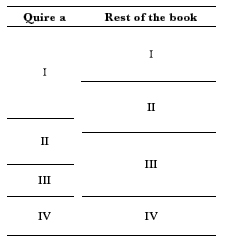 |

The first two impressions of the preliminaries may occur with either of
two
impressions of quires A-D, and the second and third printings of the main
text
can each come with two possible variants of the title page. It was this
ladder-like
asynchrony that led earlier bibliographers to believe that Norton had
printed
simultaneous duplicate settings of the text.
In a given copy, we should not necessarily expect early stop-press variants
of
any one sheet to sort with early states of the others, or later with later,
though
there may be a tendency for this to happen.
37
Appendix 3 indeed shows an es-
sentially random
pattern in this regard.
§12. Phase II
Phase II represents a print run that was probably smaller than the first;
there
are ten survivors, as opposed to nineteen for the first printing. The phase
is com-
plicated by the two sub-phases of sheet A, the products of which consort
with the
other sheets of the book in contrasting ways. Sub-phase IIa is found only
with
Phase II of sheets B-D, and it sometimes occurs with the residue of Phase I
prelimi-
naries. Sub-phase IIb, on the other hand, comes only with Phase II
prelimi-
naries, and one copy (Folger STC 22459.2) even has quires B-D from the
third
phase. These groupings support my earlier assertion that Phase II consists
of two
batches of copies that left the shop at different times, or were at least
sequestered
so they could not intermix. The A sheets may have been a bit
over-printed, as
evidenced by the Folger copy that is hybridized with Phase
III.
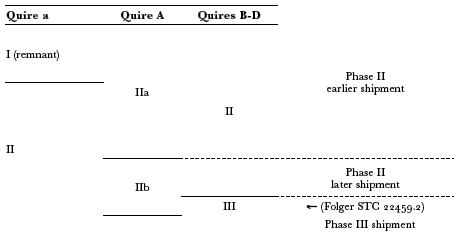 |

Joseph Dane, "Perfect Order and Perfected Order". Papers of the Bibliographical Society
of America
, 90.3 (Sept. 1996), 272–320.
§13. Phase III
This is the phase where the quire D sheets printed by Nicholas
Okes first
make their appearance, in 41% of the surviving copies from
that phase. Most,
though not all, copies come with the title page omitting the
words "of Grayes
Inne". During the course of Phase III we see the skeleton changes
to the outer
forme of quire B that define Phase IIIb of that sheet, as discussed
in §6.
The following table shows the composition of Phase-III copies. The patterns
of
association, based on a very small sample size, are at particular hazard of
be-
ing broken by new copies of ToP that may happen to
emerge, and the following
discussion need to be read with that caveat in mind.
 |
Three copies with quires C and D from Phase III (shaded above) contain
quire "a"
from the previous phase, and one of these also has quire A from the
previous
phase. Because of their residual Phase-II content, they are likely to have
been
among the first exemplars from Phase III to be gathered into complete cop-
ies.
Two of these three copies contain Norton's quire D and one has Okes'.
This
statistically equal representation is consistent with my earlier conclusion
that the
two men's sheets were effectively printed "simultaneously", so were about
equally
available to use in any copy of Phase III.
In §6B, I discussed an imposition of B(o) that I called Phase IIIb. The
five
copies containing it show some puzzling patterns in their makeup. In most
re-
spects they behave like normal copies from Phase III. However, none of them
has
quire "a" from the earlier phase, and all five have quire D in Norton's
printing.
The first point is not especially surprising, given the rarity of Phase
III copies
with quire "a" from Phase II. On the other hand, if Norton's and Okes'
printings
of quire D were equally available to make up those five copies, the
probability
of their ending up only with Norton's is 1/32, or about 3%; so perhaps
this does
call for some explanation. In §6B, I argued that Phases IIIa and IIIb of
B(o) were
perfected in one run with the same inner forme. In the resulting
stack(s) of sheets,
the two sub-phases would probably have remained separate
strata. Hanging the
sheets up to dry could have led to some intermixing of the two
states, but by the
time Phase III copies were assembled, the two sub-phases of
sheet B might still
have had enough spatial segregation to create dissimilar
patterns of association.
If, for example, the IIIb's ended up in a remote stack
and were retrieved late in
the collation process, and if the supply of Okes' quire
D had arrived somewhat
before Norton's and was exhausted first, there could be a
tendency for Phase IIIb

any conclusions about what happened, and with the discovery of more copies the
pattern shown in table 42 could easily fall apart and we would have something
different to explain.
Phase IIIb of forme B(o) also associates with unique states of forme C(i)
and
page D1r:
- C1v has the page number and parentheses displaced about 2 mm to the
right
with respect to other copies of Phase III. - On C4r, in the same forme, the page-number types have moved 4 mm
to
the right. - In both these cases the page-number materials are unchanged except in
position,
and there is nothing to indicate whether the states are earlier or later than their
Phase III cohorts. - On D1r, the italic signature mark "D" shows three
possible positions in the
Phase IIIb copies:
- 2a1: Under the "hi" of "white," in the last line. This is the normal
position
in Norton's Phase IIIa copies, but it is also found in the Phase IIIb copy at the
Bristol Central Library. Line 10 has the misprint "Masqncrs". - 2a2: Under the comma. "Masquers" is now correctly printed, so this state
is
later than the preceding, and the handling required to make the correction may
be sufficient to explain the signature-mark shift. The state is uniquely associated
with Phase IIIb of B(o), occurring in three of the five copies. - 2a3: Under the "w". Line 10 also has "Masquers". This state is found in
the Newberry copy of Phase IIIb, but also in all of Norton's Phase IV sheets, so
it is evidently the latest of the three. Its presence in the Newberry copy prob-
ably results from a slightly short run of quire D which had to be made up from
Phase IV.
The materials and alignments of the headlines are invariant in all of
these
states.
The five copies containing Phase IIIb of quire B are already unusual in
their
B(o) skeleton, but the association of that skeleton with unique states in
two other
quires is unsettling. I cannot imagine an event happening during the
printing of
one sheet that would manifest itself at about the same point during
the printing
of another. The arbitrary realignments in quires C and D are
reminiscent of St.
Catharine's College Z59, with its unique page-number placement
on B4v (§6B);
but here they coincide with the unique skeleton settings of B(o).
Three of the
seven states that appear during this sub-phase improve the readings
found in
their Phase III cohorts,
38
though another (B2v:2c2) actually introduces a textual
corruption
that persists through Phase IV. One is tempted to suggest that the
copies
containing Phase IIIb of quire B are witnesses to a separate production
phase of
the entire book, with no changes except the reset skeleton of forme
B(o),
corrections to D1r, and incidental shifts on C(i). (There were later
deliberate
changes and attendant shifts on B2v, B4r, and D1r.) How the five IIIb
copies

ing mystery.
§14. Phase IV
The latest copies of ToP—those which the title page calls "the
third impres-
sion"—comprise the most homogeneous group in the whole publication
history.
Of the 27 pages in quires "a" and A-C, 24 have settings, impositions, or
vari-ant states that are unique to this printing.
39
The sheets of quire D printed by
Norton for this phase are
characterized by state D1r:2a3, whereas his output
for Phase III contains
D1r:2a1–2. (The latest state of that page also occurs in
the Newberry copy, one of the five from Phase IIIb discussed in the
preceding
section; but we can probably regard this as another instance of an
earlier-phase
copy that had to be completed with a quire from the next phase.) No
unsophisti-
cated copy of Phase IV contains sheets from earlier printings, if we
except Okes'
quire D, which I have argued was likely the product of two separate
print runs
that are now indistinguishable.
The single-leaf "Speech to the King and Queenes Maiesties," alluding to
the
second performance of 13 February, is bound into four of the nine traceable
copies
of Phase IV. Its placement among the sheets would probably have been at
individual
binders' discretion. As a sort of dedication, it could logically belong at
the end
of the preliminaries after Shirley's original dedication; or, as it referred to
an
event later than the first performance documented by the book, it could come
last.
The copies I have seen show two in the first location and two in the other
(and
Greg reported that his copy had it bound after quire a.) Being a singleton,
it
would have been prone to loss, and one does not know whether it was
originally
included with the sheets of all Phase-IV copies or whether it was
available only
for those sold later. I could not find any of its damaged types
elsewhere in the
book, so there is no obvious evidence that it was set soon after
the last phase of
printing. In §16, I will give archival evidence that might have
a bearing on the
addendum, but from the physical evidence it is not possible to
say anything with
greater certainty.
§15. A Digest of the Workflow
In this section I attempt a narrative of the entire production cycle of ToP. It
follows the order of printing the quires in each
phase as far as I have been able
to determine. "Distributed" means the entire page
was broken down and the type
put back in the cases. "Stripped" means that the
skeleton (always the headlines,
and generally the direction lines as far as I can
tell) was removed—either for
distribution or for transfer to another forme—leaving
the bare type-pages to be
tied up for later impression. "Replaced" means that the
tied-up pages, complete
with their previous skeletons, were newly imposed for
reimpression. When all the
pages of a forme were replaced unaltered, I would not
rule out the possibility that
they were still locked in their chase when set
aside.

As it is difficult to assign a significance to transfers of individual types in
skel-
etons, I have mentioned only cases where two or more types in a cluster seem
to
have been moved together.
A. PHASE I
As I demonstrated in §9A, the quires were likely printed in the order B-C-
D-A-a.
Quires B and C have different measures and could have been
composed
simultaneously. Quire "a" has the same measure as quire B and was
possibly
composed with the same stick. English-sized type (20 lines = 96 mm) is
used for
the text throughout.
The three exceptions are B2v:2c2 (which had made its first appearance in Phase IIIb, as just mentioned), a2r:1b2, and C3r:2b.
B outer forme
Pauses for correction: one, affecting B1r only: heading reset
with characters'
names in roman. The same page later incurs damage to ll.7 up and
9 up.
After printing: the stack of sheets is flipped in a
non-standard but explainable
way (§6A), scrambling the states during the
perfecting run. All pages are distrib-
uted except B3r, which is stripped and kept
standing. One piece of type from
B4V reappears in D(o), and parentheses from the
B4V headline are transferred
to the headline of C4r.
B inner forme
Pauses for correction: one: one comma added to B3v, two to B4r.
After printing: all pages distributed. One identified type reappears in D(o).
C outer forme
C4v has an egregiously cock-eyed lockup, the last lines of text bending up-
ward
into a hole left by the omission of some spacers; page number 16 is mis-
printed
"61".
Pauses for correction: three, eventually affecting all of the
pages; one change
deletes a stage direction on C3r
After printing: all pages stripped. The italic songs on C2v,
C3r, and C4v are
removed and distributed, presumably for use in another job but
certainly not for
ToP; the remainder of the text is kept
standing. The fact that C(i), an even richer
source of italic, remains untouched
in this wave of raids shows that the songs in
C(o) may have been taken while C(i)
was on the press and inaccessible.
The unperfected sheets are shuffled in an unexplained manner that results in
an
anomalous distribution of the two states of the inner forme.
C inner forme
C4r headline gets its parentheses from B4V
Pauses for correction: one, correcting a spelling on C1v.
After printing: distributed: C3v, and C2r except most of
ll.5–9. Other two
pages stripped and kept standing. At least one type from the C1v
headline is
transferred to D2v in that quire's outer forme. That is the next one
on the press,

transferred from C4r to D3v (both on inner formes).
Some time before the next phase, C4r l.10 and C1v italic and brackets in
ll.8–10
and last three lines are removed and distributed.
D outer forme
Pauses for correction: one: a word added to D1r, making better
sense but dis-
turbing the first three lines in the process. A bit of type damage
takes place later
on D4V, and still later on the previously disturbed lines of
D1r.
After printing: all pages kept standing with their skeletons.
The unperfected sheets are shuffled in an unexplained manner that results in
an
anomalous distribution of the three states of the inner forme.
This quire is printed a little short.
D inner forme
D3v gets its parentheses from C4r.
Pauses for correction: one, fixing a typo and a misalignment.
It is possible that a small number of sheets printed with D(o) are not
perfected
in this phase, but are perfected with the inner forme characteristic of
Phase II.
(See the discussion of B.L. Ashley
1697 in §8A.)
After printing: D4r distributed, the rest stripped. Some
headline material is
transferred to A(o). That is the next forme of ToP to go onto the press, so the
transfer probably causes at
least a short delay in presswork.
Some time before the next phase, sections of italic are removed from D1v,
D2r,
and D3v, to be used at least partly for setting quire "a". Remainder of text
kept
standing.
A outer forme
A4v gets its parentheses from D3v (same position in forme).
Pauses for correction: none.
After printing: distributed: A1r ll.1–9 and the last; A4v ll.
1–2. Remainder of
text stripped and kept standing.
Some time before the next phase, four lines of italic on A2v-3r are
also
distributed.
A inner forme
Pauses for correction: three, affecting spelling and commas.
After printing: A1v and bottom half of A2r distributed (from
"These moving
forward ..." to end); other pages stripped and kept standing.
"a"
The dedication (pages a2r-v) contains italic raided from D2r and 4r. All
three
pages of preliminaries are imposed together and printed by work-and-turn.
There is
no evidence of the use of bearer types on blank a1v. Most likely, each
sheet is
perfected immediately.

Pauses for correction: one, correcting a typo on a2v. Part-way
through the cor-
rected state, the "O" in l.3 of the title page suffers
damage.
After printing: acorns and direction line stripped on a2r,
otherwise all type-
pages kept standing.
The number of sheets printed, on the evidence of surviving copies, is about
20%
greater than those of the other quires.
At this point, the products of Phase I either leave Norton's shop or are pack-aged
and remain unmixed with later printings. A few sets of sheets apparently
linger
without quire D, which was printed a bit short.
Meanwhile, composition is proceeding on another unidentified job or jobs
which
cause italic passages to be removed from the standing type in quires A,
C, and
D.
B. PHASE II
The sequence of quires in this phase is less certain than for Phase I (see
§9B).
The history is complicated by the two sub-phases of quire A, and there is
no
evidence for the position of quire "a" in the sequence because after Phase I
it
has no typographic interaction with the other quires. I have placed it last
below,
as it was normal to print the preliminaries after finishing the text.
C outer forme
Preparation for printing: italic songs on C2v, 3r, 4v reset.
On the latter page,
Song 5 and its title are set in pica (20 lines = 82 mm, with
the title in roman;
the title "Song 3" on C3r is also in pica). All new skeletons.
The distortion of the
last line on C4v is remedied.
The use of pica type on C4v probably indicates a shortage of the english
size,
which is the default for ToP. The use of pica roman
for the title "Song 5." may
be deliberate, to match the type of the song itself;
but it also creeps into the title
on C3r, where the song itself is reset in
english.
Pauses for correction: none. The page number on C1r shows some looseness.
After printing: all pages stripped and kept standing. None of
the headline mate-
rial shows up in the other quires.
C inner forme
Preparation for printing: C1v (italic and brackets, ll. 8–10,
and last three lines)
and C4r l.10 reset. Other minor adjustments to 3v and 4r.
All pages reimposed
with new skeletons.
Pauses for correction: none.
After printing: C1v: italic and brackets in ll. 1–10 and last
four lines distrib-
uted. Otherwise, all pages stripped and kept standing. None of
the headline
material shows up in the other quires.
D outer forme
Preparation for printing: pages replaced along with their
original skeletons. The
damage to the first three lines of type on D1r, already
disturbed, probably occurs

ing (§8A).
Pauses for correction: none.
After printing: D1r distributed; all other pages stripped and
kept standing.
Some headline material from D1r, 2v, and 4v is transferred to the
same posi-
tions in A(o).
Some time before the next phase, two stretches of type are distributed: D2v
ll.18
through the end of the page, and the italic song on D3r.
D inner forme
Preparation for printing: D4r reset; five-line stage direction
at the top of D1v
reset in roman; raided italic portions of D2r and 3v reset in
the same italic font.
All new skeletons.
Pauses for correction: none. It appears that a residuum of
sheets printed with
the outer forme from Phase I are perfected with this
batch.
After printing: all pages stripped and kept standing except
for the following,
distributed: D1v (all); D2r italic song ll. 1–8 only; D3V roman
section. Headline
parentheses from D4r are transferred to A4r (inner forme).
A outer forme Phase IIa
Preparation for printing: the following are reset: A1r ll. 1–9
and last; A2v-3r,
four lines of italic (set in great primer size, 20 lines = 120
mm.); A4v ll. 1–2.
Textual revision to A3r.
All new skeletons, including the rule on A4v, but omitting its catchword;
the
lines of acorns on A1r may be new. A2v headline gets its parentheses from
D2v.
Pauses for correction: none. The catchword on A2v goes
gradually out of align-
ment. Printing is halted before all sheets of this forme
are machined.
After printing: all pages stripped and kept standing. Some
headline material
from A1r, 2v, and 4v is transferred to the same positions in
B(o).
After a delay, apparently to allow other work to play through, it appears
that
Norton decides to perfect this partial run of sheet A rather than complete
the
Phase-II impression of outer-forme sheets.
A inner forme Phase Ila
Preparation for printing: A1v, and bottom half of A2r (from
"These moving
forward ...") reset. Commas added on A4r. All new skeletons,
including the row
of ornaments on A3v. A4r headline gets its parentheses from
D4r.
Pauses for correction: none. A4r shows looseness in l. 7.
After printing: all pages kept standing: A1v stripped, the
others with their
skeletons.
If Norton's strategy at this point is to rush out as many copies as he can
with
the partial run of sheet A, the logical next step is to machine the two
remaining
quires before returning to complete the impression of A:

B outer forme
Preparation for printing: B1r, 2v, 4V reset; B1r has 28 pairs
of acorns, with two
inverted. On B3r (reimposed), rewriting of the tavern
direction from one to three
lines forces the last four lines of type on this page
onto the verso. B2V gets its
entire headline from A2v.
Pauses for correction: none. On B4v l. 2, the last two letters
of "coold" are lost
in two stages.
After printing: all pages stripped and kept standing. B1r
loses its acorns along with
the page number. The four overflow lines of type from
B3r are respaced to three
lines and transferred to B3v, which is therefore
probably being reset at this point.
B inner forme
Preparation for printing: all pages reset. B3v starts with the
three overflow lines
of type from B3r, but the page break at the bottom is kept
unaltered by reducing
leading and running a stage direction into a dialogue
line.
Pauses for correction: one: page number on B4r is reset
part-way through. There
is a confused series of seemingly accidental variants
(§6C). One copy also has
page number on B2r set in a font not seen elsewhere.
After printing: all pages kept standing with their skeletons.
At this point Norton would be able to assemble a certain number of
Phase-II
copies using the remainder of quire "a" from Phase I. He might now return
to
print further copies of the preliminaries with some revisions:
"a"
Preparation for printing: title page realigned; direction line
and acorn pairs
(27) on a2r newly set; comma added on a2v. The forme is printed by
work-and-
turn.
Pauses for correction: none.
After printing: all pages kept standing.
At this point Norton can assemble further complete copies, exhausting the
supply
of sheet A from Phase IIa. Unlike the previous batch, these copies all
contain
sheet "a" from Phase II. Now Norton returns to complete the Phase-II
impression of
sheet A:
A outer forme Phase Ilb
Preparation for printing: all new skeletons. A2v catchword
marries with first line
of roman on next page. (That is the third line of text, so
the workman evidently
overlooked the two short lines of italic that begin the
page). Some quads left up
on A4v.
Pauses for correction: none.
After printing: all pages kept standing: A3r and 4v with their
skeletons, A1r
and 2v without.
A inner forme Phase IIb
Preparation for printing: A1v gets new skeleton; other pages
replaced with their
skeletons, but A3v page number shifts.

Pauses for correction: none.
After printing: all pages kept standing with their skeletons.
This brings the print run of quire A equal to those of the other text quires,
and
the last copies from Phase II can be sent to the warehouse, uniquely contain-
ing
quire A from Phase IIb. There may actually be a few copies of sheet A left
over:
one surviving copy from Phase III contains quire A from IIb.
C. PHASE III
The sequence of printing the quires in this phase is indeterminate, though
rather
more likely to have been in scrambled order. I give it here in the
order
A-B-C-D-a.
A outer forme
Preparation for printing: A1r and 2v get new headlines; A3r
and 4v are replaced
unaltered, but in the process the quads on A4V get
lowered.
Pauses for correction: one? On A3r, one copy shows
displacement and damage
at upper left, and slight displacement of the skeleton
elements. Possibly during
the act of repairing the damage, the "3" goes missing
from the signature mark.
The page number on A1r prints indistinctly or not at
all.
After printing: all pages kept standing: A4V probably keeps
its headline but
loses the rule; the others are stripped.
A inner forme
Preparation for printing: all pages replaced unaltered.
Pauses for correction: one: the famous "bride/bridle" correction on A1v.
After printing: all pages stripped and kept standing. Some
headline material
appears in the same positions on C(i).
B outer forme Phase IIIa
Preparation for printing: all pages get new skeletons; B1r
receiVes 25 pairs of
acorns, with endpieces. Headline parentheses on B4V are the
same as on D4v. In
the process of reimposition, some disturbance and damage occur
on B1r and 2v,
and the catchword is left off of 4v.
Pauses for correction: none. One copy shows a page-number shift on B4V.
After printing: all pages stripped and kept standing. B1r
loses its acorns along
with the page number.
This printing of B(o) is somewhat short with respect to the other text quires
in
Phase III—something prevents Norton from machining the full white-paper
stack. He
will complete it when he has dealt with whatever has caused the inter-
ruption.
Meanwhile, he strips the outer forme of B and puts it aside. The situ-
ation is
similar to the interruption in the run of quire A in Phase IIa, but here
only the
outer forme is affected and both sub-phases are backed up with the same
state of
the inner forme. Once again it is illogical for Norton to strip the skeletons
if
he expects to resume presswork soon. Nevertheless, after a presumably short

completing run, which constitutes Phase IIIb of the outer forme:
B outer forme Phase IIIb
Preparation for printing: all pages get new skeletons; B1r
gets 28 pairs of acorns,
all properly oriented. Typo on B1r gets corrected. The
tavern direction on B3r is
rewritten from three lines to one again and positioned
flush right.
Pauses for correction: one: on B4V the word "stndy" in l.13 is
corrected, after
a fashion, by turning the "n" upside-down. Perhaps as an accident
during this
operation, the comma after "Laughter' on B2V,
l.23, goes missing.
After printing: all pages kept standing; B2v keeps its
skeleton, the others are
stripped. B1r loses its acorns along with the page
number.
Phases IIIa and IIIb of B(o) are now perfected together:
B inner forme
Preparation for printing: all pages reimposed along with their skeletons.
Pauses for correction: none.
After printing: all pages distributed. Headline parentheses on
B3V are the same
as on C2v, which indicates that either C(o) does not follow B(i)
directly, or there
is a short delay between the stripping of B(i) and the
imposition of C(o).
The five surviving copies containing B(o) from Phase IIIb all contain Norton's printing of quire D, and most show displacements of skeleton types on C(i) and D(o). I am not able to explain the coincidence of these particular variants in this cohort.
C outer forme
Preparation for printing: all pages reimposed with new
skeletons. C2v shares
some headline material with B3v.
Pauses for correction: none.
After printing: all pages kept standing with their skeletons.
C inner forme
Preparation for printing: C1v: italic and brackets in ll. 1–10
and last four lines
reset, dropping the third line from the bottom; the italic is
face i-i; first letter of
"Invention" lowercased, l.6 up. C2r reset except for
most of ll. 5–9. C3V reset,
with italic sections in alternative face i-2. Some
respacing on C4r.
Pauses for correction: none. For reasons still unclear, the
copies bound with
B(o) in Phase IIIb show page-number shifts on C1v and C4r
(side-by-side in the
forme), and the comma at the end of C4r l.6 shifts right.
After printing: all pages kept standing, C1v and 4r with their
skeletons, C2r
and 3v without.
By this point in the production, Norton eVidently has made an arrangement
with
his partner Nicholas Okes to divide the job of printing
quire D. (For the
possibility that Okes was an unwitting
collaborator, see §8B.) Okes composes
his own setting of those eight pages using
his own type. Each man then prints
roughly equal numbers of the quire for Phase
III. Some of each man's sheets are

appears on the title page after Shirley's name; one of these copies, with Okes'
quire D, also contains Phase IIb of quire A. From these groupings, it appears that
each man's production was equally available for assembling the first copies from
Phase III, so their work on this quire was effectively simultaneous.
D outer forme (Norton)
Preparation for printing: D1r reset. D2v ll. 6–7 respaced to
one line, and bot-
tom half of page reset beginning with l.17. Italic portion of
D3r reset in alterna-
tive italic i-2. On D4v, l.4 respaced. New skeletons all
around; D4v shares some
headline material with B4v.
Pauses for correction: one, correcting spelling and
punctuation on D1r and ap
parently causing a signature-mark shift.
After printing: all pages kept standing with their skeletons.
This printing of quire D is probably a bit short, as one surviving copy
from
Phase III was apparently completed with quire D from Norton's final
state
(D1r:2a3).
D inner forme (Norton)
Preparation for printing: D1v reset. D2r ll. 1–8 reset in the
default italic (i-1).
D3v roman section reset, and the word "Proclayming", l. 4 up, gets a lowercase
first letter (incorrectly, as it
follows a period).
D2r, 3v, and 4r are reimposed with headlines set in pica size; D4r
lacks
catchword, and word-spacing of l. 3 and last three lines shifts a bit.
Because the
headline on D1v is a different size from those of the other three
pages, it was
evidently set in a different operation, probably during the
resetting of the text.
The use of pica for the other headlines could indicate a
shortage of english-sized
numerals and parentheses, but more likely the workman
simply dipped into the
wrong case. The direction lines of all four pages are set
in the correct size.
Pauses for correction: none.
After printing: all pages kept standing with their skeletons.
Quire D (Okes)
Preparation for printing: all pages newly set.
Pauses for correction: none.
After printing: all pages kept standing with their skeletons.
Some complete copies of the book are probably made up at this point, using
up the
leftover preliminaries from Phase II and containing Okes'
and Norton's quire D indiscriminately.
"a"
Preparation for printing: "of
Grayes Inne
," is removed from the title; motto
re-
spaced to two lines to compensate; spacing of imprint slightly disturbed. a2v
loses
the rule below the signature, which may therefore have been treated as part
of
the skeleton. The headline, however, is unchanged. On a2r, leading is adjusted

process, the loss of a spacer after "and" in l.3 causes a gradual rightward drift
of the first two words in the line.
The forme is printed off by work-and-turn.
Pauses for correction: none.
After printing: on a2v, "The humblest ... Shirley." stripped;
all pages otherwise
kept standing unaltered.
On the evidence of surviving copies, quire "a" has a print run sufficient
to
supply all copies from Phase III. The remainder of the third printing of ToP can
now be collated and shipped.
D. PHASE IV
Products of this last phase of work are the most uniform. All copies have
"The
third impression" on the title page. Although most of the formes underwent
ex-
tensive alteration, or even resetting, before printing began on each, there
were no
stop-press alterations thereafter. The only complication is the existence,
carried
over from Phase III, of the two settings of quire D printed by Norton and
Okes.
These occur in eight and six surviving copies
respectively.
In light of the evidence that there were four main work phases, and B(o) and
all
of quire A seem to have had five printings each, we need to take Norton's
final
claim of three "impressions" with a grain of salt. We cannot know whether
Nor-
ton actually believed this, whether the various starts and stops in the work
cycle
caused him to lose count, or even what he understood as an "impression". In
the
period 1600–40, the word was used on title pages essentially
synonymously with
"edition", but only one-fifth as often. One finds it most
commonly on title pages
of devotional works that went into many settings, like
Arthur Dent's Plaine Mans
Path-Way to Heaven; but the title
pages of Shakespeare's second and third folios
also
identify them as later "impressions". Norton himself used the term in
1624
(STC 25090a, in a collaboration with Augustine Mathewes), 1633 (23503),
1634
(twice, 3129a and 22459b [ToP]), and
1637 (20274); all of these except Triumph
of
Peace were completely new settings. It is likely that, in the case of ToP, Norton
was basing his count of impressions on the
changes of title-page wordings which
would have been noticeable to contemporary
readers: states 1a1 and 2, which
contained "of Grayes
Inne"; 1b, lacking those words; and ici and 2, the avowed
third
impression.
Phase IV seems to have followed Phase III rather closely, as some types
from
distributed portions of III turn up in IV. These types evidently remained
near
the top of their compartments in the type case without moving off to other
jobs.
The recurring types within this phase (see §9D) show that quire B inner
forme
(which had been distributed after Phase III) was reset after the last copies
of quire
A outer forme came off the press; and D(o) contributed one type to B(o).
For the
account below I have followed the order A-C-D-B-a.
In this phase, a new paragraph added to A2r causes a change of page
breaks
through the rest of the quire.

A outer forme
Preparation for printing: all pages reimposed; A4V probably
retains its headline
but gets a new rule and regains its missing catchword. A1r:
heading slightly re-
spaced and the leading removed between it and the text. A2V
receives the last
three lines of text from the preceding page, reset; its last two
lines of type are
moved to the top of A3r. A3r: one textual correction; last three
lines removed
and transferred, probably immediately, to A3v in the inner forme.
A4v: last four
lines from previous page reset and added at top; l.2 up, "variety"
changed to
"uariety".
Pauses for correction: none.
The text of ToP, especially in the later phases, shows
struggles with the letters
u and v. These resulted from orthographic changes
taking place in the printing
trade around 1630–35. Prior to this, the
two graphics were variants of the same
letter, which was used to denote the sounds u and v indiscriminately. The letter
took the v-form
at the beginning of words and the u-form elsewhere. Hence the
words "beauty" and
"variety" used the graphics as we do today, while "every"
and "unless" were
rendered as "euery" and "vnlesse". Within the space of a few
years, the English
printing trade converted nearly universally to the modern us-
age, but for some
compositors this must have been a period of confusion. Thus on
A4v of ToP in Phase IV we find, in the same line, the aberrant spellings
"beavty"
and "uariety".
A inner forme
Preparation for printing: on A2r, the addition of a new
paragraph of three lines
after the first one leads to the following
dislocations:
A2r: last three lines of text removed and distributed. (The text has already
been
incorporated, reset, on A2v in the outer forme.) For no apparent reason,
the
bottom half of this page is again reset from the line beginning "These mov-
ing
forward". (This same portion of text received an arbitrary resetting
between
Phases I and II.)
A3v: receives the last three lines of type from A3r in the outer forme.
These
force the last four lines of type to the top of A4r.
A4r: receives the four lines of type from A3v. These force out its last four
lines,
which have already been incorporated, reset, in A4v in the outer forme.
There is one spelling change on A3v. New skeletons all around.
Pauses for correction: none.
After printing: headlines removed and transferred to B(i); the rest distributed.
C outer forme
Rewriting of the text on C1v and 2r leads to some altered page breaks.
Preparation for printing: all pages restored with their
skeletons from Phase III.
C1r: four lines of roman at top reset in pica, perhaps
to relieve crowding. C2v:
first two lines removed and probably distributed; blank
line added above direc-
tion line to compensate. C4v: spelling correction.
Pauses for correction: none.

C inner forme
Preparation for printing: text revised and shortened on C1v;
to compensate, the
setting of the first two lines on the next page is transferred
in type to the bottom of
this one. More revision to C2r, and two lines of text
brought over from the verso
in the outer forme (probably reset). C3v: improvements
to spelling and leading.
C4r: spelling correction. C1v and 4r retain their
previous skeletons, though 4r
shows a slight page-number shift; new skeletons for
C2r and 3v.
Pauses for correction: none.
As in Phase III, both Norton and Okes contribute sheets of quire D to this
final
printing. The sequence below assumes that Okes machines his Phase-IV
sheets in a
separate printing, though his two impressions are indistinguishable.
D (Norton)
Preparation for printing: all pages replaced with their
skeletons, but the signa-
ture mark on D1r shifts about 5 mm to the left. This is
the only feature distin-
guishing this phase of Norton's quire D.
Pauses for correction: none.
D (Okes)
Preparation for printing: all pages replaced with their skeletons.
Pauses for correction: none.
Apparently, some D sheets from this impression are used to complete copies
from
Phase III.
B outer forme
Preparation for printing: B2v replaced unaltered from the
previous phase; the
others get new skeletons. B1r gets a heading of 26 pairs of
acorns with an end-
piece on the right only. The bottom of B3r receives the first
three lines of text
from B3v, reset, apparently to relieve an imbalance; the
tavern direction revised.
B4v: last two lines of italic reset in pica.
Pauses for correction: none. At various points during
printing, the page numbers
shift on B1r, B2v, and B4v.
B inner forme
Preparation for printing: all pages reset, with pica roman
used for the directions
for gentleman and beggars on B3v. Headlines transferred
from A(i) with numbers
unchanged.
Pauses for correction: none.
"a"
Preparation for printing: title page: "The third impression."
added above motto;
probably as a consequence, leading adjusted elsewhere, and ll.
1, 4, and 7 re-
spaced; the line "February the third, 1633." reset,
with a period in place of the
comma; "Gent." in authorship statement replaced with
"of Grayes-Inne,", with
accidental omission of the "Gent.".
On a2v: "The humblest ... Shirley." newly
set. The forme
is printed by work-and-turn.



Pauses for correction: one, restoring "Gent." to the end of
the authorship
statement.
"A Speech to the King and Queenes Maiesties"
Printed an undetermined period after the main book, with no variant states
found
in five examples. It is not found in surviving copies from before Phase IV;
I
cannot say whether all copies from the last impression originally contained it.
Phase IV of The Triumph of Peace brings us to the end of a
process that left
behind artifacts of a bibliographical complexity unsurpassed, in
my experience,
for a book of its modest length. Once the last copies were sold,
the masque stayed
out of print for the next two centuries.
40
§16. When, How Many, and How Fast?
I have argued that the complexity of ToP shows the printer's
response to a
high but short-lived demand for a text, so it behooves us to ask:
were they first put
on sale, how many copies were printed, and how long did it
take to print them?
Although ToP is the most thoroughly
documented stage production before 1640,
the archival record fails to
give straightforward answers to these questions. The
relevant documents are as
follows:
41
- 17 October 1633: a letter from Thomas
Coke to his father Sir John mentions
that the King had requested the masque "about a fortnight agoe". "Who is the
poet or who makes the maske dance I doe not yet understand." 42 We do not know
whether Thomas was simply not privy to the decision process, or whether the
organizers had not yet picked their poet. But if his chronology can be trusted, the
members of the Inns had only four months to find a writer, commission music,
construct sets and costumes, learn the parts, and pull it all together. No wonder
that Coke, in the same letter, reports "no law studied in the Ins of Court now all
turnd dancing scools". -
Bulstrode Whitelocke, in his Memorials of the English Affairs, gives an even
shorter timeline, dating the original idea ofthe masque to "about Allholantide"—
so, around the beginning of November, with three months to prepare. 43 - 17 January 1634: Shirley is
admitted to membership in Gray's Inn. This honor
is recorded on the earliest states of the title page of ToP, so it would seem to
provide a terminus post quem for the first printing. However, I have suggested in
my discussion of the title-page variants in §4A that Shirley's claim to the honor
might have anticipated its actual granting, which created an embarrassment that
led to the subsequent deletion of "of Grayes Inne" from the title pages of Phase
II of the preliminaries. So, this timepoint could be less significant than it seems.
It is possible, however, that his actual admittance was contingent on delivery of
the completed manuscript. - 24 January: the publisher William Cooke brings
a copy of ToP to Stationers
Hall for license and registry. The entry, signed by Cooke, reads "Entred for his
copy under the hands of Master Attorney Sir John ffinch and Master weaver
warden The maske of the four Inns of Court with the Sceane as it is to be presented
before his Maiesty at Whitehall the third of ffebruary next." (Finch was one of the
eight members of the main committee overseeing the masque, and one of two
from Gray's Inn. Edmund Weaver was the Stationers' Company official who
recorded the entry.) The wording of the entry shows that the clerk, as we would
expect, was looking at a manuscript rather than the printed book. It is entirely
possible that Norton was already hard at work on ToP, but a scrupulous printer
(which Norton was not) would have waited until entry was completed. - 3 February (first performance): a warrant is issued for payment of £15
to
"mr Sherley poett for the Masque in full of his gratuity". 44 Fifteen pounds re-
presents the Middle Temple's quarter-share of the total amount: expenses for the
masque were borne equally by the four Inns of Court. So, on the day of first
performance, Shirley is authorized to be paid £60 in full for the text. However,
a further warrant of 21 November 1634 requests £5 for Shirley on behalf of the
Middle Temple, its share of a total additional payment of £20. 45 No reason is
given for this warrant; either the the Inns decided on a bonus to the handsome
original fee, or it involves compensation for writing the epilogue "A Speech to the
King and Queenes Maiesties", which was added to copies of the last printing of
ToP. In either case, we are still lacking pieces of the puzzle, for Shirley's eighteen-
line addendum was certainly not worth one-third of the whole masque text. A
general accounting of all expenses for the masque complicates matters further by
recording a total of £100 paid to Shirley. 46 The accounts often present this sort of
confusion. Even the second warrant's November date offers no evidence bearing
on the printing of the epilogue, for the warrant belongs to a group of late settle-
ments for services that were mostly rendered in February 1634 or earlier. -
John Finet, in his undated memoirs,
47
describes both performances of ToP
and mentions "the description of the Maske since being printed". This seems to
mean that the book was not finished even by the time of the second performance
on 13 February. But drawing a definite conclusion from Finet's wording runs the
risk of being over-literal. - Between 3 and 13 February: Justinian Pagitt
writes to his cousin Tremyll,
48
"I
have sent you a booke of our Masque which was presented on munday last." So,
the second performance had apparently not yet taken place. At the time of writ-
ing, Pagitt was a member of the Middle Temple in his early twenties, and he rode
in the procession introducing the first performance. We cannot say for certain
that the "booke" he sent was a printed copy, but it would seem extravagant to
prepare a 7500–word manuscript to send away to a cousin. All of the surviving
eyewitness accounts focus on the visual and social aspects of the performance;
none mentions the qualities of Shirley's text. - 19 February: William Gawdy writes to his father
Framlingham, sending him
a copy of "the booke". 49 William, aged about 22, had used family connections
to get a ticket to the second performance. Again it is not certain that he was
sending a printed copy, but the combination with Pagitt's letter adds to the evi-
dence that the book had come out at least by mid-February. If manuscripts were
circulating, Pagitt and Gawdy would more likely refer to them as "copies" than
as "books". 50 Furthermore, neither man is known to have had direct access to
Shirley, and it was only from Shirley or the very few organizers of the event that
complete transcriptions of the masque could legitimately have been had. (Even
the actors would have received copies only of their own parts, with cues.) The
circumstances of the masque made it ideal for publication, and it was in nobody's
interest to cut into potential profit by encouraging scribal circulation. - 21 November 1634: John Herne, disburser of funds for the
masque, issues
a warrant for 25s. payable to "mr Wakelye—printer". 51 This figure represents
the Middle Temple's quarter-share of a £5 payment to the book wholesaler (not
printer) Thomas Walkley, who was evidently acting as middleman between the
Inns and the publisher William Cooke. As with Shirley's fees, we do not know
precisely what this payment was meant to cover, and the date of the warrant
probably has little relation to the dates of services rendered.
From a marketing standpoint, it would have been ideal to have the printed
book
available the day of the first performance, if not a few days before. Milit-
ating
against that were the short timeline from the conception of the masque to
its
performance and the inevitability of many last-minute changes, particularly
in the
procession. Whitelocke's memoirs tell of adjustments made to head off
squabbles
over matters like precedence and color schemes.
52
Such frictions must
have been constant, especially in the
staging of a masque that dealt so overtly
with class conflict.
53
In §9A, I showed that the first
impression of quire A, which

Hall, was printed after the text of the masque itself, comprising quires B-D. This
sequence probably reflects the order in which the sections arrived at Norton's
shop. A professional like Shirley would first compose the more laborious liter-
ary portion of his commission, then turn to the reportage. Small changes to the
latter could be incorporated up to, and even during, the printing of the quire
containing it. 54
Printed masques conventionally preface the main text with a description of
the
set design in the past tense, and the title page almost always gives an exact
date
of performance. These features create a framing device that presents
the
performance—usually the only one—as a fait accompli.
This convention might
have no more value in dating the publications than a
condemned criminal's "last
words", which might be already printed and available at
the public execution.
55
But there
is no more reason to suppose that masques were printed in advance of
their
performance than there is for any other type of dramatic text. Specifically,
we
have no evidence that the first printed ToP was available
before or at the first
performance, but we have good reason to believe that it
came out shortly after-
wards, even before the second performance.
As to how many were printed, there is no archival record. In fact, we have
almost
no figures for the edition size of any early Stuart dramatic text. The only
report
for a play that I am aware of is 1500 copies for the second edition of
Beau-
mont's Philaster (1622, STC
1682), but Peter Blayney cited this as an
optimistic
response to an unusually successful first edition, and therefore
atypical.
56
David
Bergeron found that the print runs for the Lord
Mayors' shows in the 1630s gen-
erally ran 300–500,
57
but neither the genre nor the
intended readership of these
brief accounts compare closely with those of a play
or masque. Edition sizes of
non-dramatic works that emerge in archival sources
vary widely, and since the

ing, we need to exercise caution in treating the figures as normative.
In the absence of relevant archival records we can draw our evidence only
from
the number of surviving exemplars. I have been able to locate 55 reason-
ably
complete copies of ToP (which I define as lacking no more than
one quire).
This represents an average of 13.75 copies per printing. I performed a
survey of
39 editions of other individually printed masques catalogued in ESTC.
These show
an average survival rate of 10.64 copies per edition (σ = 5.84; in
contrast to ToP,
none of them shows evidence of reprinting
from standing type). One is tempted,
then, to suppose that ToP's average print run was somewhat higher than average
for a masque. It
was also unique in running to four impressions; only Chapman's
Memorable Maske, Campion's Discription of a Maske,
Heywood's Loves Maistresse, and
Daniel's
True Discription of a Royal Masque went into a second edition
before 1640.
We could extrapolate from our reasonably hefty sample to
conjecture that the four
printings of ToP yielded a total
of about 1.3 ˙ 4n copies, where n is the
average
print run for a masque and 1.3 is the factor by which the average print
run of ToP appears to exceed that of an average masque.
However, these figures rest on shaky
foundations. For several reasons, ESTC often
fails to list all known copies of an
edition. This incomplete reporting could
magnify the apparent disparity between
ToP's numbers and
those of other masques which have not attracted as much scru-
tiny. Even if the
factor 1.3 is valid, the higher-than-average survival of ToP
could be
partly the result of higher retention rates due to the masque's
contemporary fame.
And because we have no good evidence for the normal print run
of a masque, as-
signing a value to n in the equation above
is a very subjective process.
The relative sizes of ToP's four printings are also hard to
fix. If we use quire C
as the most stable marker of which phase a particular copy
of ToP comes from,
the numbers of survivors are 19, 10, 17,
and 9 respectively. By the time I was
reaching the 50-copy mark, I assumed that
the relative distributions had stabi-
lized. But I was surprised when, late in my
investigations, several more copies of
ToP emerged and most
of them clustered in Phase III. This skewing of the data
scuttled my preliminary
conclusion that a large first printing was followed by
three approximately equal
but smaller ones.
Is the spread in the survival rates of the four printings of ToP statistically significant? Suppose we assume that each production phase
yielded the same
number of copies. A random sample from the entire printing
history should yield
approximately equal numbers from each printing—again, 13.75
in our case. Out of a sample of 55, the chances of drawing 19, 10, 17, or 9 copies of
any one print-
ing would only be about 3, 6.6, 7.1, and 4% respectively.
58
So, the dispersion ap-

were larger than the second and fourth, perhaps by a factor of 11/2 to 2.
The temptation to estimate the print runs from these admittedly wobbly
figures is
a powerful one, as some of my respected predecessors have demon-
strated with
recourse to even skimpier data. I hope that the disclaimers above
will safeguard
any speculations I make from hardening into claims if they are
quoted later. I
will guess that the anticipation generated by the run-up to ToP's performance led Walkley or Cooke to set the initial print order
optimistically
at 1200 copies. Perhaps they would have gone higher had it not been
for the
Stationers' Company restriction. The three remaining printings might have
con-
tained 750, 1000, and 750 copies respectively, yielding a total of 3700
copies, or 16,650 sheets.
59
The printed masque, to my thinking, was a nine-days' wonder that the text
alone
could not sustain once the impact of the public spectacle faded. How
long did the
interest last, and how long did it take Norton to produce the four
printings? We
can start by estimating the time required for the first printing.
The initial
setting contained about 24,800 ens of visible text type, not including
skeletons
and display text. Donald McKenzie, in his The Cambridge University Press
1696–1712 (Cambridge: University Press, 1966), cites an exceptional
typesetter
who averaged about 10,600 ens per day over a five-week period in 1702,
but a
more normal rate was 6,300 ens for that compositor, and usually lower for
other
individuals.
60
In January
1634, John Norton had two apprentices, the
senior one
having close to seven years' experience.
61
We have no evidence that he also
employed a
journeyman, but recall from �8B that a document dated one year
later charged Norton and Okes with hiring illegal
workmen unaffiliated with the
Stationers' Company. This allegation makes it
impossible to estimate the number and skills of workers thatNorton
could potentially put onto a job. But let us as-
sume that
either Norton or his senior apprentice, working flat-out,
were capable
of setting 10,000 ens per day. Based on this rate, the undistracted
composing of
ToP should have occupied two and a half
man-days. So, typesetting should not
have been a bottleneck in getting ToP onto the market.
Presswork went slower than composing, for a comparable amount of text. In
the
case of the Cambridge Press, McKenzie found that "an output of well over
1000
perfected sheets a day from a full-press [employing two men] was quite
regularly
achieved and sustained for lengthy periods."
62
ToP comprised four and

copies for the first printing of ToP, a full-press dedicated to the one job should
have taken about five and a half days—just short of a regular work-week—to
machine the nine formes of ToP, not counting the time to change the formes. If
Norton delegated two men to the press and one man to composing (and distrib-
uting, for the first italic raid), he should have been able to complete Phase I with a hard six-day week's work plus an extra day or so. Of course, preparing for
the job—making design decisions, casting off copy, readying the paper, cutting
frisket sheets, and the like—would have taken some additional time. But one can
imagine Norton receiving copy as late as the day of registry—24 January—and,
if necessary, having finished books from Phase I available very shortly after the
first performance nine days later.
The later printings, since they re-used standing type to varying degrees,
de-
manded much less composition time. Norton's shop set
24,800 ens for Phase I;
Phase II involved the resetting of about 9680 ens, Phase
III (including its sub-
phases) 3960, and Phase IV 4110. Nicholas Okes had to set 6220 ens for his
Phase III quire D; then his
Phase IV was either an unaltered reimpression or was
printed as part of Phase III.
I have figured his total press time as the same either
way. Using my thoroughly
unreliable edition sizes, and the rates of work given
above—setting 10,000 ens a
day and printing 1000 sheets a day—and rounding up to the half-day, we arrive at the
following approximate figures:
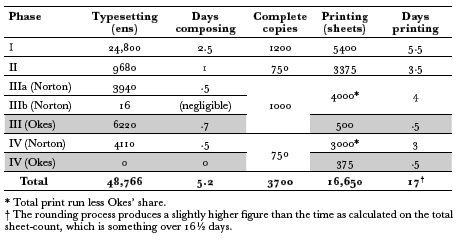 |
So, the entire production cycle of ToP required a little less
than one man-
week of composing, and somewhat less than three weeks at full-press.
Of course
these calculations cannot give an actual total. We assume, for instance,
that com-
posing and presswork often went on simultaneously—a sensible
apportionment
of labor in Norton's small shop would be
two men printing and one composing.
His partner Okes
could have been working concurrently on his share, so his

my estimates of the print runs could be too high. All of these factors would com-
press the computed time required to print all the copies. It is worth noting that
the imprint date remains 1633 in all four impressions. For this publication Nor-
ton was using the legal calendar, in which the year date changed on Lady Day
(25 March). If the fourth printing of the ToP preliminaries began after this day,
he would have had some motivation for advancing the year date to emphasize
the book's currency. But this would have been a small improvement, and we have
seen that Norton's attention to detail was fitful at best. Still, we can say with some
confidence that Norton could not have turned out all four impressions of ToP in
less than three or four weeks.
This is a best-case estimate, and I have not factored in some contingencies
that
must have dilated the history. For instance, besides the preliminary jobs
al-
ready mentioned (design, frisket cutting, etc.), I have omitted the time
required
to compose the title page, other display lines, and skeletons. Every
setting or
resetting implies a distribution; because that job can be put off
indefinitely, or
run concurrently with printing, I have ignored it in my
calculations. Most impor-
tantly, the later italic raids show that Norton had one or more other jobs in train
along with ToP, as was normal in printing shops. Since I have not been able
to
identify these jobs, I cannot gauge their impact on the ToP history.
The paper evidence, on the other hand, serves to constrain the timeline. I
have
assembled watermark information, in more or less detail, for three-fifths of
the
copies of ToP as well as (mostly single copies of) fourteen of
the twenty-seven
publications Norton put his name to in
1633 and 1634. Among this group, ToP
is almost unique in having one type of mark that I have not found named
or
described anywhere. In one version, it is a fat spindle with pointed or
slightly
rounded terminations; in the other, one end of the spindle is either a
full semi-
circle or softly flattened into a broad but still curved base, the
other end being
pointed. (Figure 4 gives slightly idealized renderings.) All
varieties have a sinuous
line inside, running roughly down the long axis, usually
connected to the spindle
at the sharper end and sometimes terminating in a loop
inside. Most of the forms
have an additional short line coming out of each end,
often with its own termi-
nating loop. I have found eight spindle variations in
ToP, and in Phases I-III of
quires A-D it is the dominant
type of mark. Second most common is a hand, usu-
ally containing the initials "PD"
(four varieties). Another has initials "GM", and
in a sixth variety the initials
are lacking or illegible. The hands all have a flower
or a grape cluster at the
fingertips. The third type of mark includes six varieties
of pot, two containing
the initials RP or RF. One of these may have a handle and
might therefore be
called a jug. Finally, there is one example of a broad mark
(over four
centimeters) of uncertain form, but apparently bracketed by two short
convex
columns. I have called this "posts". In all the copies examined, only one
sheet
(quire C of B.L. Ashley 1696) seemed to lack a mark. The frequencies
of
the marks in quires A-D are as follows:
63

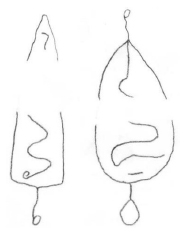
| Phase | Spindle | Hand | Pot | Posts | No mark |
| I | 29 (71%) | 9 (22%) | 2 (5%) | 0 | 1 (2%) |
| II | 22 (92%) | 1 (4%) | 0 | 1 (4%) | 0 |
| III | 18 (90%) | 2 (10%) | 0 | 0 | 0 |
| IV | 9 (36%) | 12 (48%) | 4 (16%) | 0 | 0 |
The spindles, I believe, are significant for two reasons. First, their
frequency
drops at Phase IV, with hands coming into the majority and pots making a
surge.
Although the sample size is small, these shifts could indicate a transition
into a
different mixture of paper stocks and hence a rather longer pause after
Phase III
than after I or II. Secondly, of the other books printed by Norton in 1633–34
that I was able to examine,
only one contains a spindle: that is the Huntington
copy of the seventh quarto of
Richard II
, dated
1634. It has two specific versions
found in ToP, as well as two ToP hands, along with two marks
which I found in
Richard II
only.
The received wisdom about printers' paper stocks is that they
bought only what
they needed for specific jobs, and this makes economic sense.
Indeed, the stock
found in ToP Phases I-III is consistent with a single batch
of
paper assembled by a vendor from the products of two or more makers.
The
odd post or pot could either be odds slipped into the ream by the vendor
or
leftovers from a previous lot remaining in Norton's
shop. In practice, the end of
a job never precisely coincides with the end of the
paper supply, and Norton was
a busy man, printing about
250 edition-sheets that we know of in 1633 (though
that number drops
to around 150 the next year). A more sensible response to a
continuous need for
the middling-quality pot-sized paper found in virtually all
of Norton's books of the period would be to periodically estimate the
projected
demand for incoming work and top off an in-shop supply that all the jobs
could
draw upon. Thus, we would expect frequently to find the same marks (by which

same time. This is the sort of evidence we find in ToP and Richard II , 64 and I pre-
dict that if more copies of the latter are examined, they will contain a proportion
of spindles to hands comparable to that of Phase IV of ToP. A finding of similar
paper stocks would indicate that the two books were printed in quick succession,
ToP first, or even with some overlap.
The distinctive mixture of marks in the four phases of ToP
tightens their
temporal bond. It reinforces the evidence that Norton produced the first three
impressions in as short a time as he
could. It also shows that there is little chance
that he paused for long between
Phases III and IV. Standing paper, like stand-
ing type, is vulnerable to
appropriation by more urgent projects. The fact that
the paper in Phase IV shows
significant overlap with the distinctive paper stock
used in the previous
printings is consistent with my finding of broken types from
Phase III recurring
in Phase IV (�9D). Both support a conclusion that Norton
did not wait long before embarking on the last impression. I would
guess that the
four print runs were all over within two months.
Note should be made, however,
of an anonymous 1643 parody, The Tragedy of the
Cruell
Warre
(Wing
2011), which directly quotes some of the songs. The next printing of
the full work
was in William Gifford's collected
Shirley of 1833. A note by Alexander Dyce in this edition is
worth citing as the
first record of bibliographical engagement with the printed copies:
"Three
editions of this piece are now before me, all in 4to. and printed by
John Norton for William
Cooke in 1633: the two earliest (their title
pages leave us ignorant which of them issued first
from the press) differ but
very slightly from each other; 'The third impression'
varies from them
considerably in some passages" (The
Dramatic Works and Poems of James Shirley
[ed.
William Gif-
ford]. London: John Murray, 1833, 6:
[254]).
With one exception, manuscripts are quoted here from their
transcriptions in Records
of Early English Drama
[REED]: The Middle Temple (ed. Alan H.
Nelson and John R. Elliott, Jr.;
Cambridge: D. S. Brewer,
2010). The Stationers' Register entry comes from A Transcript of the
Registers of the Company of Stationers of London,
1554 -1640
(ed. Edward
Arber; London: Privately
printed,
1875–77).
Middle Temple Library, MT.7/MAB/22. REED, 1: 259. Numbered S.21
by Tucker
Orbison in The Middle
Temple Documents Relating to James Shirley's
Triumph of Peace (Malone
Society, Collections 12,
1983). Interpreting the accounts for the masque is exceedingly
difficult,
and Orbison's introduction is essential reading for anyone
attempting it.
48. British Library, Harley MS. 1026,
fol. 50–51. REED, 2: 704. This is from a copy of
the letter entered by
Justinian into his diary.
Lawrence Venuti, "The Politics of
Allusion: The Gentry and Shirley's Triumph of
Peace".
English Literary Renaissance, 16.1 (Winter 1986),
182–205.
This occurs in ToP's
quire A at four points in the printing history. In the early print-
ings the
procession contains a crowd of gentlemen on horseback each with two pages
(A2r:30),
and groups of four musicians between the chariots (A3r:25). The
final printing expands this to
"many" pages and groups of six musicians, as well as augmenting the Marshall's retinue by
ten
horsemen (A2r:24) and adding a group of beggars pursued by
mastiffs.
For caveats on the use of this line of evidence see Lauren Shohet, Reading
Masques
(Oxford: Oxford University Press, 2010, p. 89, n. 28). Tracey Hill, in Pageantry and Power
(Man-
chester: Manchester University Press, 2010) discusses the same issues at
length with regard to
the Lord Mayors'
shows—comparable in some ways to court masques—concluding, "It seems
[...]
that practice simply varied: in some years the books were distributed on the day
and in
others not" (p. 233). But there is no suggestion that they were made
available beforehand; and
indeed that would spoil the surprise.
"The Publication of Playbooks" in A New
History of Early English Drama (ed. John
D.
Cox and David Scott Kastan), p. 412 and
n. 62. In this article he constructs a scenario involv-
ing a play publisher,
using a hypothetical print run of 800 copies. Blayney
estimated the first
edition of King Lear
(1609) at 750 copies (more likely lower than higher) in The Texts of King Lear
and their Origins (Cambridge: Cambridge University Press, 1982, p.
148, n.1), but this was only
a very educated guess.
Thomas Heywood's Pageants (New York: Garland, 1986, p. 28). The specific
print runs he
cites, from the guild records, are 300 (for 1631),
300 (1632), 500 (1635), 500 (1638), and
"three
hundred bookes for ye Companie over and above ye number they were to
have" (i639).
If we take the survivors of ToP as a
random sample from the entire output of the
four printings, and hypothesize
that the printings were done in equal numbers and had equal
chances of
survival, the probability of the sample containing a given number of copies
from
any one phase is approximated by 
sample, p is the hypothetical frequency of that
printing in the whole population (1/4), and
q = 1–p
(i.e., 3/4).
This is not vastly higher than
the number Greg used to illustrate a hypothetical case
in his "Nightmare"
article (p. 116) which Bentley would later seize on as the actual print
run
(see footnote 6). Greg derived his figure arbitrarily by doubling the
maximum allowed edition
size of 1500 copies.
D. F. McKenzie, Stationers' Company Apprentices, 1605–1640. They were Thomas
Creake (bound 24 June 1627, freed 3
Sept. 1638) and Henry Luther (bound 6 Sept.
1629 for
seven years, freedom not recorded). Richard Phillips was bound by Joyce Lawe on 7
June 1630
and freed by Norton on 3 Feb.
1640, but the date of his transfer is not known. A document of
1635, listing apprentices beyond the legal limit shared by Norton and Okes, does not mention
him (W. W. Greg, A Companion to Arber,
Oxford: Clarendon Press, 1967, p. 328).
I have omitted quire "a", which, being a half-sheet, will fail to show a mark in
about
half the copies. However, the marks I did find (with no trend discernible
in this small sample)
were eight spindles, one hand, and one pot.
Any number of accidents—spoilage at the press, damage or loss
before gathering,
miscounting, etc.—would make it unlikely for a given job to
end up with exactly the same
number of sheets of each signature.
CONCLUSIONS AND APPLICATIONS
I have presented evidence showing that John Norton printed
The Triumph
of Peace in four impressions, with hiatuses
within the second and third of these.
Varying amounts of text—but always much less
than half of the book—were
distributed and reset before each of the later
impressions, at least partly to sup-
ply other jobs running concurrently. The
preliminaries, including the title page,
also went through four impressions, but in
different quantities from the text
quires, so that the first two states of the title
may each occur with two possible
impressions of the text. Other, smaller disparities
in print runs among the text
quires produced occasional copies containing quires
from adjacent impressions,
further complicating the problems of identification.
However, in general the four
printings of the text come together in a few consistent
combinations with little
intermixing. The state of quire C is the clearest indicator
of which impression a
copy belongs to, but fully characterizing exemplars of the
first three printings still
requires the specification of many variables. About half
of the copies of the third
and fourth impressions contain type-material from Norton's partner Nicholas
Okes and
are presumed to have been printed by him.
The difficulties that earlier bibliographers had with ToP arose
largely from
their point of view. Like astronomers of the Ptolemaic paradigm, they
put the
most familiar element—the title page, in this case—at the center and saw
the
rest of the system behaving with a bewildering complexity. Moving the main
part
of the book—the text—to the center and relegating the title page to its own
odd
but explainable orbit eliminates much of the need to invoke mysterious
causes.
Even so, the book offers seemingly unlimited surprises—even unto the
fifty-fifth
copy—and mysteries whose unravelling I will now leave, as did Greg, to
those

to explain the unique variant in St. Catharine's (Cambridge) Z59; the garbling
of states in some phases of quires B and C; the weird quire interactions in the
Phase IIIb copies; the rationale of enlisting a second printer for help on quire D;
and the identity and dynamics of the competing jobs in Norton's shop. Mechani-
cal collation (a luxury that I did not allow myself) might uncover tiny differences
in the pairs of "identical" reprints that I have hypothesized above.
The complexities of ToP may tempt us to put it in a class by
itself,
65
but it
contains lessons
that might point the way to a fresh approach to certain diffi-
cult cases. For
example, both Greg and STC treat Philip
Massinger's
The Picture
(1630) as one edition with a
confusing array of variants.
66
A brief
comparison of
copies, with attention to the skeletons, reveals a similar situation
to that of ToP:
there were at least two impressions, though
in this case the copies contain sheets
drawn indiscriminately from both. Perhaps not
coincidentally, the printer was
again John Norton, and one
immediately recognizes the characteristic slovenli-
ness that he inflicted on his
lower-end work. Looking at The Picture in this light
may ease
the work of the next editor, but it also at least doubles our estimate of
the play's
sales during the author's lifetime. I cannot believe that The
Triumph
of Peace and The Picture form the tip of a
particularly large iceberg, but they
do underline the need to pay close attention to
skeletons, especially when the
headlines contain nothing more than page numbers. We
are still exploring the
range of ingenious—if not devious—shifts that early modern
printers could use
to make their lives easier.
I also noted a mark shared by STC 13584 and 21176, allied if not
identical to the
posts in the B.L. ToP Ashley
1697. I was not able to investigate further correspondences
among
Norton's other non-ToP
productions.
ACKNOWLEDGMENTS
This study had its origin in a cataloguing impasse at the Huntington Library,
to
which I had been posted by the American office of the recently renamed En-
glish
Short-Title Catalogue under the inspired directorship of Henry
Snyder. It is
to Dr. Snyder and the Huntington
that I owe the initial opportunity to be baffled
by ToP.
Randall McLeod spent entirely too much of his busy
retirement in re-
peated reading and marking up of the manuscript, and Joseph Gwara also made invaluable suggestions. The project could
not have been completed without the
aid of staff at the libraries holding copies of
the book. In particular I would like to
thank Matthew
Baalham, Erin Blake, Tad
Boehmer, Emily Dourish, Lynne
Far-
rington, Stephen Ferguson, Jill Gage, Paul Gehl, Myron Groover, Colin Higgins,
Kathryn James, Kathleen Lesko, Ann Martin, Jenna Moore, Jason
Moschella,
Richard Oram, Tim
Pye, Joanna Parker, Catherine
Uecker, Abbie Weinberg,
and Georgianna Ziegler. Barbara Ravelhofer and Eugene
Giddens supplied valu-


archival records; and Roger Gaskell and Eva Griffith sent further information
about copies I could not easily get to. Finally, I would like to thank David Vander
Meulen and Elizabeth Lynch for their tenacious work on the manuscript through
multiple iterations.
Although David Foxon's study
of James Thomson's 1730 Tragedy of
Sophonisba ("'Oh!
Sophonisba! Sophonisba! Oh!'",
Studies in Bibliography, 12 [1959], 204–213)
turns up many similar
practices. That case has additional complications of
variant formats and paper stocks, but also
the rare boon of surviving printer's
records.
Greg, Bibliography, 436; STC 17640,
17640.5, and addendum. Both authorities de-
pended rather too heavily on A. K. McIlwraith, "Some Bibliographical Notes on
Massinger",
The Library, 4th ser., 11.1 (June
1930), 78–92 (83–87). The collected Massinger edited by Philip
Edwards and Colin Gibson
(Oxford: Clarendon Press, 1976) relies on earlier
authorities.
APPENDIX 1
KEY TO VARIANTS
The leftmost numbers indicate major break-points in the production cycle.
Suc-
cessive indentions show increasingly minor variants. The variants are
identified
by combining the sigla at the successive indentions. For example: on
page a2v,
variant 1b1 has a comma after "Honourers" in the dedication's closing;
the clos-
est distance between "S" in "IAMES" and "S" in "SHIRLEY" is 3 mm;
and
there is a rule at the bottom. Asterisks within the descriptions mark the
resetting
of page numbers.
a1r (title page; p. [i])
- "of Grayes Inne"
-
"T" in line 1 nearer to "I" below
- "O" in "OF" intact, line 3
- (Variant): "O" battered
- "T" in line 1 nearer to "V" below
- No mention of Grayes Inne "The third Impression"
- "of Grayes-Inne,", no "Gent."
- "of Grayes-Inne, Gent."
a1v (p. [ii]) blank
a2r (p. [iii])
- 28 pairs of acorns (Reimposed): 27 pairs of acorns. Direction line reset
- Heading line 5 "THE" equally spaced between surrounding lines
- (Variant): "THE" closer to following line
a2v (p. [iv])
- Line 1 has "ond"
- Line 1 has "and"
- (Probably reimposed): comma after "Honourers" in closing; closest
dis-
tance between "S" in "IAMES" and "S" in "SHIRLEY" 3 mm
[Probably later than 1 a because of broken "a" in "that", line 8.]- Rule at bottom
- No rule at bottom
- (Probably reimposed): comma after "Honourers" in closing; closest
dis-
tance between "S" in "IAMES" and "S" in "SHIRLEY" 6 mm
-
No comma after "Honourers" in closing
A1r (p. 11)
- Caption title has "Jnnes (i.e. swash "I")
- (Reimposed*, at least first five lines reset): caption title has "Innes"
- Line 5 of text has "Hornepipe"; page "1" over acorn pairs 14–15;
page
number parentheses 9 mm apart at center, right parenthesis lower and
damaged - (Reimposed*): line 5 of text has "Hornepipe"; page "1" over acorn
pair
14; page number parentheses 7 mm apart at center, on same level, and
undamaged - (Reimposed*): line 5 of text has "Hornepipe"; page number, or the
space
where it would be, over acorn pair 13- Page number printed
- (Variant): page number not printed
- [This variant probably depends on the presswork of individual copies.]
- (Reimposed*): line 5 of text has "Horne-pipe".
- [A few differences in line spacing and settings.]
- Line 5 of text has "Hornepipe"; page "1" over acorn pairs 14–15;
page
A1v (p. 12)
-
Last line is one word, "fist.", plus catchword on same line
- Line 11–12 has "colours, laughing"
- (Variant): line 11–12 has "colours laughing,"
- Left parenthesis of page number over and to right of "D"
- [Line 19 has "bride".] (Reimposed*): lines 11–12 have "colous laughing"
- Line 19 has "bride"
- (Variant): line 19 has "bridle"
- (Reimposed*): lines 11–12 have "colours laughing"
A2r (p. 13)
- Last line begins "ges"
- (Partly reset): last line begins "richly"
[Reset from line beginning "These moving forward ..." to end.] - (Partly reset): last line begins "After"
[First paragraph is unchanged, then a paragraph of new text is added, forcing
the last three lines of the page onto A2v. Thereafter, unchanged until the line
beginning "These moving forward ...".]


A2v (p. 14)
- Last line has "Silver & Watchet."
- (Reimposed*, partly reset): last line has "silver &
watchet."
[Italic lines reset from english to great primer size. Later because bottom serif
of "T" in "Triumphals", line 22, is damaged.]- Catchword "The"
- Catchword properly aligned
- The "e" displaced downward to varying degrees
- (Reimposed*): catchword "All"; page "4" centered or somewhat to
left
within parentheses; right parenthesis badly damaged at 4:00 - (Reimposed*) catchword "All"; page number "4" somewhat to right
within
parentheses; right parenthesis slightly nicked at 3:00
- Catchword "The"
- (Reimposed*, partly reset): last line reads "the top."
[Three lines of text are brought down from the previous page, in a new setting;
last two lines move to A3r.]
A3r (p. 15)
- Line 15 reads "to the linings of the Chariots."
- (Reimposed*, partly reset): line 15 or 17 reads "to the linings of
the
Chariots."
[First two lines and original lines 27–28 and 31 reset, the italic lines in a larger
size than text below.]- Last line reads "prest in his place."; page number "5" over "so" of
"crimson" - (Reimposed*): last line reads "prest in his place."; page number "5"
over
"i" of "crimson"- Signed "A3"
[Damage to "White", line 2, occurs during this state. bL 644.c.44
(now bound in nTxU Wrenn) shows damage and displacement at the
left end of lines 1–2, and slightly different positions of the skeleton
elements.] - (Variant): signed "A"
[Lines 1 and 2 repaired, but all copies have damage to "White",
line 2.]
- Signed "A3"
- (Reimposed*): last line begins "riding two a breast, ..."
[First two lines of type brought down from A2v, getting slightly damaged
in the process; last three lines of text move to A3v.]
- Last line reads "prest in his place."; page number "5" over "so" of
A3v (p. 16)
- Page begins with a line of ornaments that contains no colon or
inverted
comma- Line 13 has "Arber-worke" with broken b
- (Variant): line 13 has "Arbor-worke" with sound b
- (Reimposed*): page begins with a line of ornaments that contains a
colon
and inverted comma; page number "6" over and between pair of orna-
ments 4 and 5 - (Possibly reimposed): page begins with a line of ornaments that
contains
a colon and inverted comma; page number "6" over and between pair of
ornaments 5 and 6
[Catchword appears identical; the page number may be reset or may sim-
ply be shifted.] - (Reimposed*): page begins with text, "The Habit of the Masquers
..."
[First three lines of text brought down from A3r, reset; last four lines move
to A4r.]
A4r (p.17)
- Line 21 has "Caduseus"
- (Variant): line 21 has "Caduceus"; all
commas listed in variant 3 except
"drawne up the" and "Pallaces Lodges" - (Variant, probably reimposed): line 21 has "Caduceus"; the following
commas are present:- "Oliue-branch, all", lines 21–22
- "drawne up, the", line 24
- Pallaces, Lodges", line 26
- "Architecture, with", line 27
- "eye, opens", lines 28–29
- (Reimposed*): line 1 begins "pedestall fained".
[First four lines of type brought down from A3v; last four lines of text
move to A4v.]
-
Line 1 begins "in one hand,"
A4v (p. 18)
- Line 1 begins "cleare Sky" (Reimposed*, first two lines reset): line 1 begins "cleare skie"
- Page number "8" centered within parentheses
- (Reimposed*): page number "8" towards left within parentheses
["T" is damaged, line 3. The curvature of the rule varies during this
imposition.]- Raised quads between the paragraphs
- (Variant): quads down
- Line 1 begins "Trees and grounds, ..."
[First four lines of text brought down from A4r, reset. Right parenthesis of
page number now damaged, but headline not definitely different.]


B1r (p. 21)
-
Line 3 up has "A Bird!"
- Line 2 of heading: "they salute."
- (Variant): heading reset: line 2: "him, they
salute."
- "A" (line 9 up) and "B" (line 7 up) are sound.
- (Variant): these letters are damaged.
- (Reset): line 3 up has "A Bird!"
- 2 acorns are inverted
- (Reimposed*): 25 pairs of acorns, all properly oriented
[Later than 2a because "An" corrected, last line.] - (Reimposed*): 28 pairs of acorns, all properly oriented
[Later than 2b because "Hce'l" corrected, line 12.] - (Reimposed*): 26 pairs of acorns, all properly oriented
[The position of the page number varies a bit.]
B1v (p. 22)
- Question mark in line 8 under "er"; line 9 begins "Have"
- (Reset): question mark in line 8 under "nt"
- Line 10 begins "Vs"
[The "V" shows varying degrees of displacement.] - (Variant): line 10 begins "s"
- (Reset): question mark in line 8 under "r" ; line 9 begins "Haue"
- Line 10 begins "Vs"
B2r (p. 23)
- Line 4 ends "nature?"; line 6 has "inuentions"
- (Reset): line 4 ends "nature"
[This setting contains several features that do not reduce to a regular order;
see essay, �6C.]- Page number is prevailing thin form (same as on A2r, C3r,
D4r)
[Position between parentheses varies.] - (Variant): page number is round form, and centered
between
parentheses - (Reset): line 4 ends "nature?"; line 6 has "inventions"
- Page number is prevailing thin form (same as on A2r, C3r,
D4r)
B2v (p. 24)
- Last line has "Twas" (Reset): last line has "twas"
- Greatest distance between parentheses 11 mm; line 16 has
"the
Novelties." - (Reimposed*): line 16 has "theN ovelties"
- (Reimposed*): greatest distance between parentheses 9 mm; line 16
has
"the Novelties."
[Within this imposition the page number shows slight variations in damage
and position.)- Line 23 has "Laughter," with comma
- (Variant): line 23 has "Laughter" without comma
B3r (p. 25)
- Tavern direction in one line, italic, centered
- (Reimposed*, partly reset): tavern direction revised, three lines,
roman
[Last four lines of type moved to B3v, respaced as three lines. "Except" is cor-
rected to "accept", line 22.)- Page number "5" over the "f" of "foole" in line 2
- (Reimposed*): page number "5" over the space between "the foole"
in
line 2
(Reimposed*): tavern direction revised to one line, flush right - "The Scene a Taverne."
- (Reimposed*): "The Scene a Taverne."
[First three lines of text transferred from B3v, reset.]
B3v (p. 26)
- Page begins "Another Antimasque ..." (regular
italic "A")
- Line 10 has "off throw"
- Line 10 has "off, throw"
[Almost certainly later; see essay.]
- (Reset): page begins "I may supply ..."
- (Reset): page begins "Another Antimasque ..." (swash italic "A")
B4r (p. 27)
-
Last line has "vnder water" (narrow word-space)
- Lines 16 and 17 have "beard ... yeares found"
- (Variant): lines 16 and 17 have "beard, ... yeares,
found"
[Almost certainly later; see essay.] - (Reset): last line has "vnder Water"
[This setting contains features that do not reduce to a regular order—see essay, �6C.]- Line 3 begins "a vapour"
- (Reimposed*): line 3 begins "A vapour"
[Line 3 now correctly begins with a capital, and type is battered in line 7 in some copies.]
- (Reset): last line has "under Water"


B4v (p. 28)
- Line 1 has "vast"
- (Reset): line 1 has "uast"; line 16: "The fift
proiector dances."
- Page number "8" over the space between "of ayre"; catchword "Ma-"
- Line 2 has "coold"
- (Variant): line 2 has "cool"
- (Variant): line 2 has "coo"
- (Reimposed*): no catchword; last word on page: "Th"
- Page "8" over "e" of "ayre"
- (Variant): page "8" over the "f" of "of" and centered
within
parentheses
[The type-matter of the page number has shifted and possibly suf-
fered damage but seems to be the same metal.]
- (Reimposed*): page number "8" over "of" and to the left within the
pa-
rentheses; no catchword (last word on page: "The")- Line 13 has "stndy"
- (Variant): line 13 has "study"
- Page number "8" over the space between "of ayre"; catchword "Ma-"
- (Reimposed*; flush-right italic lines reset in pica size): line 1 has
"uast"; line 16:
"The fift Proiector dances·"
C1r (p. 9)
-
First four lines of roman in same size type as the rest
- Line 1 has "Returne as from the Taverne"
- (Variant): line 1 has "Returne, as from the Taverne,"
- (Reimposed*): right parenthesis sound and the same weight as the
left
[Retains the corrected reading of 1 a2.] - (Reimposed*): page number "9" slightly to the right within parentheses
- (Partly reset): first four lines of roman in type smaller than the rest
(pica, 83 mm)
[The skeleton is not obviously changed.]
-
Right parenthesis of page number heavier and nicked at 3:00
C1v (p. 10)
- Last line: "Three Dotterell-catchers." (all
italic); line 9 has "off. Then"
[The comma in line 7 is displaced below the line.]- Line 5 up has "We change the Seene."
- (Variant): line 5 up has "We change the Scene."
- (Reimposed*): last line: "Three
Dotterell-catchers." (all italic); line 9 has "off.
then" (period below the line)
[Page number, italic and bracket in lines 8–10, and last three lines in a differ-
ent setting. Resetting of lines 8–10 may have resulted from an accident while
re-aligning the comma.] - (Reimposed*): last line: "Three Dotterell-catchers."
[Italic and brackets in lines 1–10 and last four lines are reset, dropping fourth
line from the bottom.]- "1" of page number over "d"
- (Variant): "1" of page number over "a"
[The page number types are the same and the shift is probably due to
faulty lock-up.]
- (Partly reset): last line: "Ph. Dotterells, be
patient, and expect."
[The exchange between Opinion and Phansie is replaced by a new stage
direction, and the remainder leaded out. Two lines of text are brought up,
reset, from C2r.]
C2r (p. 11)
- Line 1: "Op. What are these?"; line 10 has
"assavlted"
- Left parenthesis of page number beyond the right end of the first line
- (Reimposed*): left parenthesis of page number over "?" of the first line
- (Reset except for parts of lines 5–9): line 1: "Op. What are these?"; line 10
has "assaulted" - (Reimposed*, partly reset): line 1: "After the Dotterells be caught,
by"
[Probably the latest version because the bowlers now have something to do.
The directions for the Quixote/Sancho figures are revised and reset in type
smaller than the surrounding text, and the altercation with the gentleman
and his servant is deleted.]
C2v (p. 12)
- Song line 5 has "skyes"
- Line 6 begins "The Antimasques being past,"; line 11 has "Olives
of
her head" - (Variant): line 6 begins "The Antimasques being past,"; line 11
has
"Olives on her head"
["On her head" is more correct.] - (Variant): line 6 begins "The Antimasquers being gone" (no
comma,
but spacer up); line 11 as in state 2
[Further corrected.]
- Line 6 begins "The Antimasques being past,"; line 11 has "Olives
of
- (Partly reset): song line 5 has "skies"
[Italic song reset, some other minor differences in setting or spacing.]- (Reimposed*): line 1 "Iol. I am as light
now."; left parenthesis of page
number over "now" - (Reimposed*): line 1 "Iol. I am as light
now."; left parenthesis of page
number over the period - (Variant): line 1 "Op. What new change"
[Two lines of text have moved to C2r, but the skeleton is unchanged.]
- (Reimposed*): line 1 "Iol. I am as light
now."; left parenthesis of page

C3r (p. 13)
- Line 5 has "calls;"
- Line 5 up reads "This Chariot attended as the former."
- (Variant): this direction deleted
[The attendants of the former chariot were never described, so this
state is more correct.] - (Variant): line 20 corrected to "Starres, a mantle"
-
Line 20 has "Starres, mantle"
- (Reimposed*, partly reset): line 5 has "calls,"
[Italic songs in a different setting.]- Right parenthesis of page number printed heavier than left and
comes
within about 1 mm of the bottom of the "3" - (Reimposed*): right parenthesis of page number only comes within
about
2 mm of the bottom of the "3"
- Right parenthesis of page number printed heavier than left and
comes
C3v (p. 14)
- Line 13 begins "Thy voyce,"
- Next line ends "neyther" (no period)
- (Reimposed*): next line ends "neyther."
[This version more correct.]
- (Reset): line 13 begins "The voyce,"
- Line 5 up has "Diche"
- (Reimposed*): line 5 up has "Dice"
[This version more correct.]
C4r (p. 15)
- Line 2 begins "Dich. Swifly, [sic]"
- (Reimposed*): line 2 begins "Dich. Swiftly,"
[The typo is corrected.] - (Reimposed*, partly reset): line 2 begins "Diche" or "Dice"
[Lines 1, 10, and 20 reset; some differences in word and line spacing (e.g.,
lines 4, 6, 15–17).]- Line 2 begins "Diche"; left parenthesis of page number over "g"
and
the following space - (Variant): line 2 begins "Diche"; left parenthesis of page
number
over "4"
[The comma at the end of line 6 is too far right. The page number
looks to be the same types as c1, but is shifted.] - (Variant): line 2 begins "Dice."
[This version is the most correct. Comma in line 6 as in 1c2. The
page number again looks to be the same types, but is shifted so that
the left parenthesis is over "ng"—possibly a result of correcting
line 2.]
- Line 2 begins "Diche"; left parenthesis of page number over "g"
and



C4v (p. 16)
-
Page number "61"
- Line 6 up begins "Thus warme"; line 4 up has "Didche"
- (Variant): line 6 up begins "Thus warme";
line 4 up has "Diche"
[The typo is corrected.] - (Variant): line 6 up begins "Thus
warm'd"
[Line 4 up has "Diche", and further corrected.] - (Reimposed*, mostly reset): page number "16"
[Only the roman paragraph, lines 7–9, and the last line are retained from
state 1. "Song 5" title and text are reset in pica size.]- Maximum distance between parentheses in page number (at midline)11 mm
- [Line 3 has "Dich."; line 4 up has "Diche,"] (Reimposed*): maximum distance between parentheses 14 mm
- Line 3 has "Dich."; line 4 up has "Diche,"
- (Variant): line 3 has "Dic."; line 4 up has "Dice,"
[This version is the most correct.]
D1r (p. 17)
-
Line 9 has "the Sky beyond"; line 5 has "ioyning"
- Line 9 has "the Sky beyond seene."
[The last letter of line 1 is displaced upward in some copies.] - (Variant): line 9 has "the Sky beyond was seene."; type mostly
sound
in first three lines, though disturbed
[This version more correct.] - (Variant): line 9 has "the Sky beyond was seene."; type damaged
in
first three lines
[Later than 1a2 because of damage.] - Signature mark "D" under the "hi" of
"white,"
[Line 10 has "Masqncrs".] - (Variant, later than 2a1): signature mark "D" under ","
[Line 10 now has "Masquers". The page number is the same as 2a1,
and the significance of the signature mark shift is unclear.] - (Variant): signature mark "D" under the
"w" of "white,"
[Line 10 has "Masquers". The page number is unchanged, and the
significance of the signature mark shift is unclear.] - (Okes' setting): line 9 has "the Sky beyond"; line 5 has "joyning"
D1v (p. 18)
- First line has "Beneath ... Wings,"
[First five lines set in italic, line 5 has "descended", both incorrectly.]- Comma after "Wings" displaced downward;
right parenthesis of page
number damaged - (Variant): comma after "Wings" in place;
right parenthesis of page
number sound
[A sound parenthesis has been supplied and the comma replaced.]
- Comma after "Wings" displaced downward;
right parenthesis of page
- (Reimposed*, partly reset): first line has "Beneath ... with"
[First five lines reset in roman, line 5 has "descending", both correctly.] - (Reset): first line has "Beneath ... wings"
- (Okes' setting): first line has "beneath ... wings,"
D2r (p. 19)
- Line 7: "Live Royall paire, & when Your sands are
spent"
- Line 5 has "on ages"
- (Variant): line 5 has "no ages"
[This version correct.]
- (Reimposed*, partly reset): line 7: "Live royall pare,
awd ..."
[The song and the italic lines at bottom are in a different setting.] - (Reimposed*, partly reset): line 7: "Live Royall
paire,and ..."
[Song lines 1–8 are in a different setting.] - (Okes' setting): line 7: "Live Royall paire, & when your sands are spent"
D2v (p. 20)
- Line 6 ends "per-"
- (Reimposed*, partly reset): line 6 ends "perrill."
[Line 6 is respaced to take up one line, and former line 18 (current line 17) to
end is reset.] - (Okes' setting): line 6 ends "their"
D3r (p. 21)
- Line 8 up ends "Spies,"; line 6 begins "uenge,"
- (Reimposed*, partly reset): line 8 up ends "spies,"
[The song is in a different setting.] - (Okes' setting): line 8 up ends "Spies,"; line 6 begins "venge,"
D3v (p. 22)
- Line 4 up reads "Proclaiming warres"
[Line 8 has "a bout".] - (Reimposed*, partly reset): line 4 up reads "Proclayming warres"
[The song is in a different setting. Line 8 has "about" correctly.] - (Reimposed*, partly reset): line 4 up reads "proclayming warres"
- [The roman section is in a different setting; the italic is the same as state
2,
except that "proclayming" is unaccountably lowercased.] - (Okes' setting): line 4 up reads "Proclaiming Warres"
D4r (p. 23)
- Line 3 up ends "prayer,"; no catchword
- (Reset): line 3 up ends "Prayer,"; catchword "Am-"
- (Reimposed*): line 3 up ends "Prayer,"; no
catchword
[Some variations in spacing at top and bottom.] - (Okes' setting): line 3 up ends "prayer,";
catchword "Amphiluche" on last line
of text
D4v (p. 24)
- "FINIS." in much larger type than text; swash
italic "N"
-
Right parenthesis of page number over "en"
- Right parenthesis of page number intact
- (Variant): right parenthesis damaged at bottom
- (Reimposed*): right parenthesis of page number over "v"
- (Okes' setting): "FINIS." only slightly larger than text; no swash

APPENDIX 2
COPIES EXAMINED
I have examined all copies in person except as indicated. References are given
to
reel numbers in the University Microfilms International (UMI) film set Early
English Books
1475–1640 (Ann Arbor, MI, [1937]-), subsequently digitized
in
Early English Books Online (EEBO) (eebo.chadwyck.com). Thomas J. Wise tam-
pered with certain copies of ToP, now at the British Library and the Humanities
Research Center,
University of Texas. For details beyond those given here, see
D.F. Foxon,
Thomas J. Wise and the Pre-Restoration
Drama: A Study in Theft and
Sophistication (London: Bibliographical Society, 1959).
bBRp: Bristol Central Library
SR 74. Reported by Roger Gaskell, who also sent digital
copies. In a pam-
phlet volume, old maroon library buckram.
bC: Cambridge University Library
- Syn.7.61.1998
- Syn.7.63.3791. "Speech to the King" bound after sig.
a. Sophisticated: D4
supplied from a copy of the first printing (states D4r:1, D4v:1a2).
bCsc: St. Catharine's College Library, University of Cambridge
- Z.55. Examined in digital copy only. In a C19 to early-C20
collector's
binding. - Z.59. Examined in digital copy only. In a pamphlet volume, old leather.
bE: National Library of Scotland, Edinburgh
H.3.d.39(1). Examined in photocopy only. Bound with STC 22456 in
later
19th-century quarter leather. Title page mended at inner margin.
bET: Eton College Library
S.170.Plays 27(04). Examined in digital copy only. Bound with six other
C17
English plays in C18 gold-tooled mottled calf. Storer bookplate; given to
the
library by Anthony Morris Storer, 1799. UMI reel
1585:6.
bL: British Library, London
- 644.c.44. David Garrick copy. Tampered with by
Thomas Wise: A3, B3,
C2–4 stolen, leaving stubs, as recorded by a pencil note in the book dated
Jan. 1903. B3 and C2–3 were probably transferred to Ashley 1696. A3 was
used to make up the Wrenn copy now at nTxU; a photocopy of that leaf
is now bound into 644.c.44. C4 was found laid into Ashley 1697, and is
now re-inserted in 644.c.44. - Ashley 1695. Thomas J. Wise copy.
Evidently the source of the t.p. illustra-
tion in the Ashley Catalogue, vol. 5, recto of plate leaf preceding p. 161. - Ashley 1696. Thomas J. Wise copy.
Tampered with by Thomas Wise:
B3 and the bifolium C2.3 were used to make up the Wrenn copy now at
nTxU. Their lack was probably supplied from copy 644.c.44. Either Ash-
ley 1696 or Ashley 1698 was probably the source of the t.p. illustration in
the Ashley Catalogue, vol. 5, verso of plate leaf preceding p. 161. - Ashley 1697. Thomas J. Wise copy.
- Ashley 1698. Thomas J. Wise copy.
Disbound; paper flaw on B4. Either
Ashley 1698 or Ashley 1696 was probably the source of the t.p. illustration
in the Ashley Catalogue, vol. 5, verso of plate leaf preceding p. 161. - Ashley 1699. Thomas J. Wise copy.
- Ashley 5388. Thomas J. Wise copy.
- C.12.f.15(7). Some cropping at head.

bLg: Guildhall Library, London
Closed access SR.4
Pageants.
bLv: Victoria and Albert Museum National Art Library, London
- 25.c.78. Alexander Dyce copy (Dyce Collection, 9113). Mid-C19 half calf
with marbled boards (uniform with 25.c.79). - 25.c.79. Alexander Dyce copy (Dyce Collection, 9114). Mid-C19 half calf
with marbled boards (uniform with 25.c.78). "Speech to the King" bound
at end. Washed: quires are all different shades.
bLONG: Longleat House, Warminster, Wilts.
Reported by Matthew Baalham. Half calf for Thomas Thynne, 2nd Marquis
of Bath
(1862–1946).
bO: Bodleian Library, Oxford University
- Douce S 186. Francis Douce copy. UMI reel 1559:12.
- Mal. 160(3). Edmond Malone copy. UMI reel
1464:7. Misidentified as
Huntington copy on EEBO. - Mal. 254(5). Edmond Malone copy. Title page repaired along inner mar-gin; D4 repaired at top and bottom.
bOwo: Worcester College Library, Oxford University
- Plays 4.1022. In a pamphlet volume. -D4.
- Plays 4.1031. In a pamphlet volume.
- Plays 4.1032. In a pamphlet volume. Title page backed.
nCLU-C: University of California, William Andrews Clark Memorial Library, Los Angeles, CA
*PR3I44.T81. Bound by Riviere & Son. Some small mends
to inner margin
of sig. a.
nC-S: Sutro Library, San Francisco, CA
822.S558t. Marbled boards, calf spine, ca. 1900. All page numbers more
or
less cropped; state of D4v indeterminate because of this.
nCSmH: Huntington Library, San Marino, CA
- 69428. C19 sprinkled calf. Bookplates of Thomas
Jefferson McKee and
Henry William Poor (the latter's sale, Anderson Galleries, 14 Jan. 1909:942,
$13; re-sold four months later as from "the library of Mrs. Constance E.
Poor", Anderson Galleries, 14 May 1909:545, $9.50 to George Smith for Henry Huntington). Small paper fill, inside top of D4; the few missing let-
ters supplied in pencil. UMI reel 1188:7. - 69432. 19th-century calf. Bridgewater copy (en
bloc purchase by Hunting-
ton, 1917). - 69433. Never bound, uncut, four stitching holes, now re-stitched with
three
holes, bolts cut, 20 x 15 cm. Badly printed line endings touched up in early
MS. on B2v:20–22. Sotheby, Wilkinson & Hodge sale, 23 April 1904 (to207Joseph Sabin); folding morocco case by Riviere & Son added that year,
according to dated cost code; Frederick R. Halsey copy (en bloc purchase by Huntington, 1915). - 69434. Inlaid, some headlines cropped. MS. initials of John Philip Kemble, "Collated & perfect", 1798; Devonshire copy
(pamphlet volume 81, item 7). Acquired by Huntington with
the Kemble - Devonshire collection in
1914; removed and bound separately in black morocco by Macdonald.
nCaOHM: McMaster University, Hamilton, Ontario
Mills Lower Level B 13846. Reported by Myron C. Groover.
Bookplate of
Irving Kent Hall, 1901. Small paper fill in gutter of
A2.
nCtY
EC: Yale University, Elizabethan Club, New Haven,
CT
Eliz 218. Reported by Kathryn James. Red morocco signed by
Riviere & Son.
Bridgewater duplicate stamp on
title verso. Gift of Alexander S. Cochran to
the
Elizabethan Club, Dec. 1911.
nDFo: Folger Shakespeare Library, Washington, DC
- STC 22459b c.2 (Bd.w. STC 1578). In a 1963
binding replacing "calf of ca.
1780, one board off". Quire A only, following t.p. of STC 1578. - STC 22459. Binding signed by Riviere & Son.
Cropped at head and re-
margined; state of D4v indeterminate for this reason. a1.2 not conjugate. - STC 22459a c.1. Red morocco by F. Bedford.
Griswold family crest
stamped on cover; bookplate of Almon W. Griswold. - STC 22459a c.2. Blue morocco by Riviere &
Son; some deckles retained.
-a2, some repairs to sig. D. - STC 22459b c.1 (Bd.w. STC 4619). In a pamphlet volume bound in
(prob-
ably later) C17 calf. "Speech to the King" bound after sig. a. - STC 22459b.2. C19 half green morocco, marbled boards. "Speech to
the
King" bound at end. Pencil notes: "From Mr: Kershaw's Lib. No. 1317–
Bot: by him from Lacy (?)." (parentheses in source). Collated by Quaritch,
25 Jan. 1924. - STC 22459.2. Later wrappers. Title page repaired at inner margin.
nDLC: Library of Congress, Washington, DC
PR1241.L6 #188:6. Bound with five other plays in C18 calf. Title page mu-
tilated
and backed; -a2; sig. D repaired at inner margin.
nICN: Newberry Library, Chicago, IL
Case Y 135.S62885. Reported by Jill Gage. Interleaved.
Front cover with
initials "IZ[L?]G"; back cover with armorial of a lion rampant
holding a fishing seine.
nICU: University of Chicago, IL
PR3144.T84 1633. Reported by Catherine Uecker.
Acquired by the library
early C20. Heavily cropped at head (state of C1r-v and C4v
indeterminate-for this reason), interleaved; t.p. and D4 mutilated.
nIU: University of Illinois, Urbana-Champaign, IL
IUA11400. Reported by Tad Boehmer. Bound with nine other
plays by Shir-
ley. Bought 22 July 1942
from Dawson's Book Shop, Los Angeles, CA (Cata-
logue 161:36).
nMB: Boston Public Library, MA

G.3976.37. Reported by Jason Moschella. Thomas Pennant Barton copy.
With two other items in a late C19 library
binding; some pages untrimmed.
nMH-H: Harvard University, Houghton Library, Cambridge, MA
- STC 22459. C18–19 sprinkled calf. T.p. repaired at inner margin;
A1
conjugacy not certain. - STC 22459a.5. Early C19 calf. T.p. on a stub.
nMWiW-C: Williams College, Chapin Library, Williamstown, MA
STC 22459a.5. Henry Huth copy (his catalogue, vol. 4, p.
1349); his sale,
Sotheby, Wilkinson & Hodge, 8 July
1918:6825 ("new vellum"), �23. 10s. to
B.F. Stevens and Brown;
subsequently sold by James Drake to Alfred Chapin
for the same amount; donated by Chapin to Williams College, 1 Feb. 1923.
nNhD: Dartmouth College, Hanover, NH
Rauner Ticknor VA Sh6t. Examined in digital copy only. George
Ticknor
copy; bequeathed to Dartmouth by William
Dexter, 1943; afterwards re-
bound in brown library buckram.
Ticknor notes of prices at the Roxburghe
and Rhodes
sales. -Sig. A; sig. a cropped at head; top half of last leaf torn
away.
nNjP: Princeton University, Firestone Library, Princeton, NJ
3930.3.394. Examined in digital copy only. C19 quarter leather, marbled
boards.
Cost code of Dawson's Book Shop, Los Angeles, CA, with price
$22.50; acquired by Princeton in early 1940s. Hole in a2 affecting two
lines.
Digitized at http://libweb5.princeton.edu/visual_materials/Misc/Bib
2458362_Shirley_Triumph_of_Peace_1633_NjP.pdf.
nPU: University of Pennsylvania, Kislak Center, Philadelphia, PA
PR3144.T75 1634. Reported by Lynne Farrington.
Signature of Courtney
Kenny and date 1719. Acquired 1968 and probably
rebound at that time
(marbled boards, leather spine, vellum tips). -a2.
nTxU: University of Texas, Harry Ransom Humanities Research Center, Austin,
TX
- Pforz 935 PFZ. Examined in digital copy only. Brown morocco by Riviere.
Robert Hoe copy (initials, trace of bookplate); W. Carew Hazlitt? (Shake-
speare Library Pt. 2, Anderson Galleries, 28–30 Oct. 1918:312); Carl H.
Pforzheimer (Unger & Jackson 935). Evidently not item 3029 in the Hoe
sale (Perkins copy with armorial bookplate, modern wrappers). - Wh Sh66.633ta WRE. Examined in digital copy only. Binding signed
by
Riviere & Son. Bought from a Mr. Butcher (possibly the father of Robert
W. Butcher of the Lancashire Fusiliers) 67 by Thomas Wise for John Henry
Wrenn, 1902. Subsequently tampered with by Wise: A3 supplied from bL
644.c.44; B3 and C2–3 supplied from bL Ashley 1696.
Meisei University, Tokyo

- MR 1063. Examined in digital copy only. Bridgewater copy ("3." in
box
on A1r). -sig. a. - MR 3092. Examined in digital copy only. -sig. a.
- MR 3093. Examined in digital copy only. -sig. a.
W.W. Greg's copy
"Third impression", a2 in photographic facsimile. Half calf. With "Speech
to the
King" bound after sig. a ("fore-margin closely shaved"), illustrated
in his
1946 article (see main article, footnote 1). Sold at Sotheby's, London,
28 March 1960:60; present owner
untraced.
In Letters of Thomas J. Wise to John Henry Wrenn
(New York:
Knopf, 1944) he is identi-
fied by the editor (p. 243) as Samuel Henry Butcher, who was living in Edinburgh in 1902 and
died in 1910. However,
the Butcher in the Wrenn correspondence seems to frequent
London.
Furthermore, an ALS. from Wise to an R. W.
("Bob") Butcher in Bury (then part of Lan-
cashire), dated 1924,
bids the latter to "Remember me to your good father" (Thomas J.
Wise
Correspondence, Syracuse University Library).
APPENDIX 3
Master Table of Printing Variants
The table on the following pages appears in color on the website of the
Biblio-
graphical Society of the University of Virginia:
http//www.bsuva.org.


APPENDIX 3: Master Table of Printing Variants
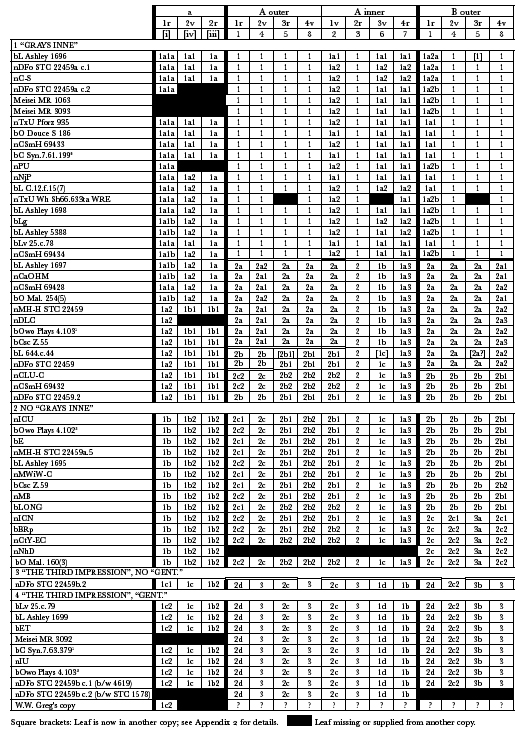 |
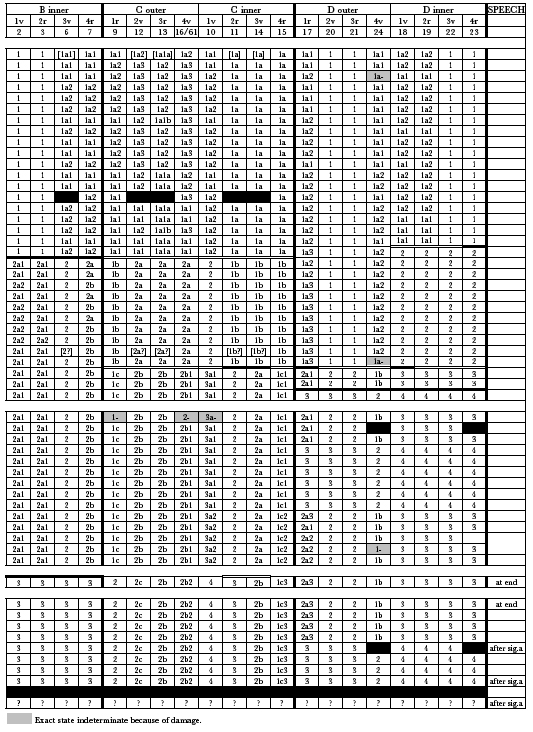 |
The Carl H. Pforzheimer Library: English Literature, 1475–1700. New York: Privately printed, 1940, item 935.
London: Printed for the Bibliographical
Society at the University Press, Oxford,
1939–59, item 488.
Other authors who have expressed at least an awareness of the
complexities are: Alexander Dyce, in The
Dramatic Works and Poems of James Shirley
(ed. William Gif-
ford). London: John Murray, 1833, 6: [254].
Thomas James Wise, The Ashley
Library.
London: Printed for private circulation
only,
1922—36, 5: 161—163 and 209–210.
Alfred W. Pollard and G.R. Redgrave, A Short-Title Catalogue of Books Printed in
England, Scotland, and Ireland, and of English
Books Printed Abroad, 1475—1640.
London:
Bibliographical Society, 1926,
entries 22459 and 22459a-c.
—. 2nd ed., begun by W. A.
Jackson and F. S. Ferguson, completed by Katha-
rine F. Pantzer. London:
Bibliographical Society, 1976—91, entries 22458.5, 22459,
22459a.5,
and 22459b. The taxonomy relies on Greg's work.
Ray Livingstone Armstrong, in
The Poems of James Shirley.
Morningside Heights, NY:
King's Crown Press, 1941, p.
101.
Gerald E. Bentley, The
Jacobean and Caroline Stage. Oxford: Clarendon Press,
1941—
68, 5: 1154—63. Bentley repeats Unger
and Jackson's assertion that two editions were
worked
off simultaneously in expectation of high sales, and cites a total press run
of
three thousand copies from Greg's article, where Greg had merely pulled that
figure out
of the air to illustrate a point. These conclusions were further
embellished by Lawrence
Venuti in Our
Halcyon Dayes (Madison: University of Wisconsin Press, 1989, p.
211):
"even before it was performed, several thousand copies had been printed, and
it went
through several editions."
The book was dated according to the convention of the law courts, in
which the year
changed on Lady Day (25 March).
Calendar of
State Papers and Manuscripts, Relating to English Affairs, Existing in the
Archives
and Collections of Venice, vol. 23, ed. Allen
B. Hinds. London: HMSO,
1921, p. 195.
C. E. McGee, "'Strangest consequence from
remotest cause': The Second Performance
of The Triumph of
Peace." Medieval & Renaissance Drama in England
,
5 (New York: AMS Press,
1991), pp. 309–342.
The archival records therein quoted are not yet collected in Records
of Early
English Drama (REED).
Tucker Orbison, The Middle Temple Documents
Relating to James Shirley's
Triumph of
Peace.
Malone Society, Collections, 12 (1983), p. 35.
Bulstrode Whitelocke (cited by Orbison) es-
timated more than £21,000. The modern
dollar equivalent comes from www.measuringworth
.com/ukcompare (consulted 1 June
2013).
James Knowles, Politics and Political Culture in the Court Masque. Houndsmills,
Basing-
stoke, Hants.: Palgrave Macmillan, 2015, p. 176.
Orbison, S.68, 71–73, 76. The same records appear in Records of Early English Drama:
Inns of Court (ed. Alan H. Nelson and John R. Elliott, Jr.;
Cambridge: D. S. Brewer, 2010), 1:
330–341.
| JAMES SHIRLEY'S TRIUMPH OF PEACE:
ANALYZING GREG'S NIGHTMARE
by
STEPHEN TABOR
| ||
